America’s
Manzanar

WWII Detention Camps With
Ansel
Adams at
Thomas Jefferson’s Other Expeditions NAACP Warrior Walter White Blues Power B.B. King’s leap from field hand to footlights HISTORYNET.com Winter 2023 AMHP-230100-COVER-DIGITAL.indd 1 9/26/22 3:30 PM
exploring the rugged battlegrounds of a past war, watching a skilled craftsperson at work and hearing riveting stories of the past. Travel back in time and explore the rich history of the Alabama Gulf Coast.
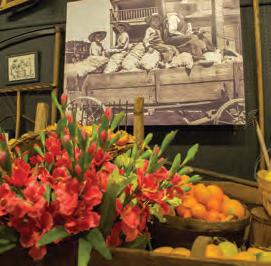



GulfShores.com OrangeBeach.com 888-666-9252 ...like
AMHP-221101-005 Gulf Shores.indd 1 9/22/22 12:13 PM
It’s been more than 100 years since the last Morgan Silver Dollar was struck for circulation. Morgans were the preferred currency of cowboys, ranchers and outlaws and earned a reputation as the coin that helped build the Wild West. Struck in 90% silver from 1878 to 1904, then again in 1921, these silver dollars came to be known by the name of their designer, George T. Morgan. They are one of the most revered, most-collected, vintage U.S. Silver Dollars ever.
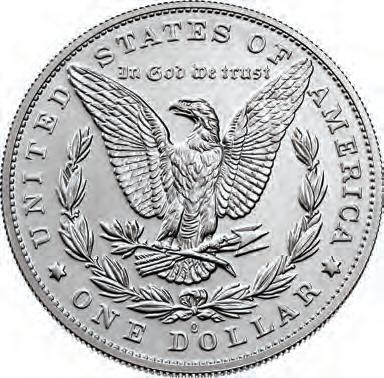

Celebrating the 100th Anniversary with Legal-Tender Morgans
Honoring the 100th anniversary of the last year they were minted, the U.S. Mint struck five different versions of the Morgan in 2021, paying tribute to each of the mints that struck the coin. The coins here honor the historic New Orleans Mint, a U.S. Mint branch from 1838–1861 and again from 1879–1909. These coins, featuring an “O” privy mark, a small differentiating mark, were struck in Philadelphia since the New Orleans Mint no longer exists. These beautiful


coins are different than the originals because they’re struck in 99.9% fine silver instead of 90% silver/10% copper, and they were struck using modern technology, serving to enhance the details of the iconic design.







Very Limited. Sold Out at the Mint!
The U.S. Mint limited the production of these gorgeous coins to just 175,000, a ridiculously low number. Not surprisingly, they sold out almost instantly! That means you need to hurry to add these bright, shiny, new legal-tender Morgan Silver Dollars with the New Orleans privy mark, struck in 99.9% PURE Silver, to your collection. Call 1-888-395-3219 to secure yours now. PLUS, you’ll receive a BONUS American Collectors Pack, valued at $25, FREE with your order. Call now. These will not last!
FREE SHIPPING! Limited time only. Standard domestic













only. Not valid











shipping
on previous purchases. GovMint.com® is a retail distributor of coin and currency issues and is not affiliated with the U.S. government. The collectible coin market is unregulated, highly speculative and involves risk. GovMint.com reserves the right to decline to consummate any sale, within its discretion, including due to pricing errors. Prices, facts, figures and populations deemed accurate as of the date of publication but may change significantly over time. All purchases are expressly conditioned upon your acceptance of GovMint.com’s Terms and Conditions (www.govmint.com/terms-conditions or call 1-800-721-0320); to decline, return your purchase pursuant to GovMint.com’s Return Policy. © 2022 GovMint.com. All rights reserved. SPECIAL CALL-IN ONLY OFFER The U.S. Mint Just Struck Morgan Silver Dollars for the First Time in 100 Years! O PRIVY MARK GovMint.com • 1300 Corporate Center Curve, Dept. NSD269-02, Eagan, MN 55121 1-888-395-3219 Offer Code NSD269-02 Please mention this code when you call. Struck in 99.9% Fine Silver! For the First Time EVER! First Legal-Tender Morgans in a Century! VERY LIMITED! Sold Out at the Mint! A+ To learn more, call now. First call, first served! AMHP-221101-013 GovMint 2021 Morgan Silver Dollar.indd 1 9/22/22 12:11 PM
 58 Walter White parlayed brash confidence and light skin tone into years of exposing the American plague of lynching.
58 Walter White parlayed brash confidence and light skin tone into years of exposing the American plague of lynching.
AMHP-230100-CONTENTS.indd 2 9/26/22 10:12 AM
Daniel de Visé
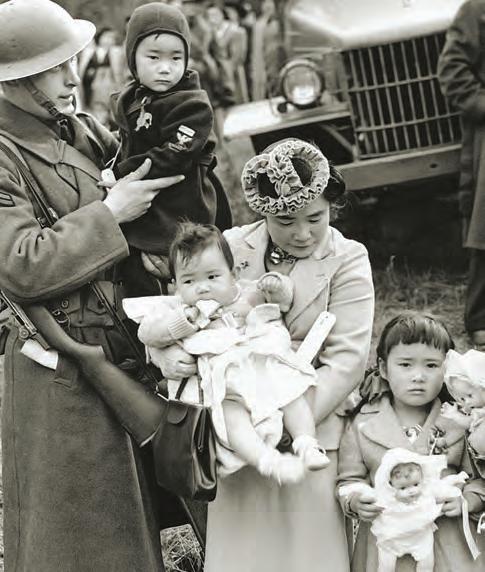

 By J.
By J.
Zahniser

WINTER 2023 3 FEATURES 24 Becoming B.B. Once upon a time a young bluesman put his trust in ambition and was rewarded mightily. By
32 Days of Infamy Japan's surprise attack on the U.S. Navy base at Pearl Harbor triggered a profoundly shameful episode.
D.
40 Picture Imperfect With photographer Ansel Adams at the Manzanar, California, detention center. By Richard J. Goodrich 50 L ighting Out for the Territory Everyone remembers Lewis and Clark but those worthies had a lot of company when it came to exploring Louisiana. By Mike Coppock 58 White Power R isking his life, NAACP undercover investigator Walter White brought illumination to murderous racist violence. By Peter Carlson Winter 2023 50 14 32 DEPARTMENTS 6 Mosaic History in today’s headlines 12 Contributors 14 A merican Schemers The flimflam man who conned Nazi bigwigs into buying junk. 16 Déjà Vu Temperament and temper help leaders make their cases. 20 SCOTUS 101 Invidious as speech may be, it isn't necessarily illegal. 22 Cameo Photographic innovator Robert Cornelius invented the selfie. 66 Reviews 72 A n American Place Taos, New Mexico, was historic when the country was young. ON THE COVER: The whole world came to address him by a euphonious pair of invented initials, but in his scuffling days folks knew him as Riley B. King.CLOCKWISE FROM LEFT: NATIONAL PORTRAIT GALLERY; AP PHOTO; GL ARCHIVE/ALAMY STOCK PHOTO; LOS ANGELES TIMES PHOTOGRAPHIC ARCHIVE, LIBRARY SPECIAL COLLECTIONS, CHARLES E. YOUNG RESEARCH LIBRARY, UCLA; BONANZAS; COVER: HULTON ARCHIVE/GETTY IMAGES Bob Dylan's one-off rerecording of his song "Blowin' in the Wind" sold for more than $1.7 million. —see page 10 AMHP-230100-CONTENTS.indd 3 9/26/22 10:12 AM
WINTER
MICHAEL DOLAN EDITOR
SARAH RICHARDSON SENIOR EDITOR
BRIAN WALKER GROUP DESIGN DIRECTOR
MELISSA A. WINN DIRECTOR OF PHOTOGRAPHY JON C. BOCK ART DIRECTOR
DANA B. SHOAF MANAGING EDITOR, PRINT MICHAEL Y. PARK MANAGING EDITOR, DIGITAL CLAIRE BARRETT NEWS AND SOCIAL EDITOR
CORPORATE
KELLY FACER SVP REVENUE




MATT GROSS VP DIGITAL INITIATIVES ROB WILKINS DIRECTOR OF PARTNERSHIP MARKETING JAMIE ELLIOTT PRODUCTION DIRECTOR
MORTON GREENBERG SVP


TERRY JENKINS

HULTON ARCHIVE/GETTY IMAGES
MICHAEL
A. REINSTEIN CHAIRMAN & PUBLISHER
2023 VOL. 57, NO. 4
OPERATIONS
ADVERTISING
Advertising Sales mgreenberg@mco.com
Regional Sales Manager tjenkins@historynet.com DIRECT RESPONSE ADVERTISING NANCY FORMAN / MEDIA PEOPLE nforman@mediapeople.com SUBSCRIPTION INFORMATION: SHOP.HISTORYNET.COM or 800-435-0715 American History (ISSN 1076-8866) is published quarterly by HistoryNet, LLC, 901 North Glebe Road, Fifth Floor, Arlington, VA 22203 Periodical postage paid at Vienna, VA and additional mailing offices. POSTMASTER, send address changes to American History, P.O. Box 900, Lincolnshire, IL 60069-0900 List Rental Inquiries: Belkys Reyes, Lake Group Media, Inc. 914-925-2406; belkys.reyes@lakegroupmedia.com Canada Publications Mail Agreement No. 41342519, Canadian GST No. 821371408RT0001 © 2022 HistoryNet, LLC The contents of this magazine may not be reproduced in whole or in part without the written consent of HistoryNet LLC. PROUDLY MADE IN THE USA Sign up for our FREE weekly e-newsletter at historynet.com/newsletters HISTORYNET VISIT HISTORYNET.COM PLUS! Today in History What happened today, yesterday or any day you care to search. Daily Quiz Test your historical acumen every day! What If? Consider the fallout of historical events had they gone the ‘other’ way. Weapons & Gear The gadgetry of war—new and old, effective and not so effective. Charles Hardin "Buddy" Holly, dead at 22 in 1959, is only one of many entries on the long roster of popular musicians who came to grief while traveling between gigs by airplane. Historynet.com/musicians-who-died Days & Nights the Music Died TRENDING NOW AMHP-230100-MASTONLINE.indd 4 9/26/22 10:20 AM
to the Bone
The very best hunting knives possess a perfect balance of form and function. They’re carefully constructed from fine materials, but also have that little something extra to connect the owner with nature.

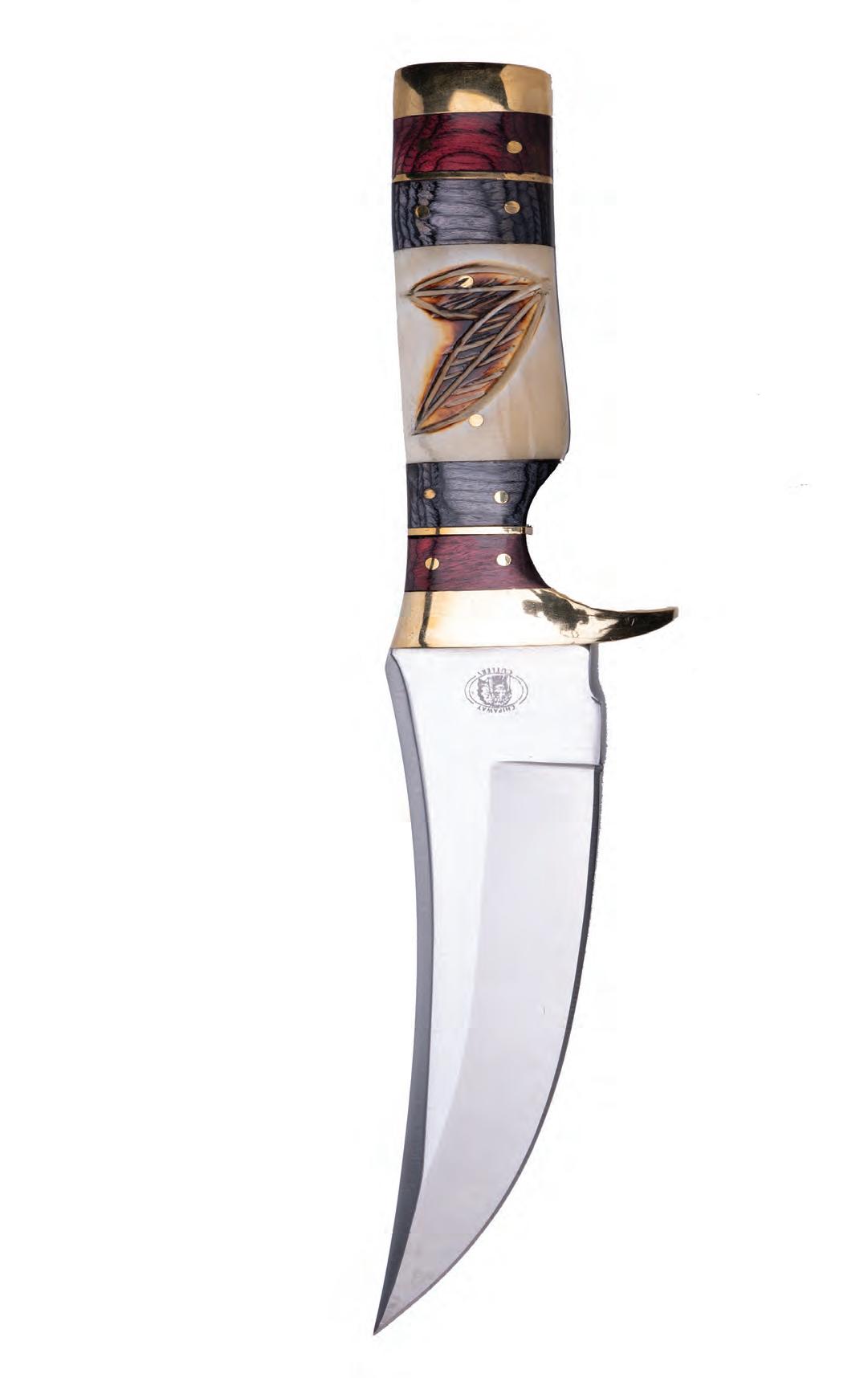
If you’re on the hunt for a knife that combines impeccable craftsmanship with a sense of wonder, the $79 Huntsman Blade is the trophy you’re looking for.
The blade is full tang, meaning it doesn’t stop at the handle but extends to the length of the grip for the ultimate in strength. The blade is made from 420 surgical steel, famed for its sharpness and its resistance to corrosion.
The handle is made from genuine natural bone, and features decorative wood spacers and a hand-carved motif of two overlapping feathers— a reminder for you to respect and connect with the natural world.
This fusion of substance and style can garner a high price tag out in the marketplace. In fact, we found full tang, stainless steel blades with bone handles in excess of $2,000. Well, that won’t cut it around here. We have mastered the hunt for the best deal, and in turn pass the spoils on to our customers.
But we don’t stop there. While supplies last, we’ll include a pair of $99 8x21 power compact binoculars and a genuine leather sheath FREE when you purchase the Huntsman Blade

Your satisfaction is 100% guaranteed. Feel the knife in your hands, wear it on your hip, inspect the impeccable craftsmanship. If you don’t feel like
a fair deal, send it back within 30 days
a complete
Limited Reserves. A deal like this
last long. We have only 1120
of


let this beauty
for this ad only.

through
fingers. Call
we cut you
for
refund
the item price.
won’t
Huntsman Blades
Don’t
slip
your
today! Stauer… Afford the Extraordinary ® Full tang stainless steel blade with natural bone handle —now ONLY $79! BONUS! Call today and you’ll also receive this genuine leather sheath! Not shown actual size. 14101 Southcross Drive W., Ste 155, Dept. HUK834-01 Burnsville, Minnesota 55337 www.stauer.comStauer ® *Discount is only for customers who use the offer code versus the listed original Stauer.com price. California residents please call 1-800-333-2045 regarding Proposition 65 regulations before purchasing this product. Rating of A+ Bad
EXCLUSIVE FREE Stauer® 8x21 Compact Binoculars -a $99 valuewith purchase of Huntsman Blade Huntsman Blade $249* Offer Code Price Only $79 + S&P Save $170 1-800-333-2045 Your Insider Offer Code: HUK834-01 You must use the insider offer code to get our special price. •12" overall length; 6 ¹⁄2" stainless steel full tang blade • Genuine bone handle with brass hand guard & bolsters • Includes genuine leather sheath What Stauer Clients Are Saying About Our Knives êêêêê “This knife is beautiful!” — J., La Crescent, MN êêêêê “The feel of this knife is unbelievable...this is an incredibly fine instrument.” — H., Arvada, CO AMHP-221101-011 Stauer Huntsman's Blade.indd 1 9/22/22 12:29 PM
Flood Trashes Historic School
 by Sarah Richardson
by Sarah Richardson
Mosaic
Among horrific effects of flooding in Kentucky on July 27-28, 2022, was havoc wreaked upon Hindman Settlement School in Hindman in eastern Kentucky. Troublesome Creek breached its banks, breaking open the facility’s new steel doors and flooding several buildings, some housing the institution’s archive of artifacts, photos, books, and documents. Founded with funds from the Kentucky Women’s Christian Temperance Union by educators May Stone and Katherine Pettit in 1902 as a resource for the “people of the moun tains,” Hindman pioneered in education, community services, and cultural preser vation in central Appalachia. Staff rescued what they could, hanging photos to line-dry and stowing other items in freezers until their condition can be evaluated. The flooding exceeded any previous events, exacerbated by climate change and a mountaintop removal method that has simplified mining but eradicated vegeta tion that slows runoff. To donate to Hindman’s flood relief, visit hindman.org.
During and After the Deluge
A surging creek at the Hindman School complex led to inundation, above, that penetrated and soaked archives and classrooms, inset.

COURTESY OF
LYMAN
ALLYN
ART MUSEUM; AP
PHOTO/MATT ROURKE
COURTESY OF HINDMAN SETTLEMENT SCHOOL
AMERICAN HISTORY6 AMHP-230100-MOSAIC.indd 6 9/28/22 4:21 PM
Historic Banjos on Display
Lyman Allyn Art Museum in New London, Connecticut, is exhibiting 50 banjos dating from 1840 to about 1900 from Jim Bollman’s 100-plus banjo collection.
Starting at 13 trading Dinky Toys for an English zither banjo, Bollman became fascinated with the evolution of the instrument, which is related to the banjar, a gourd-bodied West Afrian lute. Enslaved Africans fashioned versions in the New World, and over time its construction changed, resulting in a louder instrument more suited for performances in minstrel shows, and later, country music. “As a collector I love showing off the evolution of the banjo aesthetically by the most skilled makers in the 19th century,” Bollman said. “The best of the early minstrel ante-bellum banjos have a wonderful folk art quality showing the artisanship of the various makers.” Starting in the mid-1800s, small factories handled much banjo manufacturing but visual aesthetics also figured. S.S. Stewart of Philadelphia, the Dobson family of New York and Boston, and other entrepreneurs recast the rough-and-tumble musical tool into a finely finished, often lavishly decorated artifact to grace Victorian parlors and concert halls. Makers enlisted the era’s high style furniture producers to source elaborate marquetry veneers to doll up banjos, boosting prices, attracting women musi cians, and making the banjo respectable. By the 1890s such ateliers as Cole and Fairbanks in Boston were producing exquisite banjos bedizened with engraved shells, carved necks, and intricately worked metal parts, selling for hundreds of dollars. So-called “presentation” banjos, meant only for show, afforded instru ment makers occasions for touting in advertisements honors conferred at fairs and exhibitions. The collection is on view until January 8, 2023. lymanallyn.org
Fancy Picking An instrument from the display shows how far banjo makers could take design.

The U.S. Military Academy and U.S. Naval Academy will remove physical references to the Confederacy. A federal commission assigned to identify Confederate symbols at the acade mies reported to Congress in August 2022. The panel urged renaming sites at West Point, including a barracks, a street, and a gate named for Robert E. Lee. Ditto for Naval Academy buildings named for officers who resigned federal commissions to serve the Confederacy, Franklin Buchanan as an admiral and Matthew Maury as a ship procurer. The panel noted that West Point resisted such gestures until 1930-31, when, with “Lost Cause” sentiment high, policy changed. drive.google.com/file/d/19nhxKfBungsgL1d157vjDUdAlk4V-8g8/view
Red Hook Remains
On June 26, 2022, archaeologists at the site of the Battle of Red Bank in National Park, New Jersey, found a human femur. The thighbone upended expectations for the dig, left, accord ing to The New York Times. Excavating a trench at Fort Mercer, where Continental sol diers held off Hessian mercenaries, the team expected to find a midden of 18th century rubbish but uncovered the skulls of 14 Hes sian soldiers bearing graphic reminders of the October 22, 1777, fight. Some 500 Continental soldiers, helped by gunners aboard Pennsyl vania warships on the Delaware River, with stood an assault by more than 2,000 Hessians. The 75-minute battle left 377 Hessian fatali ties but only 14 American dead. The research ers hope analysis of the remains deepens understanding of the battle and perhaps leads to identification of the soldiers whose remains were found.

COURTESY OF LYMAN ALLYN ART MUSEUM; AP PHOTO/MATT ROURKE COURTESY OF HINDMAN SETTLEMENT SCHOOL
Confederate Memorials No More WINTER 2023 7 AMHP-230100-MOSAIC.indd 7 9/26/22 10:28 AM
DNA at Assateague

Statuary Update
With two installations, summer 2022 raised the count of women representing U.S. states in the Capitol’s Statuary Hall to 11. On July 13, 2022, a statue of Florid ian Mary McLeod Bethune, left, born in 1875 to parents who had been enslaved, replaced one of Confederate general Edmund Kirby Smith dating to 1922. An educator who founded Daytona Beach’s Bethune-Cookman Uni versity, Bethune was a lifelong advocate for the rights of Blacks and women; her statue is the Hall’s first state-commissioned figure of a Black. On July 27, a statue of Kentucky-born aviator Amelia Earhart replaced one of Kansas abolitionist, judge, and senator John James Ingalls, who coined the Kansas motto “Ad Astra per Aspera” (“To the stars through adversity”). Earhart not only became the first female aviator to fly across the Atlantic but was also the first person to fly solo from mainland Ameri can to Hawaii.

Mammoth Clues
A decade ago, Tim Rowe, a paleontologist with the University of Texas at Austin, got curious about bones on property he owns in New Mexico. Rowe’s interest led to a study. The results found that the bones, above, were from a mammoth butchered by people 37,000 years ago. Distinctive chipping and puncture marks made the case. The conclusion establishes the presence of humans in North America far earlier than conventionally assumed. “What we’ve got is amazing,” said lead author Rowe, a professor at the UT Jackson School of Geosciences. “It’s not a charismatic site with a beautiful skeleton laid out on its side. It’s all busted up. But that’s what the story is.”
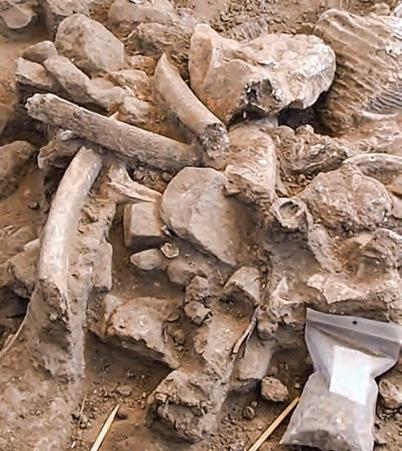

GETTY IMAGES; ARCHITECT OF THE CAPITOL; TIMOTHY ROWE/UNIVERSITY OF TEXAS
Cattle genetics are redefining the ancestry of wild horses, above, on Assateague Island in Chesapeake Bay. The animals were thought to descend from English stock from the colonial mainland or Spanish horses loosed from a 16th-century galleon, but no one knew for sure. A researcher analyzing a tooth labeled as being from a cow in a collection of early Caribbean finds realized the tooth had come from a horse on the island of Hispaniola. Comparing that DNA to material from other horse lineages, he found the closest match to be the Assateague herd, supporting the Spanish thesis.
AMERICAN HISTORY8 AMHP-230100-MOSAIC.indd 8 9/26/22 10:29 AM


LIMITED-TIME OFFER—ORDER NOW Uniquely Designed. Exclusively Yours. ©2022 The Bradford Exchange 01-30578-001-BICI B_I_V = Live Area: 7 x 9.75, 1 Page, Installment, Vertical Price Logo Address Job Code Tracking Code Yellow Snipe Shipping Service Signature Mrs. Mr. Ms. Name (Please Print Clearly) Address City State Zip E-mail PRIORITY RESERVATION SEND NO MONEY NOWWhere Passion Becomes Art The Bradford Exchange P.O. Box 806, Morton Grove, IL 60053-0806 Connect with Us! 01-25530-001-E35507 *Plus $16.00 shipping and service. Please allow 4-6 weeks for delivery of your jewelry after we receive your initial deposit. Sales subject to product availability and order acceptance. For Distinguished Service... To Wear with Pride Steadfast in their values, the soldiers of the United States Army—whether active or retired from service—have dedicated their lives to the noble tradition of serving their country and preserving freedom worldwide. Now, you can show your allegiance to the enduring, steadfast spirit of the United States Army like never before, with a new limited-edition jewelry exclusive as distinctive as the soldiers that it salutes. A Singular Achievement in Craftsmanship and Design Our “This We’ll Defend” U.S. Army® Tribute Ring is is individually crafted in solid sterling silver with gleaming 18K gold plating and features the Army emblem in raised relief standing out against a custom-cut genuine black onyx center stone. The contrast of silver and gold is continued in the prongs holding the onyx stone, and in the rope border that surrounds the central emblem as well as the sculpted eagle—a symbol of strength and freedom—on each side. Adding to the meaning and value, the ring is engraved inside the band with: This We’ll Defend and United States Army. Order online at bradfordexchange.com/25530 ®Official Licensed Product of the U.S. Army. By federal law, licensing fees paid to the U.S. Army for use of its trademarks provide support to the Army Trademark Licensing Program, and net licensing revenue is devoted to U.S. Army Morale, Welfare, and Recreation programs. U.S. Army name, trademarks and logos are protected under federal law and used under license by The Bradford Exchange. ©2022 The Bradford Exchange All rights reserved 01-25530-001-BI A Custom Jewelry Exclusive Available Only from The Bradford Exchange Limited-Time Offer...Order Now! A magnificent statement of everything the Army stands for, the “This We’ll Defend” U.S. Army® Tribute Ring comes in a deluxe wood presentation case with a plaque engraved with the same words that are on the ring, and includes a Certificate of Authenticity that attests to the ring’s original design in an edition limited to only 5,000 rings. An exceptional value at $279.99*, you can pay for your ring in 6 easy installments of $46.67. To reserve yours, backed by our unconditional 120 day guarantee, send no money now. Just mail the Priority Reservation. But hurry... this edition is strictly limited! Expertly hand-crafted in solid sterling silver Gleaming with rich 18K gold plating Featuring a custom-cut genuine black onyx center stone Engraved with the motto of the United States Army® YES. Please reserve the “This We’ll Defend” U.S. Army® Tribute Ring for me as described in this announcement in the size indicated. LIMITED-TIME OFFER Reservations will be accepted on a first‑come‑first‑served basis Respond as soon as possible to reserve your ring. SATISFACTION GUARANTEED To assure a proper fit, a ring sizer will be sent to you after your reservation has been accepted. Actual SIze Ring size (If known) ______ U.S. ARMY® TRIBUTE RING AMHP-221101-009 Bradford US Army Men's Dress Defend.indd 1 9/22/22 12:10 PM
The African American Cultural Heritage Action Fund has announced 33 awards totaling $3 million for 2022. Among recipi ents of preservation grants are the South Side Chicago home of Mamie Till, the courageous mother who brought the nation’s atten tion to the lynching of her 14-year-old son Emmett Till in Missis sippi in 1955; the Jackson, Mississippi, home of civil rights activist Medgar Evers in whose driveway Evers was assassinated in 1963; the Queens, New York, home of musical innovator Louis Armstrong; the Great Barrington, Massachusetts, writing cabin of author and activist James Weldon Johnson; and the store at Whitney Plantation in Wallace, Louisiana, where the lives of the enslaved are depicted and commemorated.
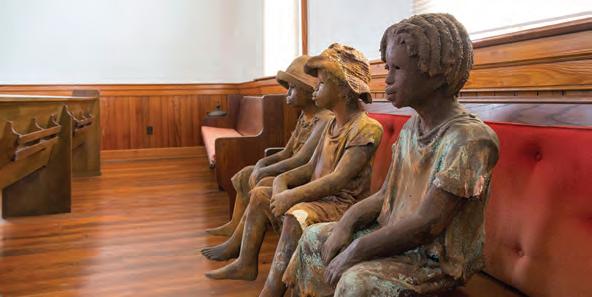

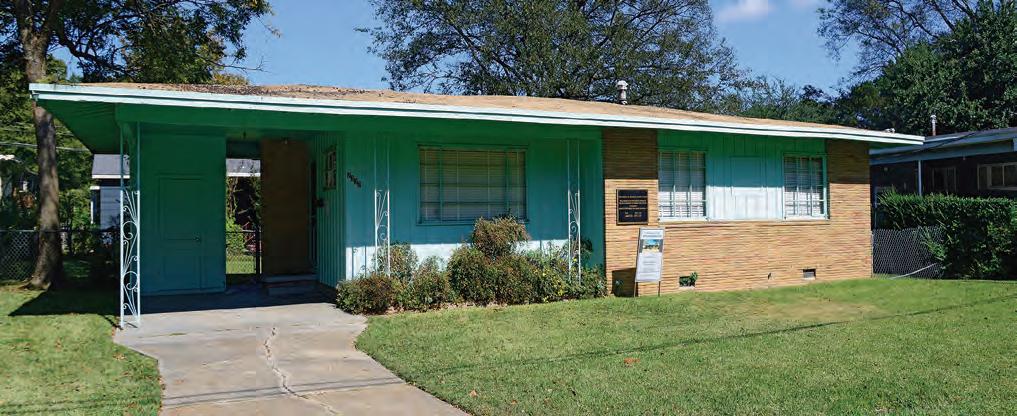
Black History Preserved
A new studio recording, left, of Bob Dylan performing his 1962 song “Blowin’ in the Wind” sold for $1,769,508 at Christies in London on July 7, 2022. Dylan performed his song at Gerde’s Folk City in Greenwich Village in April 1962 and recorded it that July 9 for his second LP. This release was recorded by producer T-Bone Burnett on Burnett’s Ionic Original label. Only one copy of the recording was made.

AGEFOTOSTOCK/ALAMY STOCK PHOTO; RYAN VICTOR/ALAMY STOCK PHOTO; JIM WEST/ALAMY STOCK PHOTO; COURTESY OF CHRISTIE’S AUCTIONS
TOP BID Unique $1,769,508
Whitney Plantation
Evers
home AMERICAN HISTORY10 AMHP-230100-MOSAIC.indd 10 9/26/22 10:29 AM
On May 18, 1980, the once-slumbering Mount St. Helens erupted in the Pacific Northwest. It was the most impressive display of nature’s power in North America’s recorded history. But even more impressive is what emerged from the chaos... a spectacular new creation born of ancient minerals named Helenite. Its lush, vivid color and amazing story instantly captured the attention of jewelry connoisseurs worldwide. You can now have four carats of the world’s newest stone for an absolutely unbelievable price.
Known as America’s emerald, Helenite makes it possible to give her a stone that’s brighter and has more fire than any emerald without paying the exorbitant price. In fact, this many carats of an emerald that looks this perfect and glows this green would cost you upwards of $80,000. Your more beautiful and much more affordable option features a perfect teardrop of Helenite set in gold-covered sterling silver suspended from a chain accented with even more verdant Helenite.

Limited Reserves. As one of the largest gemstone dealers in the world, we buy more carats of Helenite than anyone, which lets us give you a great price. However, this much gorgeous green for this price won’t last long. Don’t miss out. Helenite is only found in one section of Washington State, so call today!



Romance guaranteed or your money back. Experience the scintillating beauty of the Helenite Teardrop Necklace for 30 days and if she isn’t completely in love with it send it back for a full refund of the item price. You can even keep the stud earrings as our thank you for giving us a try.

Stauer… Afford the Extraordinary . ®
• 4 ¼ ctw of American Helenite and lab-created DiamondAura® • Gold-finished .925 sterling silver settings • 16" chain with 2" extender and lobster clasp Rating of A+ 14101 Southcross Drive W., Ste 155, Dept. HEN433-01, Burnsville, Minnesota 55337 www.stauer.comStauer ® * Special price only for customers using the offer code versus the price on Stauer.com without your offer code. Helenite Teardrop Necklace (4 ¼ ctw) $299* .....Only $129 +S&P Helenite Stud Earrings (1 ctw) ....................................... $129 +S&P Helenite Set (5 ¼ ctw) $428* ...... Call-in price only $129 +S&P (Set includes necklace and stud earrings) Call now and mention the offer code to receive FREE earrings. 1-800-333-2045 Offer Code HEN433-01 You must use the offer code to get our special price. Uniquely American stone ignites romance Tears From a Volcano Necklace enlarged to show luxurious color EXCLUSIVE FREE Helenite Earrings -a $129 valuewith purchase of Helenite Necklace 4 carats of shimmering Helenite Limited to the first 1600 orders from this ad only “I love these pieces... it just glowed... so beautiful!” — S.S., Salem, OR AMHP-221101-010 Stauer Helenite Teardrop Necklace.indd 1 9/22/22 12:28 PM
Peter Carlson is a longstanding stalwart of the magazine who besides features such as “White Power” (p. 58) writes American Schemers.
Mike Coppock (“Jefferson’s Other Expeditions,” p. 50) is a regular contributor who most recently delivered “Bear Wars” (June 2022).
Contributors

Pulitzer Prize-winning journalist Daniel de Visé has written four books. His latest, King of the Blues: The Rise and Reign of BB King, is excerpted in this issue (“Becoming B.B.,” p. 24). His 2015 book Andy & Don, the source for “Sheriff Tay lor Hires a Deputy” (August 2016)), is in its 11th paperback printing. The Comeback, de Vise’s 2018 profile of Greg Lemond, inspired Congress to award the bicyclist its highest civilian honor, the Congressional Gold Medal.

Former history professor Richard J. Goodrich (“Picture Imperfect,” p. 40) is author of Comet Madness: How the 1910 Return of Halley’s Comet (Almost) Destroyed Civilization. His most recent article was “Slaves at Sea” (February 2022). Find him at richardjgoodrich.com.




J.D. Zahniser (“Days of Infamy,” p. 32) speaks and writes regularly about women’s history; she wrote the 2014 biography Alice Paul: Claim ing Power. Her most recent American History article was “Becoming Jane Crow” (August 2022). She lives in St. Paul, Minnesota.

Read On!
Out of the Picture
Letters
Buffalo’s Great Northern grain elevator stands to the right of the structure shown in the June 2022 issue. Here are a couple of images of the actual building—one show ing damage to an end wall from a December 2021 windstorm and a photo of the elevator and the water front in 1905.

 Paul Fronckowiak Buffalo, New York
Paul Fronckowiak Buffalo, New York
The editor regrets his error.
So Long, Uncle Joe!
Thanks for running Albert Schmidt’s “Cold War Chronicle” (June 2022). I particularly enjoyed the passage, “…In the morning Stalin was nowhere to be seen. Had our ado over the statue has tened the de-Stalinization in Stalin’s hometown?” I love the thought, and the interesting format, an article derived from the author’s journal entries and letters to his spouse. If only we could travel in a similar way today and assimilate other cultures.
Byron Loubert Bethesda, Maryland
American History readers wanting to pillory, praise, or query the publication: write to mdolan@historynet.com.
CarlsonGoodrich
Coppock
Zahniser
de Visé
AMERICAN HISTORY12 AMHP-230100-LETTERS.indd 12 9/26/22 10:17 AM
We’re Bringing Flexy Back
a
is cyclical. And there’s a certain wristwatch trend that was huge in the 1960s and then again in the 1980s, and is ready for its third time in the spotlight. We’re talking, of course, about the flexible stretch watch band.



To purchase a vintage 60s or 80s classic flex watch would stretch anyone’s budget, but you can get ahead of the crowd and secure a brand new version for a much lower price.
We’re rolling back the years AND the numbers by pricing the Stauer Flex like this, so you can put some bend in your band without making a dent in your wallet.
The Stauer Flex combines 1960s vintage cool with 1980s boardroom style. The stainless steel flex band ensures minimal fuss and the sleek midnight blue face keeps you on track with date and day subdials.
Your satisfaction is 100% guaranteed.


the Stauer Flex for 30 days. If you’re not convinced you got excellence for less, send it back for a refund of the item price. Your satisfaction is our top priority.

Time is running out. As our top selling watch, we can’t guarantee the Flex will stick around long. Don’t overpay to be underwhelmed.
a




Looks

•Precision movement • Stainless steel crown, caseback & bracelet •Date window at 6 o’clock; day window at 10 o’clock • Water resistant to 3 ATM • Stretches to fit wrists up to 8 ½" Stauer… Afford the Extraordinary .® Just like
good wristwatch movement, fashion
Experience
Flex your right to put
precision timepiece on your wrist for just $79. Call today! 14101 Southcross Drive W., Ste 155, Dept. FMW202-01 Burnsville, Minnesota 55337 www.stauer.com Stauer Flex Men’s Watch $299† Offer Code Price $79 + S&P Save $220 You must use the offer code to get our special price. 1-800-333-2045 Your Offer Code: FMW202-01 Please use this code when you order to receive your discount. Rating of A+ Stauer ® † Special price only for customers using the offer code versus the price on Stauer.com without your offer code. TAKE 74% OFF INSTANTLY! When you use your OFFER CODE êêêêê “The quality of their watches is equal to many that can go for ten times the price or more.” — Jeff from McKinney, TX
The Stauer Flex gives you vintage style with a throwback price of only $79. Flexible Stretch Watch Bracelets in the News: “The bracelets are comfortable, they last forever, and they exhibit just the right balance of simplicity and over-engineering” – Bloomberg.com, 2017 e
of a Classic Flex Band Watch for only $79! AMHP-221101-012 Stauer Flex Men's Watch.indd 1 9/22/22 12:27 PM
Hoodwinking Hitler
by Peter Carlson
American Schemers
ON FEBRUARY 18, 1937, Freeman Bernstein eased his pudgy 63-yearold body out of the back seat of a rented limousine at the Hollywood home of actress Mae West. Thirty years earlier, Bernstein had been West’s agent, booking her in vaudeville shows. Now he was hawking jew els he’d smuggled from China. A tough customer, West bought some rubies and sapphires but rejected the cheap zircon that Bernstein tried to pass off as a dia mond. Then she autographed a picture for her guest, writing “To Freeman Bernstein, who was my first agent at the age of 10.”
Bernstein took West’s check and the picture and instructed his chauf feur to drive him to the Brown Derby restaurant. On the way officers of the Los Angeles Police Department stopped the limo and arrested Bern stein: He was wanted in New York for swindling the German govern ment out of nearly $150,000 by selling the Nazis a load of what was supposed to be valuable nickel but which turned out to be scrap metal.

“Adolf Hitler was on bended knee begging me to help him get some
nickel,” Bernstein told reporters the next morn ing. “Hitler got just exactly what he paid for in that deal—scrap steel and nickel—and I’ll prove it.”
The tale of an American accused of swindling Hitler made news nationwide and inspired a cringe-worthy Wisconsin State Journal headline: “Jew Denies Gyping Hitler in Junk Deal.”
Actually, Bernstein did bilk Hitler—or at least the Führer’s government—but that wasn’t sur prising. He’d been flimflamming suckers on sev eral continents for decades. Bernstein was a carny, a card sharp, a con man, a shady showbiz promoter, and a racehorse owner so crooked he was banned from tracks in Canada, Mexico, and Austria. But he was charming and persuasive and he convinced countless dupes to invest in his
COURTESY NYC MUNICIPAL ARCHIVES LOS ANGELES TIMES PHOTOGRAPHIC ARCHIVE, LIBRARY SPECIAL COLLECTIONS, CHARLES E. YOUNG RESEARCH LIBRARY, UCLA
AMERICAN HISTORY14
Familiar Setting Bernstein, seated, in a New York court in 1938 with lawyer Greg Bautzer to answer charges of kiting checks.
AMHP-230100-SCHEMERS.indd 14 9/26/22 10:35 AM
dubious schemes. “Even when fleecing the gullible, he did it with such infectious high spirits that he believed the marks didn’t really mind,” Walter Shapiro wrote in Hustling Hit ler, his wry 2016 biography of the grifter.
Freeman Bernstein was born in 1873 in Troy, New York, son of Polish immigrants. He quit school after fifth grade and at 13 experi enced the first of many arrests, for stealing $10 from the pocket of a man who’d doffed his clothes to swim in the Hudson River. Bern stein drifted into the carnival business, receiv ing a valuable education in the art of the grift. By the early 1900s, he was a low-rent impresa rio, booking vaudeville acts in the boonies. The troupes he hyped as “The Greatest Aggre gation of Vaudeville Talent Ever Brought Together” consisted mainly of has-beens, wannabes, and goofy novelty acts—a one-legged acrobat, a dwarf comedy team, and “the white man who sings coon songs.”
When a performance failed to draw a crowd, Bernstein would grab the box office receipts and flee on the next train, leaving his performers stiffed and stranded. In 1912, he took a 45-mem ber opera cast to Puerto Rico; when the show failed to attract audiences, he skedaddled. “He’s left stranded troupes all over the world,” the edi tor of Variety, the showbiz newspaper, lamented.
In 1915, inspired by the huge success of the movie Birth of a Nation, Bernstein created a film company, found impressionable investors, and produced two movies, both starring his wife, singer May Ward. When the first, a Revolutionary War drama entitled A Continental Girl, tanked, Bernstein made his second movie steamier. In Virtue, Ward played an innocent farm girl lured into sexual slavery. Bernstein billed the film “the Most Striking, Realistic and Sensational Film Ever Presented.” Alerted, censors in Philadelphia and New York banned Virtue. Bernstein recouped his losses when a mysterious fire incinerated his movie studio, which he’d presciently insured. He showed a Variety reporter the policy, saying, “See, I told you there was money in pictures.”
Ah, so many Freeman Bernstein scams, so lit tle space:
During World War I, he set up carnivals out side army bases and took doughboys’ dough with rigged games.
In 1929, Bernstein—rebranding himself “Roger O’Ryan”—staged a week-long Irish Fair in the Boston Garden, advertising “SOD FROM EVERY COUNTY IN IRELAND…HUNDREDS OF IRISH COLLEENS.” The sod was grown in Massachu setts and the colleens were local showgirls. On the fair’s final day, Bernstein took the money and ran, leaving employees unpaid. “OWNER OF IRISH

FAIR MISSING,” screamed the Boston Her ald’s front page. “COLLEENS CLAMOR FOR WAGES.” Soon, Bernstein—dubbed “Mr. O’Ry anstein” by the Herald—was wanted for fraud.
Big Bogus Deal
Dockside in 1936 at Hamburg, Germany, the notorious “nickel” shipment awaits its purchasers, who dropped $150,000 to acquire a load of Canadian scrap.

Any time cops and creditors closed in, Ber nstein took to the sea, sailing to Europe or Asia, earning cash en route by skinning fellow first-class passengers in high-stakes card games. Upon docking, he’d search for and frequently find rubes dying to be separated from their lucre. “A guy like me should travel,” he wrote in a letter from London. “There are so many saps around, I don’t know which one to tap first.”
Bernstein spent much of the 1930s in China, calling himself “The Jade King” and selling precious stones—and dubious facsimiles—to tourists. Occasionally, he’d smuggle jade into the U.S. by feeding the jewels to Benny, his Sealyham terrier, shortly before he and the pooch strolled through cus toms, retrieving the stones when Benny relieved himself.
Bernstein was in Shanghai in 1934 when he conceived his notorious nick el-to-Nazis scam. He met a German diplomat who said his government was looking to buy large quantities of nickel, needed to make weapons. Bern stein claimed to have a nickel connection in Canada, which produced most of the world’s supply but had barred the metal’s export to Germany. The diplomat suggested Bernstein meet an official at the German embassy in Washington. In 1935, Bernstein visited the fellow, bringing samples of highgrade nickel he’d bought at a shop in Manhattan. Impressed, the bureaucrat dispatched Bernstein and his samples to the Fatherland, where Nazis gave him $1,000 as a down payment on an order of 225 tons.
Setting his trap, Bernstein told his customers that, to avoid the embargo, the shipment would come labeled “scrap metal.” Then he found a crooked Canadian junkman. Together, the pair gathered 225 tons of scrap and a smidgeon of nickel, bribed an inspector to certify that the load was 99 per cent nickel, and shipped it all to Germany, collecting nearly $150,000. It was, biographer Shapiro wrote, “the grandest racket of his career.”
Fearing the inevitable indictment, Bernstein fled to China but when he returned to Los Angeles in 1937 to sell jewels, the cops nabbed him. He spent seven weeks in jail then went free on bail. After years of legal wran gling, the charges were dropped in June 1941.
Seven months later, Bernstein was on his way to meet with a Hollywood producer when he suffered a fatal heart attack.
“When I die,” he’d bragged years earlier, “no matter where I go, you can gamble that I will pick up a little coin on the jump.” H
COURTESY NYC MUNICIPAL ARCHIVES LOS ANGELES TIMES PHOTOGRAPHIC ARCHIVE, LIBRARY SPECIAL COLLECTIONS, CHARLES E. YOUNG RESEARCH LIBRARY, UCLA WINTER 2023 15
AMHP-230100-SCHEMERS.indd 15 9/26/22 10:35 AM
Presidential Temper
by Richard Brookhiser
POLITICAL MAVENS were titillated to learn, via the January 6 Com mittee, that when President Donald Trump heard that his own attorney general, Bill Barr, had told the press there had been no widespread fraud in the 2020 election, he threw the meal he was eating at a convenient wall. “There was ketchup dripping down the wall and a shattered porce lain plate on the floor,” former White House aide Cassidy Hutchinson testified. She and a valet grabbed towels to clean up the condiment.
In the annals of temperamental leaders, this is small, er, potatoes: when King Saul was angry, what he threw at David and his own son Jonathan was spears. Americans like to think, however, that our system of elected leaders is the best. The men and women we choose should therefore be better than those ele vated by bloodlines, intrigues, or coups. As the country has grown in military might, however, we don’t want a loose cannon within grabbing range of the nuclear launch codes. This duality renders tales of presi dential temper both scandalous and, in modern times, worrisome.
The stories begin at the beginning. George Washington had a tightly controlled temper—except when he didn’t. One outburst occurred at a cabinet meeting in 1793. Foreign policy had become a domestic political football: should the United States support the French Revolution, or
politely ignore that rumpus? The specific problem for Washington and his advisers was how to han dle unreasonable demands by a French diplomat, Edmond-Charles Genêt. All at the table wanted Genêt recalled, but factions split over whether the administration should lay an account of his provo cations before the public. Secretary of War Henry Knox stirred the pot by producing a satirical description, in a Francophile Philadelphia paper, of Washington being led to the guillotine. Wash ington was not pleased. “The President,” wrote Secretary of State Thomas Jefferson in his journal that night, “was much inflamed, got into one of those passions when he cannot command himself, ran on much on the personal abuse which had been bestowed on him…that by God he had rather be in his grave than in his present situation. That he had rather be on his farm than to be made emperor of the world…He ended in this high tone.” After this eruption there was, Jefferson added,
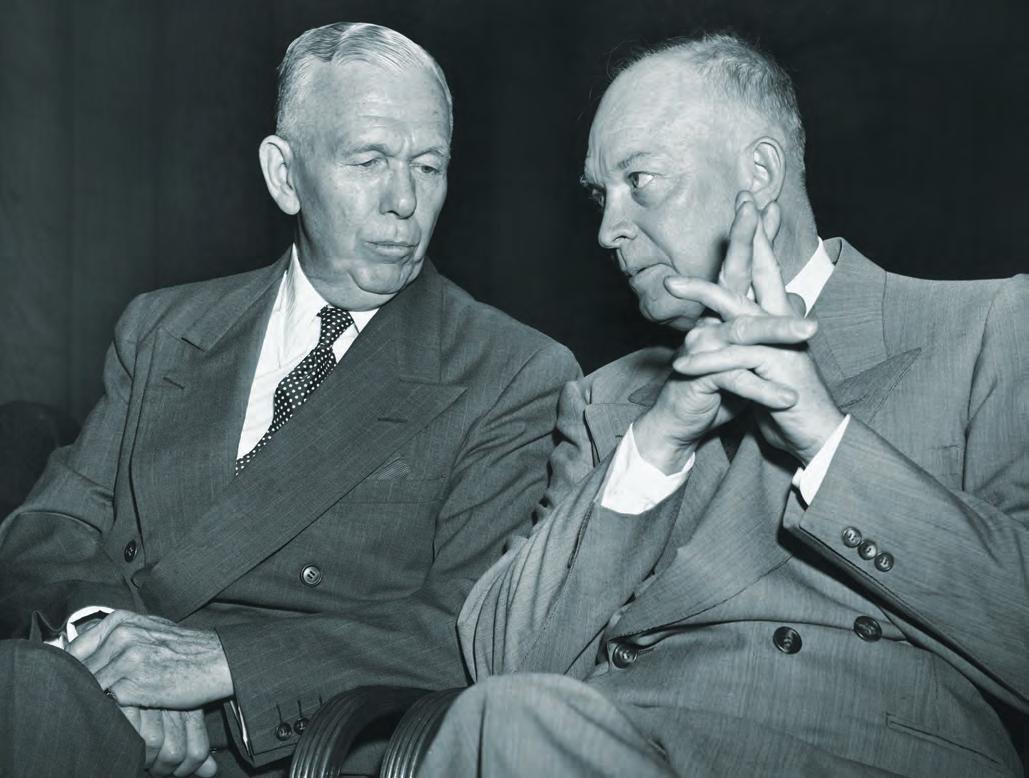
BETTMANN/GETTY IMAGES
Blooded Brothers Former Secretary of State George Marshall, left, with Columbia University president Dwight Eisenhower in the early 1950s.
Déjà Vu AMERICAN HISTORY16 AMHP-230100-DEJAVU.indd 16 9/28/22 2:46 PM



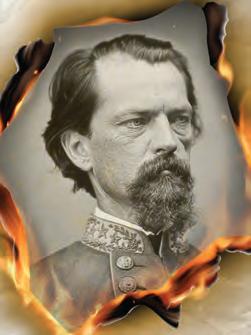









Order by Dec. 6 and you’ll receive FREE gift announcement cards that you can send out in time for the holidays! LIMITED-TIME HOLIDAY OFFER CHOOSE ANY TWO SUBSCRIPTIONS FOR ONLY $29.95 TWO-FOR-ONE SPECIAL! CALL NOW! 1.800.435.0715 PLEASE MENTION CODE HOLIDAY WHEN ORDERING SCAN HERE! OR VISIT HISTORYNET.COM/HOLIDAY Offer valid through January 8, 2023 * For each MHQ subscription add $15 Vicksburg Chaos Former teacher tastes combat for the first time Elmer Ellsworth A fresh look at his shocking death Plus! Stalled at the Susquehanna Prelude to Gettysburg Gen. John Brown Gordon’s grand plans go up in flames Tulsa Race Riot: What Was Lost Colonel Sanders, One-Man Brand J. Edgar Hoover’s Vault to Fame The Zenger Trial and Free Speech Yosemite The twisted roots of a national treasure HISTORYNET.com JUL 2020 H H HISTORYNET.COM JUDGMENT COMES FOR THE BUTCHER OF BATAAN THE STAR BOXERS WHO FOUGHT A PROXY WAR BETWEEN AMERICA AND GERMANY PATTON’S EDGE THE MEN OF HIS 1ST RANGER BATTALION ENRAGED HIM UNTIL THEY SAVED THE DAY In 1775 the Continental Army needed weapons— and fast World War II’s Can-Do City Witness to the White War ARMS RACE THE QUARTERLY JOURNAL OF MILITARY HISTORY An ammunition dump explodes during the April 1972 battle for An Loc. Defeating Enemy Stereotypes White and Black POWs bonded as cellmates The Green Berets Battles that inspired the book and movie TERROR AT AN LOC 9TH CAVALRY’S HEROIC FIGHT TO RESCUE DOWNED AIRMEN Huey Haven Old Warbirds Are Getting a New Museum HOMEFRONT Sweet success for Sammy Davis Jr. JUNE 2022 HISTORYNET.COM HNET SUB AD_HOLIDAY-2022.indd 1 8/30/22 8:34 AM
“some difficulty in resuming our discussion.”
Andrew Jackson was a fighter, on and off the field. Before he was elected to the White House, he had been shot in a duel in which he killed his man, and was also wounded in an armed brawl in a hotel with his own officers. In 1835, during Jackson’s second term, a would-be assassin fired two pistols at him as he was leaving a congressman’s funeral at the Capitol. Both weapons mis fired, and Jackson clubbed his attacker with a cane—a reasonable response, considering the circumstances. But the president unreasonably told anyone who would listen that the gunman, Richard Lawrence, had been put up to the assault by George Poindexter, a Mississippi senator with whom Jackson was then feuding. Lawrence was in fact a lunatic housepainter who imagined himself to be the legitimate king of England. He had once painted Poindexter’s house, but there was no evidence that the two were in cahoots; a jury found Lawrence insane after only five minutes’ deliberation. Harriet Martineau, an English sociologist who happened to be in Washington at the time, found Jackson’s tirades against Poindexter embarrassing.
“The President’s misconduct on the occasion was the most virulent and protracted,” Martineau wrote. “It was painful to hear a Chief Ruler trying to persuade a foreigner that any of his constituents hated him to the death, and I took the liberty of changing the subject as soon as I could.”
Andrew Johnson became Abraham Lincoln’s running mate, and ulti mately his successor, based on Johnson’s loyalty to the Union despite being a senator from Tennessee. But there was no charity for all in Johnson. In Feb ruary 1861 he had a conversation with Charles Francis Adams, Jr., 25-yearold sprig of the Massachusetts presidential clan, in which Johnson railed at secessionist colleagues. David Yulee of Florida was a “miserable little cuss,” a “contemptible little Jew,” and a “despicable little beggar.” Judah Benjamin of Louisiana was “another Jew….He looks on a country and a government as he would on a suit of old clothes. He sold out the old one; and he would sell out the new if he could in so doing make two or three millions.” Louis Wigfall of Texas—a gentile, for a change—Johnson called “a damned blackguard” and a bankrupt, explaining that “the strongest secessionists never owned the hair of a nigger.” What was remarkable about this splenetic display was not John son’s opinions of these men, who were after all working to destroy the coun try, but that he should express them so vividly to a kid he barely knew.
Ready to Rumble
A young Andrew Jackson, right, looks on at his handiwork after engaging in a duel early in his career as a man of public distemper.

Dwight Eisenhower’s mile-wide smile, his nick name rhyming with like, and his tangled syntax conveyed an air of innocent geniality. But on the eve of Ike’s first run for the presidency journalist Murray Kempton provoked his wrath. Senator William Jenner, Indiana Republican, had called Secretary of Defense George Marshall “a living lie,” holding Marshall responsible for losing China to communism, entangling us in NATO, and every thing else about the world that the isolationist Jen ner disliked. Kempton asked Eisenhower, whose mentor in the Army had been Marshall, what he thought of the charges. “He leaped to his feet and contrived the purpling of his face,” Kempton wrote. “How dare anyone say that about the great est man who walks in America?...He would die for George Marshall. He could barely stand to be in the room with anyone who would utter such a profana tion.” Kempton felt like an enlisted man being reamed as “an example to the rest of the troops.”
It is unlikely that anyone ambitious enough and compelling enough to rise to the top does so with out some degree of temper in his or her makeup. Temper can be the shadow of forcefulness. The question for those who possess a temper is, can they control it, or does it control them? After Washington lost his cool in front of cabinet mem bers, he and they returned to the question of whether to publicize Genêt’s misbehavior, and he decided: not yet. Washington’s critics could imag ine chopping off his head, but he would not be pro voked by a journalistic screed into losing it. Murray Kempton realized even as Eisenhower was bawling him out that the would-be Republican nominee had not criticized Senator Jenner. Ike would defend his idol, but not condemn his idol’s slan derer so long as he needed the slanderer’s support.
Andrew Jackson’s admirers then and since claim that Old Hickory used his wrath as Ike did, for momentary effect. “I never saw him in a passion,” testified Amos Kendall, one of Jackson’s senior cro nies. Kendall must have been out of town in 1835. Andrew Johnson has almost no admirers to stick up for him, and why should he? His impulses, vio lently anti-rebel then equally violently anti-Black, crippled Reconstruction out of the gate.
Once in a while a leader emerges whose veins run with the milk of human kindness. Secular saint Lincoln is one example; another is Ulysses S. Grant who, though he killed thousands in battle, was in peacetime benevolence itself. But most leaders, like most of us, are human, all too human. The good ones don’t leave ketchup on the walls. But it is always wise to clear the table after every course. H
NORTH WIND PICTURE ARCHIVES/ALAMY STOCK PHOTO
AMERICAN HISTORY18
Admirers saw Jackson as making tactical use of a display of feigned wrath, not succumbing to a fit of genuine passion.
AMHP-230100-DEJAVU.indd 18 9/28/22 2:47 PM
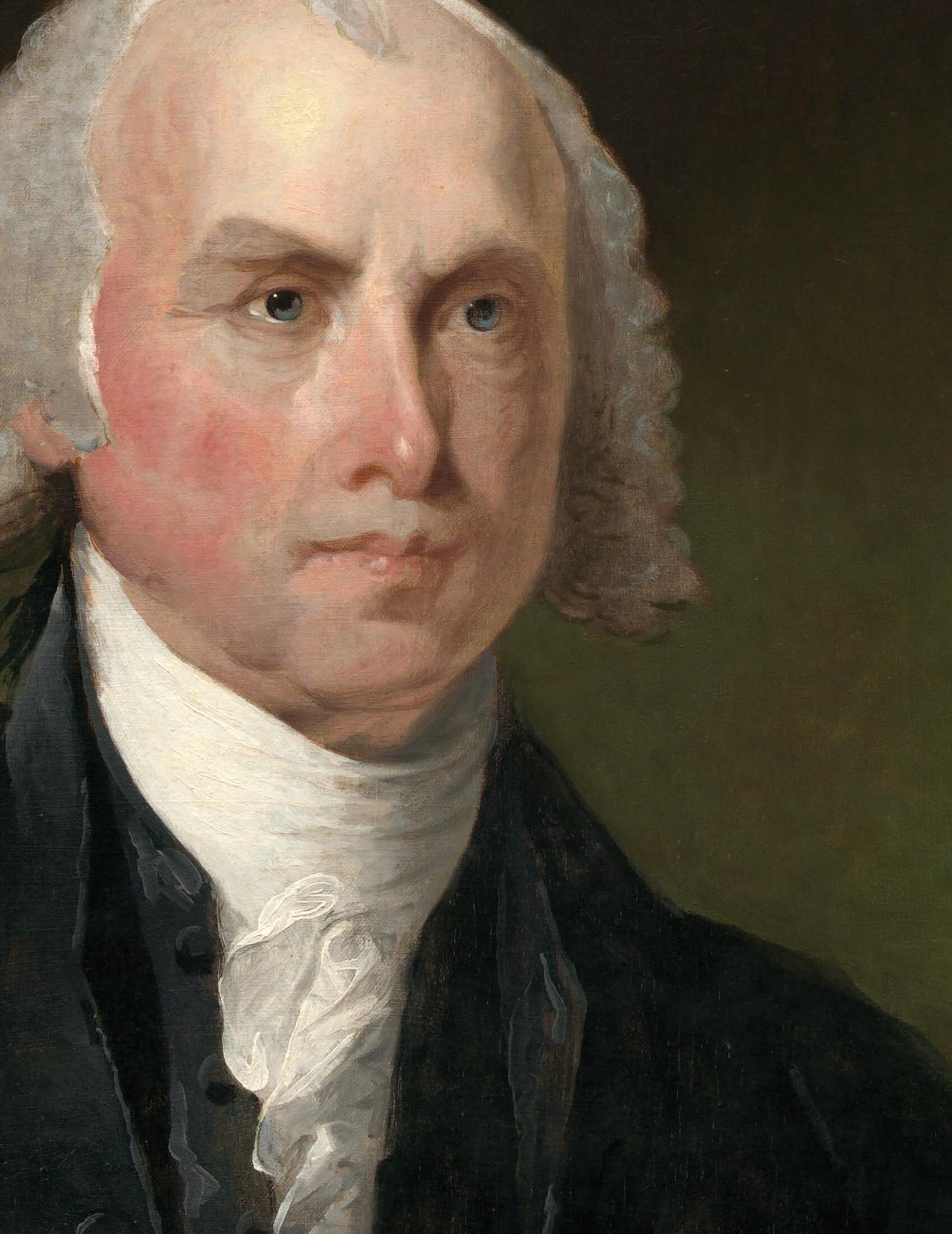
BROOKEVILLE, MARYLAND, BECOMES “U.S. CAPITAL FOR A DAY” WHEN PRESIDENT JAMES MADISON TAKES REFUGE THERE. EARLIER THAT WEEK, BRITISH TROOPS HAD SET FIRE TO WASHINGTON, INCLUDING THE WHITE HOUSE AND CAPITOL BUILDING. MADISON FLED THE CITY, ALONG WITH MEMBERS OF HIS CABINET, AND SPENT THE NIGHT OF THE 26TH AT THE HOME OF BROOKEVILLE POSTMASTER CALEB BENTLEY. THE TOWN STILL CELEBRATES THE EVENT EACH YEAR. TODAY IN HISTORY For more, visit HISTORYNET.COM/TODAY-IN-HISTORY AUGUST 26, 1814 TODAY-MADISON.indd 22 9/28/22 2:51 PM
Embracing Ugliness
by Daniel B. Moskowitz
Scotus 101
Brandenburg v. Ohio 395 U.S. 444 (1969)
Speech advocating illegal conduct is protected under the First Amendment unless the speech is likely to incite “imminent lawless action.”
WHAT STARTED OUT AS LITTLE more than a racist publicity stunt ended up being the defin ing Supreme Court decision on the meaning of the Constitutional guarantee of free speech—a ruling far more protective of controversial speech than previous high court holdings. Those prior decisions essentially told courts to balance the harm the contested speech posed against the benefits of unfettered freedom of expression, but now the Justices were “putting the thumb firmly on the scale in favor of the First Amend ment,” explains Katherine Fallow, senior coun sel at Columbia University’s Knight First Amendment Institute.
The case began in the summer of 1964, when Clarence Brandenburg telephoned Cincinnati, Ohio, NBC-TV affiliate WLWT with a tip: Ku Klux Klan members were to rally at a local farm. A reporter and camera crew showed up to cover the event, which was less than a success—no more than a dozen KKK supporters were milling around. The news team went to work anyway. The handful of armed, white-robed men and their burn ing cross made for arresting images and Brandenburg’s speech, even with no real audience, was fiery enough to make that evening’s news. In
offensive terms, the Klan organizer demanded the country expel Jews and Negroes. “If our President, our Congress, our Supreme Court continues to suppress the white, Caucasian race, it’s possible that there might have to be some revengeance taken,” Brandenburg said. “We are marching on Congress on the Fourth, four hundred strong.”

Observing what WLWT aired, local officials found Brandenburg’s screed provocative enough to dust off a 1919 Ohio “criminal syndicalism” law that outlawed advocating “sabotage, violence, or unlawful methods of terrorism as a means of accomplishing industrial or political reform” or assembling or joining any group formed to advo cate such actions. Prosecution of Brandenburg—in a trial that consisted of nothing more than screen ing the footage that WLWT had run—was success ful. The state fined the firebrand $1,000 and sent him to prison for 1-to-10 years.
The Ohio law under which Brandenburg was convicted was almost a carbon copy of other laws
LOS ANGELES EXAMINER/USC LIBRARIES/CORBIS VIA GETTY IMAGES HUM IMAGES/GETTY IMAGES
AMERICAN HISTORY20
AMHP-230100-SCOTUS.indd 20 9/26/22 10:37 AM
Hate on the March
In September 1926, with the terror group ascendant, a KKK parade drew 30,000 Klansmen to Washington, DC, in a display of strength.
enacted in the years just after World War I by 21 other midwestern and Western states. Despite civil liberties champions’ claims that such sweeping bans on advocacy of unpopu lar viewpoints eroded First Amendment free speech protections, in four separate cases the U.S. Supreme Court upheld criminal syndicalism statutes. In the most recent of those four Court endorsements, the justices had unanimously upheld the conviction of Charlotte Whitney for helping to found the Com munist Labor Party of California. Whitney’s support for an organization that endorsed violence to achieve social change could be prosecuted, the justices explained in 1929, because the First Amendment does not protect speech “inimical to the public welfare, tending to incite crime, disturb the public peace, or to endanger the foundations of organized government.”
Brandenburg unsurprisingly got no relief when he appealed. Citing the four Supreme Court precedents, an Ohio appellate court upheld his convic tion. The Ohio Supreme Court summarily dismissed the Klan man’s appeal, saying it presented no substantial constitutional question. By the time the Brandenburg case got to the high court in 1969, the Whitney decision was 40 years old, and there had been hints that the men of the high court no longer held the broad view of what speech could be curbed that their antecedents had enunciated. The issue was a hot one, with anti-Vietnam War protests and campus demonstrations dividing the country. So many lawyers repre senting defendants convicted for engaging in such protests had picked up those hints that when the Justices ruled on Brandenburg, the docket included four other free speech cases. All were sent back to lower courts for reconsideration in light of the Brandenburg ruling.
The first hint came in 1957. The high court had earlier green-lit government efforts to prosecute Americans for belonging to the Communist party, holding that such membership could be con strued as a “clear and present danger” to the country.
That decision in hand, the Justice Department moved against more than 100 party members, including Oleta Yates. Voting 6-1, the justices threw out the case against Yates, essentially stopping prosecution of card-carrying Communists. They ruled that the Constitutional guarantee of free speech prevented prosecution for endorsing a doctrine that might be dangerous to the country; in other words, prosecution was permissible only for encouraging specific actions to overthrow the government.
In 1961, the Court underscored its holding in Yates, dismissing the prosecution of John F. Noto, another Communist Party member. In composing his opinion for a unanimous court, Justice John M. Har lan II sounded a bit exasperated that authorities were not heeding the court’s pronouncement in Yates and repeated that the First Amendment protected all speech and advocacy except those posing real and immediate danger.
“We reiterate now, that the more abstract teaching of Communist theory, including the teaching of the moral propriety or even moral necessity for resort to force and violence is not the same as preparing a group for violent action,” Harlan wrote. “There must be some substantial direct or circumstan tial evidence of a call to violence.”
When Brandenburg came before the high court, the outcome was hardly in doubt. In fact, prosecution of the KKK figure was so clearly unconstitu tional that rather than a signed opinion the Court issued a per curiam rul ing. That’s usually a signal that the justices think their conclusion quite noncontroversial, but in this case that status also reflects the fact that there was no single author. Justice Abe Fortas had written the first draft of the Brandenburg decision, then, after financial dealings of his came into ques tion, had resigned. Justice William Brennan edited the final version. The
ruling ’s significance is not simply that it exoner ated Brandenburg, but that it provided a gauge with which to assess the legitimacy of future attempts to stifle inflammatory rhetoric. That yardstick consists of three elements:
H Did the defendant intend his or her words or expressive action to incite violence or other law violations?
H Would those illegal acts be imminent?
H Would the incitement likely be successful?
A government may punish speech only if that speech passes all three tests, the opinion decrees. Any law or local ordinance which punishes expression that does not do so “sweeps within its condemnation speech which our Constitution has immunized from governmental control.”
The third element of the test, Fallow says, means “you look at, not just the text of the speech or the context of the speech itself, but at the con text in which it takes place. How likely would it be to trigger violence?”
The high court confirmed its reliance on the Brandenburg formula in multiple cases, over
Keep Carrying That Card
In a 1957 decision, the justices reversed field, declaring that Oleta Yates, above with attorney Benjamin Dreyfus, was not committing a crime by belonging to the Communist Party.
turning in 1973 conviction of a college student for his shouts at an anti-war rally and in 1982 the conviction of a local NAACP official for warning that those failing to join a boycott of businesses that discriminated against Blacks might face vio lence. That’s still the standard—a standard, Jus tice Ruth Bader Ginsburg once said, that “truly recognizes that free speech means not freedom of thought and speech for those with whom we agree, but freedom of expression for the expres sion we hate.” H

LOS ANGELES EXAMINER/USC LIBRARIES/CORBIS VIA GETTY IMAGES HUM IMAGES/GETTY IMAGES WINTER 2023 21
AMHP-230100-SCOTUS.indd 21 9/26/22 10:37 AM
Picture This
by Sarah Richardson
IN 1839, ROBERT CORNELIUS took the first photographic self-por trait. What in the Philadelphian’s era was an enforced moment of somber motionless reflection, lest blink or breath blur the image being exposed on a chemically treated silver-coated plate, today is casually snapped in a fraction of a second by billions in the form of “selfies.” An innovator in photographic method, Cornelius established a successful portrait studio in Phila delphia at 8th and Market Streets. He soon returned to work at his father ’s lighting and lamp firm, but his brief stint as a photographer opened doors, technical and aesthetic, to a revolution in the new medium. Cornelius also had a career as a metallurgist that traces the rise and fall of innovations in another product involving light: lamps.

Cornelius, born in 1809, was son of Christian Cornelius, a
The Incunabular Selfie Besides advancing the medium on a scientific plane, Robert Cornelius, left, invented what may be the most common photo category ever.
watchmaker’s son turned expert in silver plating who at 13 had emi grated from the Netherlands to Lancaster, Pennsylvania. He is said to have started out in Philadelphia in 1827 by melting down the family silver dishes. The company would create brass lamps, chandeliers, and candlesticks, including a springdriven candlestick that cleverly kept a wick and its flame at a con stant level. The elder Cornelius later moved into more elaborate lighting apparatus. His business enabled him to send son Robert to private schools that trained the youth in chemistry, geology, and drawing. In 1831, Robert, 22, started working for his father.
The young man developed a side line in 1839 upon learning how French inventor Louis Daguerre had developed a technique for cap turing images on pieces of sil ver-plated metal.
The earliest photographic images necessarily were Parisian city scapes because the plate needed many minutes to register a sharp exposure on its treated surface; ani mals and passersby moving across the frame appeared as ghostly smudges. Samuel Morse, seeing an early Daguerre image, wrote in April 1839, “…the exquisite minuteness of the delineation cannot be conceived. No painting or engraving ever approached it.” Details of the spectacular pro cess soon reached the United States, where the younger Cornelius may have read about it in the August 1839 issue of the journal of the Philadel phia-based Franklin Institute. He and kindred spirits immediately began experimenting.
Working in his home with a tin box and lenses meant for opera glasses, in October or November 1839 Cornelius exposed and chemically stabi lized, or fixed, an image of himself on a sil ver-coated plate of his own devising. Recognized as the first photographic portrait, this artifact is remarkable not only for its technical excel lence—due to its creator’s expertise at fashion ing and polishing a fine silver plate—but for the way in which the 30-year-old Cornelius, young and vibrant, seems to be catching himself in the
LIBRARY OF CONGRESS LIBRARY OF CONGRESS Cameo AMERICAN HISTORY22 AMHP-230100-CAMEO-BW.indd 22 9/26/22 9:53 AM
moment, tousled hair, popped shirt collar, and all. Casually positioned in front of the camera, he has used one hand to uncover the lens and then kept still to immortalize himself.
Others were tinkering as well, and newly minted photographers were soon producing what became known as daguerreotypes—images on metal plates about 5”x7” in size set in wood or gilt metal frames. But for an image to be its sharpest, a subject had to be inanimate or able to sit utterly still for five, even ten minutes, produc ing a stiff and unnatural look. Some photogra phers had subjects sit with eyes closed or head gripped by an armature; others dusted subjects’ faces with flour to heighten contrast.
While fellow experimenters were working on contrast, Cornelius was tackling the chemistry of recording light.
His circle included Dr. Paul Goddard, who aided Cornelius in figuring how to dramatically cut exposure time. Photographic plates pro duced images on a thin layer of silver coated with iodine crystals that reacted to light. God dard suggested adding bromine, which reduced exposure time to as little as 30 seconds.
The men shared the discovery with the local scientific society—once they had cornered the local bromine market—and opened a studio in Philadelphia in May 1840. Two large mirrors positioned outside the studio were angled to direct light within, filtered through purple glass to reduce glare.
Customers needn’t be rich. A daguerreotype could be had for $5, a fraction of what a painted portrait cost. Yet photographs seemed not to reduce demand for painted portraits, and paint ers often took daguerreotypes of subjects for ref erence instead of putting customers through hours-long sittings. Rival studios opened.
Perhaps tired of the medium and dismayed by competition, Cornelius closed his studio in 1842. His output is unknown, but a recent survey iden tified 54 Cornelius daguerreotypes in museums and private collections
Philadelphia became a bastion of studio pho tography, by 1849 counting more than 40 studios in the city center, where photographers con verted lofts to studios with reflective white walls and large windows to direct light.
Cornelius returned to the family business, which was thriving by manufacturing large lamps renowned for their brightness, sturdiness, and beauty and often were fueled by whale oil in a reservoir surrounded by prisms to intensify the glow. The 1840s saw the beginning of whal ing’s heyday. Spermaceti, a dense slippery sub stance from a sperm whale’s head, burned bright and long and was one of the prime products of the hunt. Spermaceti eclipsed a succession of
No Blinking!
The first American photograph, depicting Philadelphia’s Central High School, was made in autumn 1839 by Joseph Saxton.
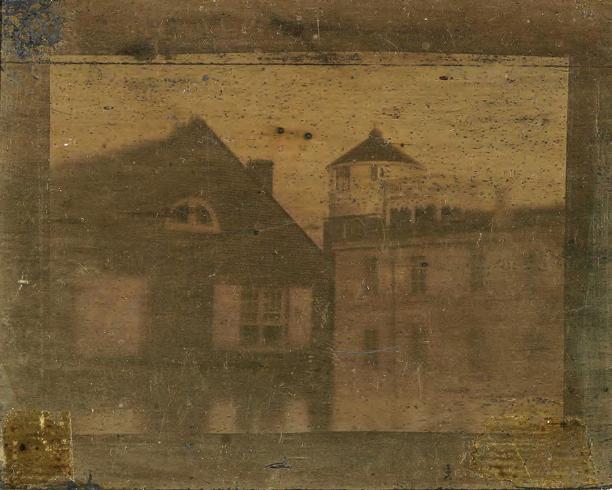
other substances—beeswax, beef tallow, pork lard, colza oil (from rape seed), oil from whale blubber, and camphene, a derivative of turpentine— during 1840-1870 becoming the preferred lamp fuel.
Cornelius patented a type of solar lamp, said to rival the sun for bright ness, that burned lard and salvaged kitchen grease. He was granted more than 20 patents. As gas light gained popularity, the Cornelius company adapted, manufacturing large gas-powered lamps, chandeliers, and osten tatious assemblages known as girandoles, from the Italian for “to turn.”
Christian Cornelius retired in 1851, and Robert Cornelius and relatives carried on. By 1855, the Cornelius company was employing 500 workers in two large factories in Phila delphia. The enterprise is most remembered as the premier manufacturer for grand giran doles marketed worldwide.
Cornelius lamps, installed in state capitols and in the U.S. Senate and three rooms at the White House, were a million-dollar business.
With the discovery in 1859 of petroleum in Titusville, Pennsylvania, much of the market for table lamp fuel shifted to kerosene made from petroleum. According to historical lighting expert Dan Mattausch, one Robert Cornelius patent was for a ker osene table lamp, but a competitor brought out a far cheaper version that won consumers’ favor. In 1877, Cornelius retired, and with him, perhaps, the spark of innovation. The company continued to make showy gas fix tures, sometimes depicting American icons such as George Washington, Benjamin Franklin, and Andrew Jackson, or a generic hunter.
Robert Cornelius left his mark nonetheless. As he put it in 1839, “I made a likeness of myself, and another one of some of my children in the open yard of my dwelling, sunlight bright upon us, and I am fully of the impres sion that I was the first to obtain a likeness of the human face.” H
LIBRARY OF CONGRESS LIBRARY OF CONGRESS WINTER 2023 23
A recent survey of Cornelius images found there to be 54 of them in the collections of private individuals and museums.
AMHP-230100-CAMEO-BW.indd 23 9/26/22 9:53 AM
On the Rise

PHOTO CREDIT
Riley B. King soon after engineering a start to a career that would make him a worldwide star.
AMHP-230100-BB KING-BW.indd 24 9/26/22 10:55 AM
n early 1949, Riley B. King, 23, was living and working as a tractor driver on a plantation outside Indianola, in the Mississippi Delta, where he mostly had grown up. A share cropper’s son determined to pursue a career in music, Riley busked playing the blues on the street and had had a gospel group and, as often as he could, and despite his stutter, chatted up working musicians. At Jones’ Night Spot in Indianola, he had buttonholed Sonny Boy Williamson, famed regionally for his lunchtime radio show, broadcast out of West Memphis, Arkansas. Now Riley was heading to that town, hoping to break into the music business.
RILEY BID FAREWELL to planter Johnson Barrett. “I’ll send for you, soon as I get settled,” he told his wife, Martha. Guitar in hand, he hitched a ride in a Lewis Grocery truck, helping the driver make deliveries in exchange for passage to West Memphis, across the Mississippi from Mem phis, Tennessee. Against the March chill he wore the field jacket he’d got ten during a brief wartime stint in the U.S. Army. His destination was 231 East Broadway, the studios of KWEM, which had launched in 1947 on a pay-to-play system. Local performers could book a time slot by ponying up $15 or $20 or find a sponsor to cover the cost. One of the station’s first stars had been Chester Burnett, a giant of a man from the Mississippi Hill Country who performed as Howlin’ Wolf.
Becoming B.B.
A crucial 48 hours changed a Mississippi-born musician’s life
 By Daniel de Visé
By Daniel de Visé
PHOTO CREDIT
WINTER 2023 25
I AMHP-230100-BB KING-BW.indd 25 9/26/22 10:56 AM
Mentor and Patron
Sonny Boy Williamson II (at mic) during a 1942 show at KFFA in Helena, Arkansas. From left: Joe Willie Wilkins, Dudlow, Williamson, announcer James Curtis, Herb Langston, Willie Love.
Excerpted from KING OF THE BLUES © 2021 by Daniel de Visé. Reprinted with the permission of the publisher, Atlantic Monthly Press, an imprint of Grove Atlantic, Inc. All rights reserved.

Wolf’s voice, a bone-rattling bass baritone growl, froze listeners in their seats.
KWEM’s other star was Sonny Boy William son. Born Alex Ford around 1912 on a Mississippi plantation, he mastered the harmonica and by the 1930s was traveling around Mississippi and Arkansas and performing with many singers and guitarists, including Robert Johnson.
In 1941, Ford landed on the air at KFFA in Hel ena, Arkansas, playing music and touting baking products on a show, “King Biscuit Time,” named for sponsor King Biscuit Flour. Sponsors suppos edly rechristened Alex Ford "Sonny Boy William son" to exploit the brand of a Chicago musician already recording under that name.

In 1948, Sonny Boy moved to West Memphis and KWEM, arriving shortly after Wolf, a friend he had taught to play harmonica. Sonny Boy’s sponsor was Hadacol, a patent medicine mar keted as a vitamin supplement for the entire fam ily. In truth, the “Wonderful Hadacol Feeling”
was actually inebriation; the stuff was 12 percent alcohol (American Schemers, April 2018).
For years, Riley and the other hands at Bar rett’s plantation had been coming in from the fields at lunchtime to relax listening to Sonny Boy. And there had been that encounter at Jones’ Night Spot. “I felt I knew him,” he recalled. Still, Riley could not explain how he summoned the nerve that Wednesday to walk into KWEM, clutching his guitar and asking for Sonny Boy. He found Williamson in the studio, finishing a num ber with guitarist Robert Lockwood Jr. and pia nist Willie Love. When he had finished playing, Sonny Boy gave his visitor a hard look.
“What do you want?”
Riley took a deep breath and tried his best to remember those warm memories he treasured of Sonny Boy on the radio.
“I…I…I…I wanna sing a song on your program,” Riley B. King stammered.
“You do, huh?”
AMERICAN HISTORY26 COLIN ESCOTT/GETTY IMAGES PREVIOUS SPREAD: MICHAEL OCHS ARCHIVE/GETTY IMAGES; THIS PAGE: MICHAEL OCHS ARCHIVE/GETTY IMAGES
AMHP-230100-BB KING-BW.indd 26 9/26/22 10:56 AM
“Yes, sir.”
Sonny Boy and his band members now remembered the night a few years back when a boy with a stutter had peppered them with questions in Indianola.
“Go ahead,” Sonny Boy said. “Lemme hear you.”
Riley swung his guitar around and lit into “Blues at Sunrise,” which had been a hit for Ivory Joe Hunter. “I sang with all the soul I could muster,” he recalled. “My gui tar hit the right notes and I sang in tune.” He waited for Sonny Boy’s verdict.
“What do you call yourself, son?” the radio host asked with a flicker of warmth.
“Riley B. King.”
“All right, Riley B. King,” Sonny Boy said. “You can sing your song at the end of my program. Just be sure you sing as good as you did just now.”

Riley stood by until Sonny Boy gave him a nod. At the microphone he played and sang as well as he ever had. When he was done Sonny Boy took back the mic.
“The boy ain’t bad, but you tell me what you think,” Williamson told his listeners. “Call in if you like him.”
As Sonny Boy was wrapping up, Riley waited. A White man came into the studio and announced that many listeners were calling in to praise Riley’s performance. Then he whispered in Sonny Boy’s ear.
“Shit,” Sonny Boy Williamson said. “I done messed up.”
Riley started to panic, thinking he was some how at fault.
“Lookee here, Riley B. Seems like I dou ble-booked myself,” Sonny Boy explained. “I’m working down ‘round Clarksdale tonight, but I also got me another date at that Sixteenth Street Grill here in West Memphis. You wanna play the Grill for me?”
“Yes, sir,” Riley replied in an instant. He was “thrilled beyond reason,” he recalled. “Giddy and silly and screaming hallelujah inside.” In the space of an hour, he had debuted as a radio blues man and earned his first paying solo gig.
Sonny Boy picked up the telephone and placed a call. “Did you hear the boy who just sang?. . .How did you like him?. . .Well, I’m gonna let him work for you tonight.” He hung up.
“I want you to go down and play for Miss Annie at the Sixteenth Street Grill,” Sonny Boy said, menace in his voice. “And you better play.”
“Yes, sir,” Riley replied.
The club, a block off Broadway in West Mem phis, was variously known as the Square Deal Café, the Sixteenth Street Grill, and Miss Annie’s
No Frills
Place, after owner Annie Jordan. Miss Annie showed Riley around. “The joint was just a couple of rooms,” he recalled. “One up front for music and sandwiches, one in the back for gambling.”
“I got me a jukebox in here,” Annie told Riley. “But I turn it off ‘cause the ladies like to dance to a live man.”
A live man. The words danced in the young musician's head. And sure enough, as showtime approached, a procession of ladies filed into the café, some with escorts, some without. The men retreated to the gambling parlor, leaving their dates up front to dine and dance.
Having no better clothes, Riley took the stage wearing his field jacket. The ladies didn’t seem to mind. “For the first time I played for dancers, played for these ladies who moved so loose and limber that I played better than I’d ever played before,” he recalled. “Might have messed up my musical measures or screwed up a lyric or two, but, baby, the beat was there.”
Riley filled Miss Annie’s Place with the blues, his only accompaniment his Gibson guitar run ning through a tiny amplifier as he sang through a small public address system. He held down the
WINTER 2023 27 COLIN ESCOTT/GETTY IMAGES PREVIOUS SPREAD: MICHAEL OCHS ARCHIVE/GETTY IMAGES; THIS PAGE: MICHAEL OCHS ARCHIVE/GETTY IMAGES
He filled Miss Annie's with the blues, his Gibson guitar running through a tiny amplifier as he sang through a small public address system.
The young bluesman made his WDIA debut in a stark setting.
AMHP-230100-BB KING-BW.indd 27 9/26/22 10:56 AM
beat, and the dance floor filled with hot, heaving bodies.
“I want to hire you,” Miss Annie said after wards. “But you can’t help me get business unless you’re on the radio, like Sonny Boy is. If you can get on the radio, I’ll pay you $12 a night and give you room and board.”
“Yes, ma’am," Riley replied. “I will get on the radio.”
The club owner offered to put him up. “That night I couldn’t sleep for the pictures running through my head,” he recalled. He imagined women in various states of undress, “bending over and stretching, grinding and grinning and showing me stuff I ain’t ever seen before.”
The next day, Miss Annie told Riley about WDIA hiring Black deejays like local celebrity Nat D. Williams. On previous forays to Memphis, Riley, with his cousin Bukka White, had played Nat D.’s amateur nights at the Palace. Guitar in hand, Riley caught a bus for Memphis to find WDIA.
WDIA, 1070 AM, HAD COMMENCED operations on Union Ave nue in the summer of 1947. The founders were White men. John Pepper, the businessman, was a scion of an affluent Memphis family; WDIA was named for his daughter Diane. Bert Ferguson, the station manager, was short on cash but long on experience. Eight years earlier, Pepper had brought Ferguson in to run WJPR-AM in Greenville, Mississippi. The two were looking for a niche in the Memphis market, dominated by five stations with ties to national networks and celebrity disk jockeys.


WDIA started out playing country-and-western. When that format failed to attract listeners, the owners tried pop and even classical music. Now they were back to country, airing shows like “Cracker Barrel” and “Hillbilly

AMERICAN HISTORY28 MICHAEL OCHS ARCHIVE/GETTY IMAGES PICTORIAL PRESS LTD./ALAMY STOCK PHOTO; COURTESY OF SPINDEL FAMILY (2)
A King and His Court B.B. King, center rear, with his band and fellow announcer Nat Williams, right.
Bert Ferguson
Christine Cooper
AMHP-230100-BB KING-BW.indd 28 9/26/22 10:56 AM
Party.” Nothing was working. Christine Cooper, Ferguson’s programming director, searched in vain for the right format. Chris Cooper, 23, was a striking woman, taciturn and serious, with soul ful brown eyes and a sharp mind. Ferguson had lured her from an ad agency to become one of the first women in Memphis radio.
In spring 1948, Cooper was wondering if she had made the right choice. WDIA was hovering near bankruptcy, and the owners seemed desper ate. Cooper and Ferguson and two other station employees, to save on hotel bills, had left an industry convention in Nashville early and were driving the 200 miles to Memphis.
Ferguson was at the wheel, with Cooper riding shotgun. As they were rolling past moonlit farm houses on two-lane blacktop roads, Ferguson leaned toward his program director.
“What do you think about programming for Negro people?” he whispered.
Cooper considered. Their competition in Memphis had divvied up the region’s White audi ence. No mainstream station was programming for Blacks, a potential audience as large as the entire White market—“tens of thousands of peo ple with names and faces who had served me at restaurants and ridden on the same bus,” she recalled. Blacks in and around Memphis had their own clubs, their own festivals, and even a newspaper—the Memphis World—but no radio station. Cooper told her boss she loved his idea.
“Would you object to working alongside Negro people at the station?” Ferguson asked, again speaking sotto voce.
No, Cooper replied, she would not.
After that furtive exchange Ferguson dropped the topic. Cooper thought he had lost his nerve or his focus. He was always coming up with new con cepts, sometimes with Pepper. Lately the two had been pushing a tonic they had dreamed up to compete with Hadacol and had gotten so far as to organize a company to sell it. Ferguson had tried to get her to write the ads, but she refused. But Bert had not lost focus on taking WDIA Black. That October he told her he had decided “to go ahead with it.” Chris knew instantly what “it” was.
AFRICAN AMERICAN RADIO had begun in the 1920s with a visionary named Jack Cooper. Born in Memphis in 1888, Cooper made his name reporting for Black newspapers in Chicago, Illi nois. In 1925, on WCAP in Washington, DC, a strong Black market, he launched a variety show. Cooper performed dialect skits; he joked later that he had been “the first four Negroes on radio.” Returning to Chicago, in 1929 he brought out “The All-Negro Hour” on WSBC, patterning this show on African American vaudeville line-ups.
A Different Ax
In a 1949 promotional photo, B.B. holds a Fender Esquire solid-body electric guitar.

Broadcasters favored live material so they could skirt hefty fees the American Society of Composers, Authors, and Publishers charged sta tions to play and broadcast recorded music. The modern disc-jockey figure, a record-spinning on-air personality, arrived in 1932, when Jack Cooper invented that role. In a dispute over pay, a musician scheduled to play one of Cooper’s shows instead walked out of the studio. By one account, to rescue the moment the impresario “got a bar rel and set some little record player on it and held a mike to it.” Thus, the first deejay.
By WDIA’s day, African American performers were popping up on the airwaves all over the South. Bert Ferguson had put Riley King’s gospel quartet on the air in Greenville.
But Black deejays remained rare, and no sta tion in the United States had an all-Black format. That became Ferguson’s goal.
His first choice to spin discs at WDIA was Nathaniel D. Williams, a history teacher in the Memphis public school system who had built a sideline in multiple media.
Besides teaching, Williams, as “Nat D. Wil liams,” wrote a column for the World and hosted
WINTER 2023 29 MICHAEL OCHS ARCHIVE/GETTY IMAGES PICTORIAL PRESS LTD./ALAMY STOCK PHOTO; COURTESY OF SPINDEL FAMILY (2)
“Would you object to working with Negro people at the station?" the WDIA exec asked his programming director. No, Christine Cooper replied, she would not.
AMHP-230100-BB KING-BW.indd 29 9/26/22 10:57 AM
the weekly amateur night competition at the Pal ace Theatre, broadcast live by a WDIA rival. Wil liams’s compact frame and Coke-bottle glasses were familiar to all of Black Memphis.

Williams agreed to work at WDIA. His week day shift would start after school. Now came the ticklish task of naming his show for promotional purposes without ruffling Jim Crow’s feathers. Even “Negro,” while nominally acceptable, was too blunt for the radio program listings in the Memphis Commercial Appeal, sending Cooper and Ferguson to a thesaurus. They considered “brown” and “sepia” before settling on “tan,” which sounded like a day at the beach. Nat D. Wil liams would be hosting “Tan Town Jamboree.”

Williams was to debut at 4 p.m. on Monday, October 25, 1948. He arrived at the station breathless, having raced across town from Booker T. Washington High. He took a seat at the micro phone, collecting himself. At the top of the hour, his White announcer cued him. Williams sat in silence, mind a blank. Seconds ticked by. Wil liams, realizing the absurdity of his predicament, erupted into a long peal of laughter. Soon every one in the studio was joining in, and “Tan Town Jamboree” was rolling. That big, cathartic laugh became Nat D.’s trademark.
Not everyone was laughing. Backlash to “Tan Town Jamboree” came swift and fierce.
“For the first three weeks, we were just plagued
with calls—‘Get that nigger off the air!’” Cooper recalled. “My boss got death threats.” Station per sonnel fielding complaints politely reminded callers that if they did not like what they were hearing they were free to turn the dial.
Complaints from White listeners died down. With the most famous Black man in Memphis on the air every afternoon, WDIA’s Black listener ship exploded across Tennessee, Arkansas, and Mississippi. Thanks to radio’s unifying power, the “Jamboree” became a virtual town hall for every Black community within 60 miles.
RILEY’S LAST QUARTER GOT HIM as far as the bus station in downtown Memphis. It was three miles to WDIA. He cinched the cotton-sack strap he used to secure his fatigue jacket against the chill and rain. His guitar still lacked a case. Mov ing at a trot, he hugged the instrument, its f-holes against his chest to keep water out.
The station’s offices vaguely resembled a giant brick radio, with the art-deco call letters bolted across the building façade. Riley later described himself peering through a large plate-glass win dow and seeing “a black man with super-short hair and super-thick glasses”: Nat D. Williams, in the studio. A red light was on, meaning, Riley knew, that the deejay was on the air. When the red bulb dimmed and a green light went on, Riley tapped the glass. Williams beheld “a brown-skin
AMERICAN HISTORY30 GAB ARCHIVE/GETTY IMAGES (2) BETTMANN/GETTY IMAGES; MICHAEL OCHS ARCHIVE/GETTY IMAGES
Station hands reminded unhappy callers that if they did not like what they were hearing they were free to turn the dial to another frequency.
Tan Town Time Memphis multimedia figure Nat D. Williams helped make WDIA a favorite among Black listeners and did the same for patent medicine Peptikon.
AMHP-230100-BB KING-BW.indd 30 9/26/22 10:57 AM
fellow standing there with water dripping off his battered old hat, water oozing out of the soles of his shoes. Drenched all over with a worn and really battered old guitar under his arm. He stood there looking wistfully at me through that glass partition.”
Chris Cooper remembered the scene differ ently. Riley simply appeared at the front desk. “He went to the receptionist with his drip ping-wet umbrella and his guitar held tight to his chest,” she recalled.
The receptionist called Bert Ferguson. “He came down from his office,” Cooper said. “And she said, ‘Somebody’s here who wants to record.’”
Much later Riley remembered Bert Ferguson as “a short Jewish man, not much hair, with a serious air about him.”
The manager regarded his visitor. A close-cut, ragged pompadour topped Riley’s smoothly sym metrical clean-shaven features, with wide-set eyebrows above mournful eyes. He was wiry, with powerful hands that spoke of farm work.
“We don’t make records,” Ferguson said. Still, he said, “We might be able to use you. If I put you on the radio, would you be too nervous to talk?”
“I might do a little st-st-st-stuttering,” Riley stuttered. “But no more than the average person. I think the average person will take to me.”
Ferguson asked about his background. Riley told about singing blues on the corner in Indi anola and singing gospel on the radio. Ferguson remembered having met him that time in Green ville. Riley explained about singing for Sonny Boy on KWEM and his new gig playing at the Six teenth Street Grill. WDIA production manager Don Kern joined them. Riley played for the radio men, perhaps the first time he had ever played the blues in front of an attentive White audience. Assuming correctly that his listeners knew little about the blues, he did “Caledonia,” Louis Jor dan’s jumping number about a woman with “great big feet.” When Riley finished Kern said, “You’re all right.” He and Ferguson smiled.
“And mentioning Sonny Boy gives me an idea,” Ferguson said. “Sonny Boy’s made quite a splash advertising Hadacol. Well, we have a sponsor called ‘Pep-Ti-Kon.’ Good for whatever ails you. And we’re looking for someone who can sell it. I’m thinking that one way to sell it [would be] through a song. You ever written a jingle?”
“No sir,” Riley replied.
“Willing to try?”
Riley sat with his guitar for a few minutes, humming a melody, then, against a simple blues progression, sang, “Pep-Ti-Kon sure is good/And you can get it anywhere in your neighborhood…” Ferguson beamed. He strode off and returned with Cooper. The program director saw a guitar
dripping against a wall and a slen der Black man, head bowed, also dripping, like some Delta appari tion. Ferguson told the visitor to sing something. When the fellow stepped to the microphone, he seemed to transform. “He just straightened up,” Cooper recalled. “And he hit his guitar like he knew what he was doing.”
She was expecting to hear one of the minstrel songs she knew— “Old Black Joe,” or “Swanee River,” Stephen Foster chestnuts. Decades later, Cooper, who before that day had never heard Delta blues, could not remember what Riley did play but she was certain of her reaction to hearing him.
“It just tore me apart,” she said.
Riley recalled his choice of song as having been another Louis Jordan number, “Somebody Done Changed the Lock on My Door,” an exercise in wordplay along the lines of “Caledonia.” But the “key” and the “lock” were a double entendre, and Riley played the song for every bit of its carnal meaning, raw and sexual and coarse, voice burning with menace and lust, sodden gui tar buzzing with an angry twang. The music and the lyrics made the young program director want to rip open the studio door and run into the street. She felt shaken, upset, unnerved. And then she thought that maybe this rough, sensual music was exactly what WDIA’s new listeners wanted. Riley finished singing.
“Let’s put him on the air,” Cooper gasped.
Boldness earned Riley B. King a regular 15-min ute slot on WDIA following station mainstay Nat Williams. Per Bert Ferguson’s decree, the station billed him as “BB King.” Though not paying him— on the air, he could promote his shows at Miss Annie’s, which paid several times what he had been making at the wheel of a tractor—station management welcomed him into a familial work place where everyone was “Mr.,” “Mrs.,” or “Miss” regardless of skin color. Riley sent for Martha and they moved into a boardinghouse in Memphis. By autumn 1949, WDIA’s programming had shifted to all-Black, and B.B. King had begun a long march to global musical stardom. H
Fame to Come
When B.B. began his career in Memphis he was some years yet from working the show business circuit that would put him at the top of the bill, as on these 1950s concert posters.


WINTER 2023 31
GAB ARCHIVE/GETTY IMAGES (2) BETTMANN/GETTY IMAGES; MICHAEL OCHS ARCHIVE/GETTY IMAGES
AMHP-230100-BB KING-BW.indd 31 9/26/22 10:57 AM
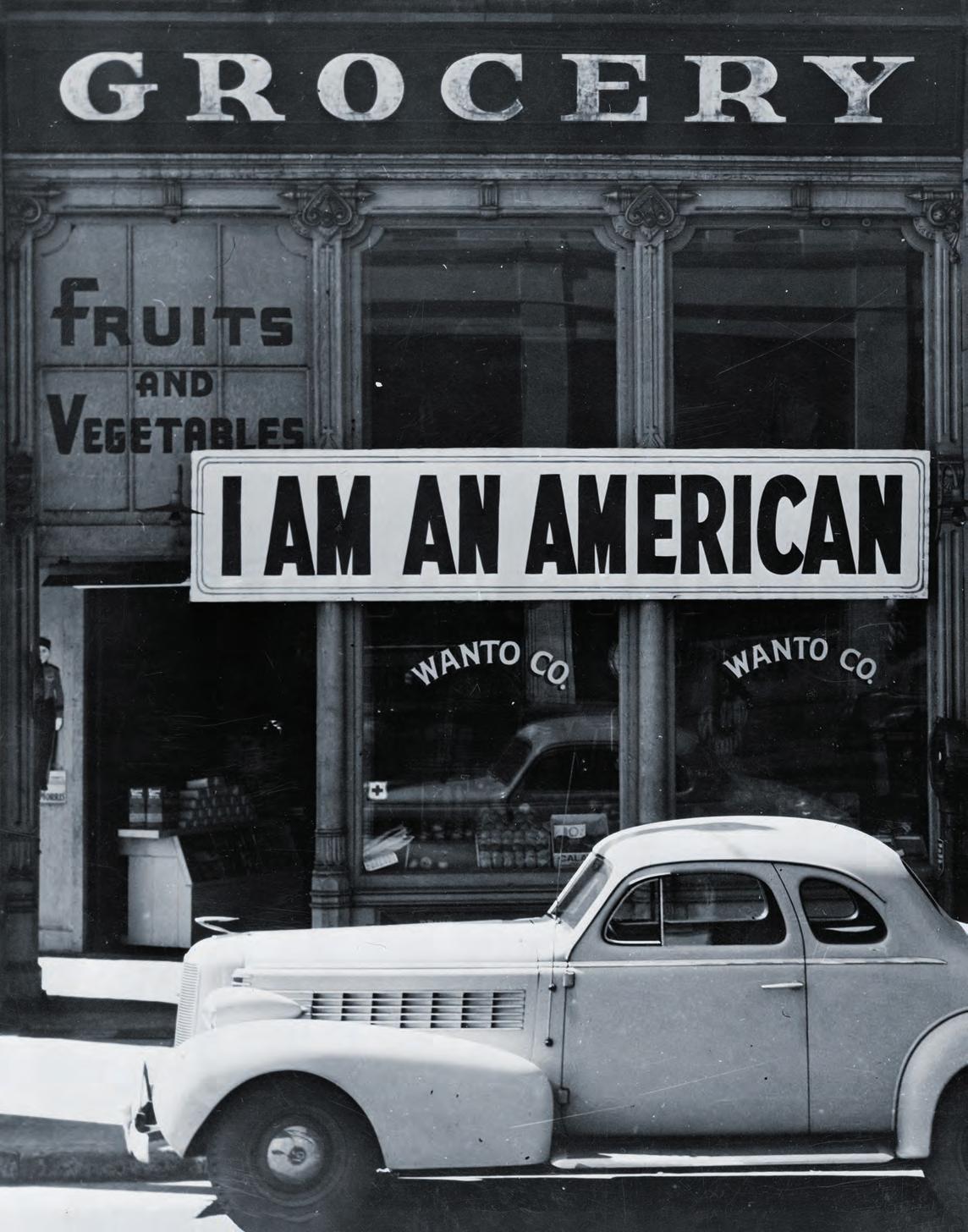
PHOTO CREDIT AMHP-230100-INFAMY-BW.indd 32 9/26/22 11:49 AM
Declaration
On December 8, 1941, the owner of this Oakland, California, store, a UC graduate, posted this sign.

Days of Infamy
Hostility toward Asians in America took an even harsher turn during World War II
By J. D. Zahniser
resident Franklin D. Roosevelt famously declared Japan’s December 7, 1941, bombing of Pearl Harbor, Hawaii, “a date that will live in infamy.” For those of Japanese ancestry in America, the date even more deeply seared into memory is Feb ruary 19, 1942. That day, Roosevelt ordered the mass removal from the West Coast of “all persons deemed a threat to national security.” In practice, Order 9066 applied exclusively to Ameri can Japanese, 120,000 of them. Of those ordered from their homes, 70 percent were American citizens.
Wholesale evacuation took months to gestate but arrests began immediately after Pearl Harbor. Using newly compiled lists of “suspect enemy aliens,” the FBI detained 1,000 German and Italian immigrants and 1,200 prominent Japanese Ameri cans. The latter were nearly all male, most living on the West Coast or in the U.S. territory of Hawaii.
UC Berkeley student Yoshiko Uchida returned from the cam pus library that December 7 to find an FBI agent searching her parents’ Berkeley home, demanding to know the whereabouts of Yoshiko’s father, an executive with a Japanese-owned export firm. Dwight Uchida was soon arrested and confined with other suspects at the Presidio army base before being sent to a federal prison in Missoula, Montana.
After ransacking Japanese farmers’ homes in Oregon’s Hood River Valley, FBI agents arrested community leaders, including Tomeshichi Akiyama, president of a local cultural group, the Japanese Society. Akiyama’s son George was among 3,000 Nisei, or second-generation Japanese Americans, then serving in the
PHOTO CREDIT
WINTER 2023 33 P AMHP-230100-INFAMY-BW.indd 33 9/26/22 11:50 AM
Presidential Proclamation
On February 19, 1942, FDR, top, signs the order that subjected Japanese Americans to relocation and confinement as a wartime precaution against “suspected enemy aliens. Headlines soon followed.

U.S. military. Some Nisei in uniform were peremp torily discharged; in addition, the Selective Ser vice stopped accepting Japanese Americans who were trying to enlist. Once the services realized the utility of having Japanese speakers in the ranks and the need for trained combat personnel, officialdom shipped most Nisei servicemen inland to Minnesota and Wisconsin for intelligence training and readiness drills.
Japanese Americans pushed back. The presi dent of the vigorously patriotic Japanese Ameri can Citizens League, Saburo Kido, telegraphed
FDR: “ We are ready and prepared to extend every effort to repel this inva sion together with our fellow Americans.”
Rafu Shimpo, the largest stateside Japanese-language newspaper, editori alized in English that Japan had started the war and America must end it: “Fellow Americans, give us a chance to do our share.”
WHITE AMERICAN ANIMUS toward Japanese immigrants was nothing new. Naturalization laws enacted in 1790 and 1894 denied Japanese U.S. cit izenship. Increasing numbers of Japanese immigrant farmers motivated a 1913 California ballot measure proscribing Japanese ownership of land. Even though Japan had stood with the Allies during World War I, the 1924 Johnson-Reed Act cut off all immigration from Japan.
The Depression and Japan’s 1936 alliance with Germany and Italy inten sified suspicions in America of Japanese aliens, as well as of non-citizens of German and Italian ancestry. FBI Director J. Edgar Hoover already had presidential approval for secret domestic intelligence-gathering. After Ger many invaded Poland on September 1, 1939, Hoover directed every FBI field office to document individuals who during wartime “would constitute a menace to the public peace and safety of the United States Government,” especially those warranting detention. The “ABC list” rated leaders of ethnic organizations as As; many Cs simply supported cultural societies.
The Alien Enemies Act of 1918 allowed detention of non-citizens deemed dangerous—a step explicitly reserved for wartime. As Americans nervously watched fighting erupt in Asia and Europe, Congress buttressed Hoover’s secret work. The Alien Registration Act of June 1940 ordered all non-citi zens photographed and fingerprinted. By January 1941, almost five million individuals had registered nationwide, including 90,000 Japanese. Hoover publicly stoked fear, warning of fifth-column intrigues by “the vilifying Com munist and the espouser of alien philosophies.” The Justice Department, trying to rein in Hoover, divvied up responsibilities for a potential roundup and detention campaign with the War Department.
Between December 7, 1941, and mid-March 1942, FBI agents arrested 6,700 “alien enemies.” Detainees included several hundred operatives impli cated in a Japanese spy circle run out of that nation’s consulate in Los Ange les; those arrested were deported. A dozen members of a German American Bund chapter were exonerated of charges that they provided privileged defense information to the Axis. Most of those charged in the weeks after Pearl Harbor were guilty only of their ancestry.
AN EVENTUAL SWEEPING PROGRAM of evacuation and internment rolled up only American Japanese. Besides being Caucasian, German and Italian immigrants and their descendants were too familiar, too numerous, and too strongly supported by fellow citizens. No one wanted Joe DiMaggio’s mother arrested. Only when authorities had hard evidence did they move against individuals of European ancestry. But distrust of Japanese in general was pronounced and deep-seated.
By early 1942, California politicians were aligning with the Elks, Townsend Clubs, and other grass-roots groups demanding swift action against Japanese living on the West Coast. California Attorney General Earl Warren had first counseled moderation; now he was invoking a “repetition of Pearl Harbor.” Governor Culbert Olson, eyeing Warren as a November 1942 election opponent, told Congress, “I believe in the wholesale evacua tion of the Japanese people.” Los Angeles Mayor Fletcher Bowron fired all city workers of Japanese descent.
Newspapers large and small had long fueled anti-Japanese prejudice. The San Francisco Chronicle accused Japanese in Hawaii of aiding the Pearl Har bor attack. Sacramento Bee editors insisted, “The possibility of a Japanese attack on the coast has loomed ever larger.” Radio pundit John B. Hughes

AMERICAN HISTORY34 LIBRARY OF CONGRESS/GETTY IMAGES PREVIOUS SPREAD: LIBRARY OF CONGRESS; UNIVERSAL IMAGES GROUP/GETTY IMAGES; LIBRARY OF CONGRESS
AMHP-230100-INFAMY-BW.indd 34 9/26/22 11:50 AM
claimed 99 percent of the Japanese in America would “die joyously for the honor of Japan.” Speaking in Pullman, Washington, CBS correspondent Edward R. Murrow remarked, “I think it’s probable that, if Seattle ever does get bombed, you will be able to look up and see some University of Washing ton sweaters on the boys doing the bombing.”
In Washington, DC, some power brokers doubted the need for a forced relocation. Eleanor Roosevelt publicly warned against “foolish prejudices about other races.” She privately urged her husband and other officials to counter the prevailing winds. Attorney General Francis Biddle and other Justice Department higher-ups argued against removal of Japanese Ameri cans. Even the rabid Hoover agreed. “The necessity for mass evacuation is based primarily upon public and political pressure,” the FBI chief wrote in February 1942.
Generations
Excluded
A U.S. Army Military Police officer posts Japanese Exclusion Order No. 1 on Bainbridge Island in Seattle, Washington in early 1942.

is an enemy race.” DeWitt’s office repeatedly issued alerts of non-existent raids and attacks. In a recommendation to the president DeWitt nonsen sically declared, “The very fact that no sabotage has taken place to date is a disturbing and confirm ing indication that such action will be taken.”
Issei Immigrant born in Japan. Nisei Children of Issei, Americanborn and therefore citizens.
Kibei Nisei sent to Japan for education.
The most knowledgeable mili tary officials agreed. Lieutenant Commander Kenneth Ringle, a naval intelligence officer who had served in the American embassy in Tokyo and later on western naval bases, spoke Japanese; his extensive network exposed the Japanese consul ate spy ring. Ringle said he felt that “the entire ‘Japanese Problem’ has been magnified . . . largely because of the physical characteristics of the people.” Army deputy chief of staff General Mark Clark, who had long served in Hawaii, thought evacuation unnecessary.
THE SITUATION LOOKED DIFFERENT to the Army’s head of Western Command. From his headquarters at the Presidio in San Francisco, Lieu tenant General John DeWitt argued for removal. “Racial affinities are not severed by migration,” Dewitt wrote the secretary of war. “The Japanese race
Ultimately, the decision rested with the com mander-in-chief. Urged on by Secretary of War Henry Stimson, FDR signed Executive Order 9066 on February 19, 1942. Attorney General Bid dle reckoned that the president was either unduly swayed by hysteria or simply chose expedience. Roosevelt got the politics right: a national poll found that more than 90 percent of respondents endorsed evacuation of Issei—Japanese-born immigrants. Seventy-five percent also favored removal of Nisei—children of Issei, American citi zens by birthright.
An exclusion zone was quickly defined and a War Relocation Authority (WRA) organized to coordinate mass removal to “relocation centers.” Any person of 1/16th or more Japanese ancestry was to register for evacuation. The exclusion zone encompassed Western Washington and Oregon, California, and southern Arizona—the region

WINTER 2023 35 LIBRARY OF CONGRESS/GETTY IMAGES PREVIOUS SPREAD: LIBRARY OF CONGRESS; UNIVERSAL IMAGES GROUP/GETTY IMAGES; LIBRARY OF CONGRESS
AMHP-230100-INFAMY-BW.indd 35 9/28/22 2:50 PM
Uprooted, Relocated, and Confined From top, Japanese Americans in Los Angeles queue to register as required by presidential order 9066; aided by guard Corporal George Bushy, Mrs. Shigeho Kitamoto and her four children prepare to leave Bainbridge Island; detainees in their quarters at at the repurposed Santa Anita horse-racing track in Arcadia, California.

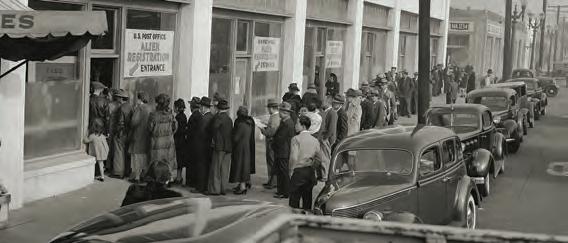

where most Japanese in America lived. The other large concentration was on Hawaii, where a blanket expul sion of Japanese residents would devastate the econ omy. Only Hawaiian residents of Japanese descent on one of the FBI’s lists were detained.
The army issued orders to evacuate by area, begin ning March 24. The 300 Issei and Nisei who lived on Bainbridge Island off Seattle got six days’ notice. They could take only what they could carry. Farmers aban doned crops, college students walked away from cam puses, owners frantically negotiated sales of busi nesses and residences. A fortunate few had friends or neighbors willing to store cherished possessions or adopt small businesses. No one knew whether their area of the exclusion zone would be next. “What had I, or . . . what had the rest of us done, to be thrown in camp, away from familiar surroundings and familiar faces?” a Nisei wondered. “It is your contribution to the war effort,” the official reply went. “You should be glad to make the sacrifice to prove your loyalty.”
The federal government was by no means prepared to house more than 100,000 people. Thousands on the ABC lists were already jailed at military bases and other facilities. To house displaced Issei and Nisei while more permanent facilities were being built out side the exclusion zone, 17 temporary “assembly cen ters” were designated. In California racetracks, fair grounds, and camps were rapidly repurposed.
GEORGE TAKEI WAS FIVE when his family was sent to Santa Anita Racetrack. “Each family was assigned a horse stall still pungent with the stink of manure,” he later wrote. Young Takei thought it fun to sleep where horses had slept. He didn’t mind the semi-private stalls and communal showers and lavatories. His par ents, who had been forced to give up a prosperous dry-cleaning business, were devastated.
Yoshiko Uchida, with her mother and sister, ended up at Tanforan Racetrack near San Francisco, housed in a stable. The utter lack of privacy mortified many women. “I felt degraded, humiliated, and over whelmed,” Uchida later wrote. “And I saw the unutter able sadness on my mother’s face.” The family spent five months at Tanforan; in time Dwight Uchida, now an “enemy alien on parole,” joined them.
Identifying ten sites for relocation camps proved difficult. “The Japs live like rats, breed like rats,” spit Idaho Governor Chase Clark. He and counterparts in Wyoming and Arizona decried the use of their states as “dumping grounds.” Japanese victories in the Pacific worsened hysteria despite an utter lack of evidence that Japanese Americans were committing sabotage. The WRA eventually won approval for remote intern ment sites under strict guard, as at a prisoner-of-war camp. Manzanar and Tule Lake in eastern California became the best known, but there were also camps in Idaho, Wyoming, Utah, and Colorado, plus two each in Arizona and Arkansas.
AMERICAN HISTORY36 BETTMANN/GETTY IMAGES; NATIONAL PORTRAIT GALLERY LIBRARY OF CONGRESS; AP PHOTO; MARK KAUFFMAN/GETTY IMAGES
AMHP-230100-INFAMY-BW.indd 36 9/26/22 11:50 AM
From May through November 1942, thousands of Japanese American families were transported, mostly by trains with window shades drawn, to the hastily constructed camps. The internees arrived under heavy military guard at dusty, bare, and arid sites. Of the camp at Poston, Arizona, a San Diegan said, “No trees, no flowers, no birds singing, not even the sound of an insect.” Arriving at the desolate Topaz, Utah, site, Yoshiko Uchida saw greeters “standing in the burning sun, cov ered with dust.” Most facilities had been placed amid dust bowls or swamps that made efforts at cleanliness exasperating.
Rolls of barbed wire, watch towers, and armed sentries guarded blocks of pine and tar paper bar racks. The quarters lacked plumbing and privacy. Toilets and showers were communal. Each family was assigned a room ranging in area from 8’x20’ to 20’x20’; couples and individuals shared the smaller spaces with strangers. Everyone received a straw mattress and army blanket. One conscien tious objector helping evacuees settle in made a point of remaining outside while a family entered. “It was too terrible to witness the pain in people’s faces, too shameful for them to be seen in this degrading situation,” he said.
Many internees endured their situation with little complaint, murmuring “Shikata ga nai,” “It cannot be helped.” Dwight Uchida spent his first
Sent Away
Some of the hundreds of Japanese Americans relocated from Bainbridge Island at Seattle, Washington, depart on March 30, 1942. From the bridge in the background a crowd watches. Left, Ruth Asawa’s camp ID card.


morning at Topaz helping clean latrines. Food poisoning raged for lack of refrigeration. Yoshiko Uchida volunteered to help organize housing assignments until she could apply for a camp job.
As the relocation centers became organized, block councils became the most effective self-governing apparatus, though their success varied by camp. The council for each 250-to-300 resident group of barracks included a block manager, elected representatives, and the head chef for the block. Male Nisei and bilingual Issei like George Takei’s father Norman became block managers, who tried to meet the needs of block residents. Block man agers and councils took direction from and negotiated with the Caucasian camp staff, helped establish schools, worship spaces, and playing fields. They guided the creation of health clinics and barber shops, as well as community newspapers and gardens. Hiroshi Kashiwagi, a block manager at Tule Lake, felt he had “little or no voice” and was simply a flunky of camp administra tors. Norman Takei and others fared better.
LIVING CONDITIONS AT THE CAMPS reshaped lives and relationships. For instance, block organization undercut family structure. Amid the buzz and clatter of mess hall dining, parents were frustrated in their efforts to teach manners and values during meals; teens often began eating with peers.
Key Case: Korematsu v. United States
The U.S. Supreme Court upheld the consti tutionality of internment on December 18, 1944. Dissenting Justice Robert Jackson called the ruling a “legalization of racism.”
On that same day, the Supreme Court ruled in Ex parte Endo that the WRA lacked the authority to detain “con cededly loyal” citizens; the ruling steered clear of constitutional issues, but was seen as nudging FDR’s announcement of the end of internment. In 1983, Korematsu was overturned, based on proof that the federal govern ment had suppressed evidence that the Japanese in America posed no mil itary threat. (SCOTUS 101, August 2019)

WINTER 2023 37 BETTMANN/GETTY IMAGES; NATIONAL PORTRAIT GALLERY LIBRARY OF CONGRESS; AP PHOTO; MARK KAUFFMAN/GETTY IMAGES
AMHP-230100-INFAMY-BW.indd 37 9/28/22 2:50 PM
At Santa Anita and Topaz Above, internees at Santa Anita Relocation Center in Arcadia, California, watch a train leave that facility. Right, the Uchidas outside the the family’s residence in the camp at Topaz, Utah.
At Manzanar, Jeanne Wakatsu ki’s family, “after three years of mess hall living, collapsed as an integrated unit.” Block council decision-making also stole some parental authority. On the other hand, young people craving more independence found it with peer groups or by securing jobs or college admission away from camp.

Tensions were evident from the first. Each camp’s population of about 10,000 threw together Issei and Nisei, country folk and city dwellers, Bud dhists and Christians, bilingual speakers and those who knew little English. “Internal squabbling spread like a disease,” wrote Yoshiko Uchida. Shoddy healthcare meant actual sickness ran rampant. Jobs paid little and errati cally at that. The minority of Issei hoping Japan would win resented Norman Takei and fellow American patriots as inu—"dogs,” meaning collaborators. Many Nisei wondered bitterly what American citizenship was worth. Some, particularly the Kibei Nisei educated in Japan—joined camp gangs.
In the fall of 1942, WRA director Dillon Myer toured the barely settled relocation centers to talk about resettlement. Myer had quickly realized that internment “saps the initiative, weakens the instincts of human dignity and freedom, creates, doubts, misgivings and tensions.” Recognizing camp staff and resident concerns as well as labor shortages nationwide, he launched an expansive leave policy. Internees with health issues could apply for shortterm leaves. College students could depart camp indefinitely if a midwestern or eastern university accepted them. Yoshiko Uchida soon left Topaz for graduate study at Smith College only to be assailed on the train by a conduc tor barking, “You’d better not be a Jap!” Despite continuing prejudice, by 1945, 4,300 Nisei had entered or resumed college. “Work leave” allowed internees to work at nearby farms or businesses, earning far more than camp wages. At Minidoka, Idaho, 2,000 internees left to work the fall 1942 harvest. The other Uchida sister, Keiko, left Topaz to take a teaching job in the East.
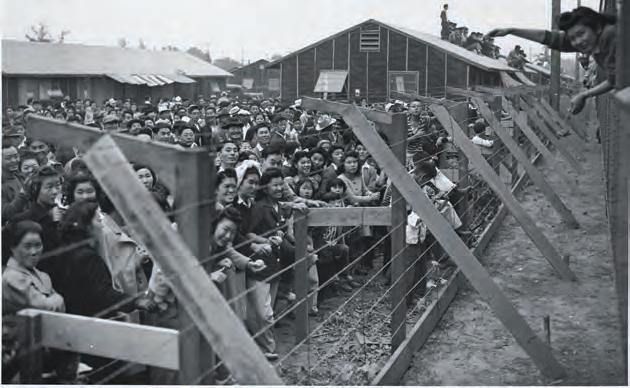
BY 1943, SECRETARY OF WAR Stimson had convinced FDR to allow Nisei internees to serve in the army. Lieutenant General DeWitt still believed “a Jap is a Jap,” and opinion polls suggested that the American public mostly
agreed. Nevertheless, Stimson, WRA staff, and others working with detainees increasingly sup ported not only resettlement but drafting Nisei The tailored enlistment process soon morphed into a questionnaire given all internees to answer. Two questions read:
27. Are you willing to serve in the armed forces of the United States on combat duty or wherever ordered?
28. Will you swear unqualified allegiance to the USA and faithfully defend the U.S. from any and all attacks by foreign or domestic forces, and forswear any form of allegiance to the Japanese emperor, to any other foreign government power or organization?
Question 27 presumed that a draft-age man should serve a country that had destroyed his and his family’s lives. Question 28 implied that all Japanese in America worshipped the emperor. And Issei who renounced Japanese citizen ship would be stateless.
The two questions outraged intern ees and exacerbated tensions between Nisei and Issei.
Mitsuo Usui, at the Granada, Colorado, camp, told his parents he wanted to enlist. “We lose everything—the property, the business, our home!” his father shouted. “Now they’re saying come in and shine my shoes!” He kicked Mitsuo out. Some Issei reminded their sons that their own World War I service had failed to gain them citizenship. The fact that the army planned to seg regate Japanese American soldiers was no help.
Bureaucrats rewrote Question 28 to be less inflammatory, but grievances remained; 3,000 internees delayed answering by requesting repa triation to Japan. Among those completing the form, nearly 90 percent answered yes to both questions.
Egged on by the U.S. Senate, Lt. General DeWitt, and now-Governor Earl Warren, WRA director Myer moved to separate “loyals” from “disloyals,” though there were still multiple reasons for peo ple’s answers or refusal to answer. For example, knowing that “disloyals” were to be transferred to the Tule Lake, California, camp, 40 percent of orig inal camp residents there, among them George Takei’s parents, answered no-no in order to remain at Tule Lake and avoid further disruption.
During the summer of 1943, the 12,000 intern ees who either refused to answer or answered “no” to both loyalty questions were transferred to Tule Lake and held under maximum security. A circuit court judge later described the conditions
AMERICAN HISTORY38 NIDAY PICTURE LIBRARY/ALAMY STOCK PHOTO; NATIONAL PORTRAIT GALLERY LIBRARY OF CONGRESS/GETTY IMAGES; THE BANCROFT LIBRARY/UNIVERSITY OF CALIFORNIA
AMHP-230100-INFAMY-BW.indd 38 9/26/22 11:51 AM
Into the Fight
1,400 Nisei, mostly from Hawaii, made up the 100th Infantry Battalion/442d Regimental Combat Team of the U.S. Army. Stationed in Europe, the 100th became one of the war’s most decorated units, its men earning 20 Medals of Honor and more than 4,000 Purple Hearts—one went to future U.S. Senator Dan iel Inouye (D-Hawaii)—among other awards. President Harry Truman himself awarded one of eight Distinguished Unit Citations on July 15, 1946, saying, “You fought the enemy abroad and prejudice at home and you won.” In 2010, President Barack Obama recognized the unit with the Congressional Gold Medal.
as worse than those in a federal penitentiary. Within a couple months of the transfers, Tule Lake workers went on strike. A few weeks later, hundreds of internees staged a protest around the building where WRA Director Dillon Myer was visiting, demanding better food and worker pay. During the same period, internees suspected of cooperation with camp officials were often beaten by pro-Japan gangs. Martial law was declared, during which hundreds were imprisoned in the camp stockade. Several thousand “no-no’s” at Tule Lake were eventually exchanged for Ameri can prisoners of the Japanese.
The no-no turmoil meant that efforts at mili tary recruitment in the camps largely failed.
About 1,200 Nisei volunteered from all ten camps. By contrast, Hawaii enlistment offices were swamped with non-interned Hawaiian Nisei Thousands eventually served in the Army, half of those from Hawaii; 800 lost their lives.
FROM A HIGH OF ABOUT 120,000, the interned Japanese American population was down to 90,000 when FDR proclaimed an end to the evac uation in January 1945. Roughly half of those interned never returned to the West Coast, choos ing to settle in the Midwest or elsewhere, among them Yoshiko Uchida and her sister. Death claimed 1,900 internees. George Takei’s impover ished family returned to Los Angeles, living first on Skid Row and later in the East L.A. barrio George grew up to be an actor.
Survivors of internment fought for redress. In 1948, the Japanese Americans Evacuation Claims Act designated $100 million to compensate for lost income and property, distributing $37 million to 26,550 claimants. American citizenship was opened to Japanese immigrants beginning in 1952. In 1980, a federal Commission on Wartime Relocation included one former Tule Lake internee, William Marutani. The Commission estimated losses at $1-2 billion (in 1980 dollars). Three years later, the Commission recommended a formal apology, educational efforts, and reparations of $20,000 each.

After vigorous lobbying by 100plus survivors, Congress passed the Civil Liberties Act of 1988, affirming that during 1941-45 Japanese Ameri cans had been incarcerated “without adequate security reasons and with out any acts of espionage or sabotage.” Internment was “motivated largely by racial prejudice, wartime hysteria, and a failure of political leadership.” Initially reluc tant, President Ronald Reagan signed the bill on August 10, 1988. Some 82,000 internees lived to see the moment. H

Fighting on Two Fronts
In late 1944, Japanese American infantrymen of the U.S. Army’s 442nd Regimental Combat Team hike a road in the Chambois Sector, France.
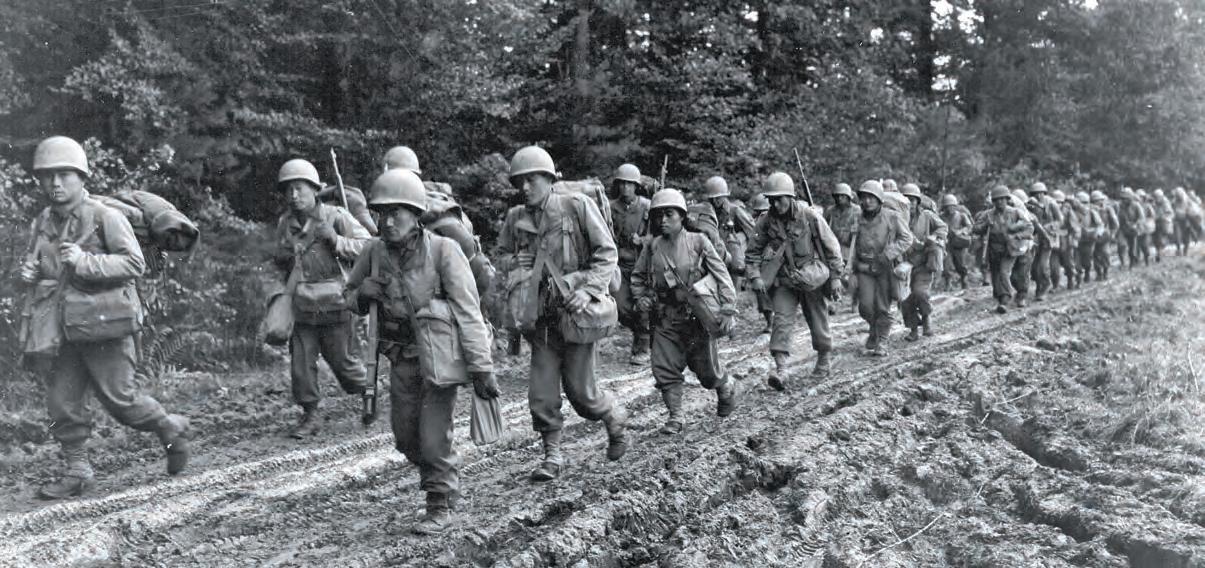
WINTER 2023 39 NIDAY PICTURE LIBRARY/ALAMY STOCK PHOTO; NATIONAL PORTRAIT GALLERY LIBRARY OF CONGRESS/GETTY IMAGES; THE BANCROFT LIBRARY/UNIVERSITY OF CALIFORNIA
Fred Korematsu
AMHP-230100-INFAMY-BW.indd 39 9/26/22 11:51 AM
Picture
Imperfect
Photographer Ansel Adams brought his talented eye to bear on an American tragedy
By Richard J. Goodrich
As It Was During the winter the Manzanar Relocation Center had no hope of disguising itself as anything but what it was: punitive confinement.
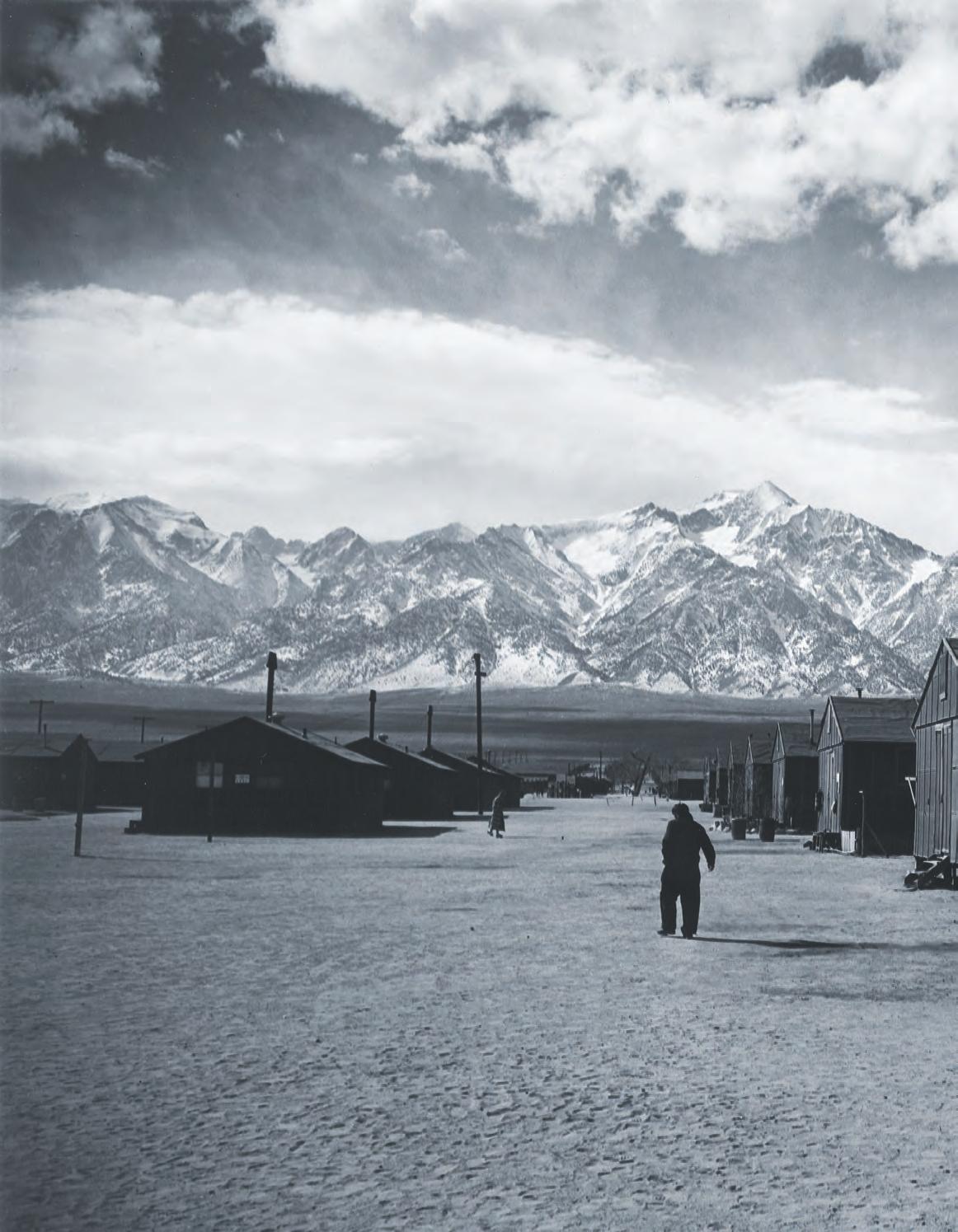
AMHP-230100-ANSELADAMS-BW.indd 40 9/26/22 10:48 AM

AMHP-230100-ANSELADAMS-BW.indd 41 9/26/22 10:48 AM
You All Know Why We're Here
Hardly softened by its rustic configuration, the sign at the gatehouse made clear what the situation at Manzanar was.
n October 28, 1943, photographer Ansel Adams drove through the front gate of the Manzanar War Relocation Center. Set in the inhospitable desert of Owens Valley, California, Manzanar housed 10,000 American citizens of Japanese ancestry forcibly “evacuated” from the western states after Pearl Harbor and interned at Manzanar. Barbed-wire fences enclosed the 814-acre camp, and the rifles in the guard towers were pointing in. Over the next two months, Adams—known then as now for dramatic black and white landscape images—photographed the camp’s residents. In 1944, he published Born Free and Equal, a book about Manzanar. In its pages, Adams tacitly offered a perspective opposed to the anti-Japanese hysteria that had brought on the internment of loyal Americans. He cele brated the resiliency of the men, women, and children who endured this unwarranted hardship. Born Free and Equal, which never attained the stature of Adams’s many other books, demonstrated his great humanistic spirit and willingness to stand with the disenfranchised during a time of severe national stress.


BESIDES PLUNGING THE UNITED STATES into World War II, Japan’s raid on Pearl Harbor crystallized hostility against the Japanese abroad and at home. As shocked West Coast residents were reading and hearing initial news reports about the sneak attack, California deputy sheriffs and agents of the Federal Bureau of Investigation were already rounding up “Japanese suspected of subversive activities.”
On February 19, 1942, President Franklin D. Roosevelt issued Executive Order 9066, autho rizing the Secretary of War to designate geo graphical areas from which “any or all persons may be excluded.” Suspect individuals would be “evacuated” to residential camps where they were to receive “food, shelter, and other accom modation”—and be kept under guard. The order, a mandate separate from those stipulating con trols on foreign enemy aliens, who also were to be interned, specified no nationality, but there was no doubt about its target. Anti-Japanese hysteria had exploded, fed by rumors starring insurgents
AMERICAN HISTORY42 LIBRARY OF CONGRESS (2) PREVIOUS SPREAD: LIBRARY OF CONGRESS; THIS PAGE: LIBRARY OF CONGRESS; PICTORIAL PRESS/ALAMY STOCK PHOTO
O
Ansel Adams
AMHP-230100-ANSELADAMS-BW.indd 42 9/26/22 10:48 AM
and saboteurs. Investigators testifying before the House Committee on Un-American Activities claimed that on the West Coast Japanese agents were strapping cameras to homing pigeons and setting the birds loose to fly over and document restricted areas. The Committee recommended that anyone in the United States of Japanese ancestry be moved 500 miles inland from the Pacific. (See “Days of Infamy,” p. 32).
Three days after Roosevelt signed Order 9066, the FBI swept up 500 “enemy aliens” who, the Los Angeles Times reported, had “guns and ammunition, cameras, binoculars, flashlights, radios and alien flags.”
These “first triumphs of the war in the Pacific Coast States” were arrested in Los Angeles, Long Beach, and San Diego. Similar raids snared sus pected saboteurs in Seattle and along the Oregon coast. The need for incarceration facilities spurred construction of “local detention centers” and “inland concentration camps.” In 1988, a congressional commission concluded that these arrests “were carried out without adequate secu rity reasons and without any acts of espionage or sabotage documented by the Commission.”
Japanese victories in the Pacific theater height ened concern about a West Coast invasion. On February 24, 1942, the Los Angeles Times shocked readers with a story about a Japanese attack on oil fields at Ellwood, California, a coastal town 12 miles north of Santa Barbara. Japanese subma rine I-17 lobbed 16 poorly aimed rounds into the facility, causing minimal damage. Witnesses swore that they had observed Japanese on the beach at Ellwood using signal lights to direct the barrage. Frightened Angelenos clamored for the removal of all people of Japanese descent, fearing they comprised a fifth column. “We must move the Japanese in this country into a concentration camp somewhere, some place, and do it damn quickly,” Representative Alfred J. Elliott (D-Cali fornia), who represented Tulare in the San Joa quin Valley, told Congress.
ON MARCH 3, 1942, Lieutenant General John L. DeWitt, head of the Western Defense Command, announced plans to relocate thousands of “enemy aliens.” As Java was falling to the Japanese, Amer ican officials were hastening to secure Pacific Coast states. The army listed three categories of people to be removed from exclusion zones: indi viduals suspected of espionage, immigrants born in Japan (issei), and second- or third-generation Japanese Americans whose parents or grandpar ents had been born in Japan (nisei). All parties in these categories were to relocate to one of 10 camps being readied in the American interior. Two weeks later General DeWitt announced the
first “voluntary” relocation, set for March 23. The government was to ship 1,000 people of Jap anese descent from Los Angeles to the Owens Valley, 224 miles northeast. DeWitt warned those affected to settle their affairs quickly. “I want it made unmistakably clear,” he told the Los Angeles Times, “that evacuation will be contin ued with or without cooperation.”
Way Station
Top, a bus driver, on roof, loads luggage for residents departing Manzanar for another relocation center. Below, the perspective from a surveillance tower staffed by armed guards.


Archie Miyatake remembered internment unfolding quickly. “We heard rumors that our government was going to start evacuating everyone of Japanese ancestry,” he wrote later. Miyatake was 16, a student at East Los Angeles High School. The son of Toyo Miyatake, Manzanar’s unofficial pho tographer, he chronicled his experience in an edition of Born Free and Equal. “I remember thinking, ‘Oh no, how can they do that?’ I just couldn’t believe that they would do such a thing.”
By the end of March relocation was under way. The government forced affected citizens to sell their residences and businesses, pack, and move to relocation centers. To document the operation, the Wartime Relocation
WINTER 2023 43 LIBRARY OF CONGRESS (2) PREVIOUS SPREAD: LIBRARY OF CONGRESS; THIS PAGE: LIBRARY OF CONGRESS; PICTORIAL PRESS/ALAMY STOCK PHOTO
AMHP-230100-ANSELADAMS-BW.indd 43 9/28/22 2:51 PM
Subsistence Farming
Manzanar residents harvesting that season's potato crop, using crates to transport the spuds for storage and distribution in the coming months.

Authority, a civilian agency created to oversee the project, hired photographer Dorothea Lange, a star of the Depression-era Farm Security Admin istration photo unit. The wartime agency seemed to be expecting Lange’s work to complement favorable propaganda run in West Coast newspa pers. Los Angeles Times stories went on about how smoothly the roundup was going, and how grate ful those being displaced were for their govern ment’s lenience: “The evacuees spoke highly of the government policy of keeping families together at Manzanar, explaining that such proce dure [sic] meant the least possible interruption in their daily routine.” Coverage painted soldiers as kindly: “May I carry your bag, ma’am?” a Times staffer reported hearing an army lieutenant ask an older Japanese woman.
Lange was supposed to illustrate the benevo lent treatment of happy internees, but the reality of the government action and her role in it horri fied the photographer. “In contrast to her earlier
work for a government social program to aid the poor, Lange now found herself photographing the execution of a government order to incarcerate American citizens based on their ancestry,” historian Jasmine Alinder writes. Lange rebelled, pointing her camera at scenes of dislocation and hardship: piles of luggage, “For Sale” signs in windows of abruptly closed stores, hand-lettered placards in shop windows announcing “I am an Amer ican”—disturbing parallels to increasingly familiar images from Europe of Nazi anti- Semitism.
Disheartened, the photographer left the WRA in July 1942. The agency locked away her photos until after the war. “I fear that intolerance and prej udice is constantly growing,” she wrote to Adams in November 1943. “We have a disease. It’s Jap-baiting and hatred. You have a job on your hands to do to make a dent in it—but I don’t know a more challenging nor more important one. I went through an experience I’ll never forget when I was working on it and learned a lot, even if I accomplished nothing.” In a 1961 interview Lange said the WRA had “impounded” and classified her nega tives and prints from her days with the agency.
A SAN FRANCIS CO NATIVE, Ansel Adams, 41, found wartime frustrating. Though successful starting in the early 1920s with a balance of commer cial, editorial, and personal work, he yearned to focus on artistic projects, particularly landscapes. In the 1930s, he had founded the f/64 group with kindred spirits Imogen Cunningham and Edward Weston. He published books, had museum and gallery shows, and worked for corporate clients. World War II interrupted his burgeoning career. The market for his land scape photography dried up; buyers were not interested in beautiful
AMERICAN HISTORY44 LIBRARY OF CONGRESS (2) LIBRARY OF CONGRESS
AMHP-230100-ANSELADAMS-BW.indd 44 9/26/22 10:49 AM
Home for Now
pictures. He was too old to enlist or serve as a combat photographer. In a letter to Nancy Newhall, acting curator of New York’s Museum of Modern Art, he described his wartime contri bution as “photographing Army convoys that visit Yosemite,” training military photographers at Fort Ord, California, and taking “Navy patients out for photographic sessions here in the val ley….I have tried unsuccessfully to get into some work relating to the war effort...I certainly would like to be of use. So many things are at stake.”
In autumn 1943, Ralph Palmer Merritt, Man zanar’s new director, contacted Adams. The men had met as members of the Sierra Club. Merritt asked if Adams would be interested in photo graphing Manzanar residents. The idea, Adams wrote Nancy Newhall, was “to clarify the distinc tion of the loyal citizens of Japanese ancestry and the dis-loyal Japanese citizens and aliens (I might say Japanese-loyal aliens) that are stationed mostly in internment camps.”

Both categories, noted Adams, faced intense hostility on the West Coast. The project was an opportunity to remind people that America was not at war with all people of Japanese descent— just those who supported Japan’s belligerence.
Merritt’s putative project had no funding— Adams would not be working for the WRA. “I cannot pay you a cent,” Merritt told Adams. “But I can put you up and feed you.”
Adams also would have to get to and from Manzanar. Rationing regulations sharply cur tailed civilian driving by limiting access to fuel and tires. Once his local rations board authorized
Taking Stock
In a warehouse at Manzanar, manager M. Ogi, left, interacts with co-op manager S. Sugimoto and Bunkichi Hayashi.

WINTER 2023 45 LIBRARY OF CONGRESS (2) LIBRARY OF CONGRESS
The Toyo Miyatake family in the cramped quarters assigned them.
AMHP-230100-ANSELADAMS-BW.indd 45 9/26/22 10:49 AM
Adams to obtain “ample fuel and ade quate tires for the hundreds of miles of driving between Yosemite and Man zanar,” he arrived at the camp late in October 1943
“My first impression of Manzanar was of a dry plain on which appeared a flat rectangular layout of shacks, ringed with towering mountains,” Adams wrote in an autobiography. “Under a low overhang of gray clouds, the row upon row of black tar shacks were only somewhat softened by occasional greenery.” Barbed wire fencing enclosed the camp, and a gate house garrisoned by armed guards emphasized its prison-like nature. First glances showed him much of what he had imagined when previsualizing the project, a process he had developed early in his career to enhance his literal and figurative focus no matter what the assignment.
Meeting with Merritt, Adams requested to talk to camp representatives to ask permission for his undertaking. “The world famous photographer,” wrote the Manazanar Free Press, the camp newspaper, “expressed deep interest in doing an accurately representative pictorial of the evacuees, with particular emphasis on the loyalty of the niseis in the center.”

Warmly welcomed by internees, Adams unpacked his camera, a Graflex 4x5—so called because it took a single 4” by 5” sheet of film—and set to work. “He is the man you see wearing jeans and a windbreaker,” the Free
Press wrote, “setting up his tripod and camera anywhere and anytime he finds a good subject to snap—be it at the hospital, nursery, mess hall, potato field or baseball field.” Adams was impressed with the center, continued the news paper, and “his impression of the place far exceeded anything he expected.”
Adams quickly saw past the externals. Yes, those tarpaper shacks signaled “concentration camp,” but within them life was blooming. “The interiors of the shacks, most softened with flowers and the inimitable taste of the Japanese for sim ple decoration, revealed not only the family living spaces but all manner of small enterprises,” he wrote. “A printing press that issued the Manzanar Free Press, music and art studios, a library, several churches (Christian, Buddhist, and Shinto), a clin ic-hospital, business offices, and so on.”
Adams had imagined possible photographic themes: unjust oppression by a government of its citizens, or possibly a propaganda piece illustrat ing the fine job the WRA was doing. He realized neither of these matched the complex reality of what he was seeing in the camp. The story was the people, and their resilience, a characteristic that
AMERICAN HISTORY46 LIBRARY OF CONGRESS (3) LIBRARY OF CONGRESS
Hymn Time Choir director Louie Frizell leads his singers in rehearsing for a coming performance.
Inside tarpaper shacks signaling “concentration camp," life was softened by flowers and simple decorations. AMHP-230100-ANSELADAMS-BW.indd 46 9/26/22 10:49 AM
allowed a despised and feared minority to adapt to unjust treatment and amid difficult circumstances get on with life. “With admirable strength of spirit, the Nisei rose above despondency and made a life for themselves, a unique macro-civilization under difficult conditions,” Adams wrote. “This was the mood and character I determined to apply to the project.” His sub jects were so intent on making the best of their situation that Adams had difficulty documenting life as internees were living it; residents insisted on straightening up any setting he proposed to photograph.
AFTER SEVERAL SESSIONS photographing at the camp, Ansel returned to Yosemite, processed his sheet film, and made 80 prints examining com munity life at Manzanar. The first exhibition of this work took place at the camp, where the prints were up for a week in January 1944. “Adams’s inter est in the problem of minority racial groups,” wrote the Free Press, “and his desire to present an accurate story of the residents have produced results which depict Manzanar as it exists.” The work and the photographer's com mitment to it touched residents. “For a person like Ansel Adams to come to an internment camp to photograph camp life, where people are pretty bit ter for being there, I thought, my gosh, this man is sympathetic to this situa tion, to the Japanese American people,” wrote Archie Miyatake. “I thought he was quite a man to be doing what he did at the time.”
After the Manzanar show, the photographs moved east. Nancy Newhall, of the Museum of Modern Art, agreed to exhibit the portfolio. On Novem ber 10, 1944, a 61-image series, Manzanar: Photographs by Ansel Adams of [the] Loyal Japanese-American Relocation Center, opened at the gallery and
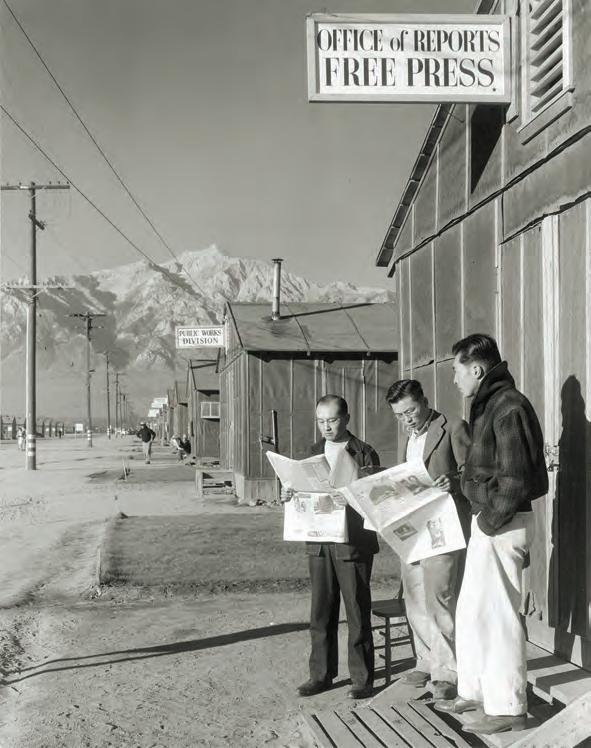

Life in These United States
Clockwise from above: Roy Takena, editor (left) and members of the camp newspaper staff outside the periodical's offices; from left high school biology students Kiyo Yoshida, Lillian Wakatsuki, and Yoshiko Yamasaki; elementary schoolgirls hanging out on a frigid winter day.

ran until Christmas Eve—but without enjoying pride of place. The museum, bowing to anti-Japa nese hostility, barred use of the main exhibition space. The photographs were relegated to the museum’s auditorium galleries.
In a press release, Newhall endorsed docu mentary photography as a tool for healing racial divides: “ With the coming of peace, photogra phers will undoubtedly play an increasingly sig nificant role interpreting the problems of races and nations one to another all over the postwar world.” Adams, she wrote, had taken on that task and was avoiding “the formulas that have devel oped in documentary and reportage photogra phy... has approached his subject with freshness and spontaneity.”
In time, Newhall was proven correct, but in the
WINTER 2023 47 LIBRARY OF CONGRESS (3) LIBRARY OF CONGRESS
AMHP-230100-ANSELADAMS-BW.indd 47 9/26/22 10:49 AM
Take Me Out to the Ball Game
On a balmy afternoon and against a dramatic backdrop, teams pursue the national pastime in front of an attentive crowd of Americans being held against their will behind barbed wire.

short term an America at war was not ready to reconcile with anyone. The exhibition received little media attention. The New York Times bur ied a short paragraph about the opening on page 17 of a Friday edition but ran no review.
AS ADAMS WAS PREPARING for his MOMA show, Tom Maloney, publisher of the U.S. Camera magazine, offered to publish the Manzanar port folio as a book. Debuting on the exhibition’s heels, Born Free and Equal developed the show’s theme; namely, that those behind the wire at Manzanar and other relocation camps were American citi zens, legally indistinguishable from counterparts going about their lives. The book—“the story of loyal Japanese-Americans”—invoked the 14th Amendment’s declaration that all persons born or naturalized in the United States are citizens and shall not be deprived of “life, liberty, or
property, without due process of law.” Adams also quoted Abraham Lincoln: “As a nation we began by declaring that ‘all men are created equal.’ We now practically read it ‘all men are created equal, except Negroes.’ When the Know-Nothings get control, it will read ‘all men are created equal, except Negroes and foreigners and Catholics.’ When it comes to this, I shall prefer emigrating to some country where they make no pretense of loving liberty.” His choice of Lincoln’s remarks suggest Adams regarded the internment of Japanese American citizens as a threat to democracy and a refutation of American ideals.
A turn of the page revealed Manzanar resident Yuri Yamazaki, grinning into the camera, her portrait cropped so that her face fills the frame. She could be any reader’s daughter. Adams captioned the image, “An American School Girl.” There followed a portrayal in words and pictures of a cross-sec tion of American life—newspaper editors, farmers, soldiers, doctors and nurses, accountants and electricians. Subtract the guards and barbed wire, and the reader would find a community that, in nearly every way, was indis tinguishable from any American town. To hate this population was as irra tional as hating your own neighbors. “Americanism is a matter of mind and heart,” Adams wrote beneath one of his photographs.
Other than his opening references, Adams refrained from commenting directly on the relocation action, though he also quoted Manzanar director Ralph Merritt: “I have not said that the evacuation was JUST, but that it was JUSTIFIED.” Adams chose not to litigate. “Our problem now is not to jus tify those things which have occurred, but to establish a new and civilized rationale in regard to these citizens and loyal supporters of America,” he
AMERICAN HISTORY48 LIBRARY OF CONGRESS LIBRARY OF CONGRESS (3)
AMHP-230100-ANSELADAMS-BW.indd 48 9/26/22 10:49 AM
wrote. “To do this we must strive to understand the Japanese-Americans, not as an abstract group, but as individuals of fine mental, moral and civic capacities, in other words, people such as you and I…I want the reader to feel that he has been with me in Manzanar, has met some of the people, and has known the mood of the Center and its environment.”

BORN FREE AND EQUAL was not a success.
“It was poorly printed, publicized, and distrib uted, perhaps to be expected in wartime,” Adams wrote. Distribution was spotty; Ansel accused his publisher of printing too few cop ies. Even so, the book attracted admirers. First Lady Eleanor Roosevelt praised it in her newspaper column: “In case you have not seen it, there is a publication by the United States Camera Publish ing Corp. which is worth your looking through...it is one of the publications designed to temper one of our prejudices, and I think it does it very success fully.” Copies of the first edition regularly appear on offer online, some sell ing for hundreds, even thousands of dollars.
After the Supreme Court ruled detention of loyal Japanese American cit izens illegal (In re Mitsuye Endo, December 18, 1944), the Pittsburgh Press published a full-page montage of Adams’s Manzanar photos and captions. “The recent order permitting the return of loyal Japanese-Americans to the West Coast brings to an end an unprecedented and poignant chapter in American History,” the afternoon daily declared in an editorial. “After many months of adjusting themselves to camp life, the Nisei must now try as best as they can to shuffle their way back into the stream of American life.”
Adams’s advocacy enraged many countrymen; reports circulated of bookstore customers buying copies of Born Free and Equal in order to burn them. Angry letters accused him of disloyalty, some sent by parents of sons lost in the Pacific theater of operations.
“They were bitter and incapable of making objective distinctions between the Nisei and Japanese nationals,” wrote Adams. “How can you adequately reply to a couple who lost their three sons in the Pacific War?”
Adams also drew fire from friendly quarters. Dorothea Lange derided his project as a whitewash, softening the horror of unjust incarceration with beautiful pictures. In a 1961 interview, Lange faulted Ansel for being igno rant when it came to social justice issues, although she admitted that Born Free and Equal had been a big step for him.
Modern historians tend to echo Lange’s critique, categorizing Ansel’s effort as little more than government propaganda and accusing him of doing far too little for the residents of Manzanar.
These anachronistic readings overlook two points. Although scholars applaud Lange’s adversarial stand against the government, her intransi gence resulted in the censorship of her photography. Her work was not pub lished until after the war ended. As an advocate for an oppressed minority, Lange was a failure. Adams’s images enjoyed a MOMA show, were printed in newspapers, and circulated in a book. It was Adams, not Lange, who shaped opinion and won sympathy for Manzanar’s residents.
Adams had little to gain and much to lose by inserting himself into the relocation debate. Wartime America remained virulently hostile toward the Japanese. It took great moral courage to wade into the hysteria and align with the supposed “enemies” interned at Manzanar, a choice that could have blighted the rest of his career. Knowing his unpopular stand threat ened both reputation and livelihood, Ansel Adams still took the difficult path, striking a blow against injustice and irrational prejudice. H
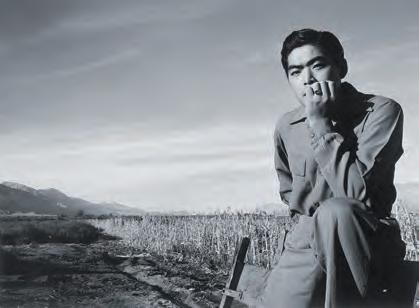
Pressing On
From top, Manzanar resident Tom Kobayashi, schoolgirl Yuri Yamazaki, and photos and mementoes atop a phonograph at the home of the Yonemitsu family. Adams strove in his coverage to penetrate to the humanity of the people whose mistreatment he was recording.

WINTER 2023 49 LIBRARY OF CONGRESS LIBRARY OF CONGRESS (3)
Angry letters, some from parents of sons lost in the Pacific theater of operations, accused Adams of disloyalty.
AMHP-230100-ANSELADAMS-BW.indd 49 9/26/22 10:50 AM
OutLighting for the Territory
By Mike Coppock

PHOTO CREDIT
The Popular Image Lewis and Clark, in boat at right, on the lower Columbia. The Corps of Discovery had plenty of company out west, some friendly, some not.
Lewis and Clark were not alone in penetrating Louisiana
AMHP-230100-EXPEDITIONS.indd 50 9/26/22 11:19 AM

PHOTO CREDIT WINTER 2023 51 AMHP-230100-EXPEDITIONS.indd 51 9/26/22 11:39 AM
n a hot day in September 1806, with flags flying, Lieutenant Facundo Melgares led some 300 Spanish army troopers and New Mexico militia men into a large Pawnee camp on the Platte River in what is now Nebraska. Melgares, whose force had set out three months before from the provincial capital, Santa Fe, had orders to intercept and arrest certain Americans known to be traveling unlawfully in Spanish territory and said by an American informer to be descending the Missouri River. The American trespassers’ names were Wil liam Clark and Meriwether Lewis.
Melgares had departed Santa Fe on June 15 with 105 Spanish regulars, 400 New Mexican militiamen, and 100 American Indians. At the Arkansas River near present-day Larned, Kansas, Melgares left 240 men with instructions to build a fort; he led the rest of his contingent north on the king’s busi ness. He had to tread lightly. His orders were to keep the peace with the Pawnee at all costs.
Unbeknownst to Melgares, at that moment Lewis and Clark were 140 miles east, sailing down the Missouri River toward the frontier town of St. Louis. At his village, Pawnee Chief White Wolf refused to let the Spanish continue, seemingly ready, Melgares thought, to fight if pressed. Melgares could only persuade the Paw nee to fly Spain’s flag exclusively and keep Americans off their lands. He arrested two French trappers found in the village for trespassing. Around Sep tember 11, captives in tow, he made for Santa Fe.
Unaware they were targets, Lewis and Clark proceeded to St. Louis, there ending a 29-month round-trip odyssey to the Pacific.
Melgares and his men made up the last of four Spanish forces sent to arrest Lewis and Clark. Each contingent just missed its assigned troop of Americans, whether it was traveling up the Missouri or bound back to St. Louis. The Spanish considered these ventures evidence of espi onage and meant to stop all four.
The American troops were following President Thomas Jefferson’s orders to map the acreage acquired when the United States bought the Louisiana Territory in 1803 from France. Spain, however, viewed that deal as illegal because in 1863, at the end of the Seven Year’s War between France and Britain, France had signed the land over to the Spanish crown to ensure that Britain didn’t grab the prize.
The Spanish pursuit of Jefferson’s expeditions is a chapter in the emergence of the young United States as a continental nation, pushing at its borders and testing Spain’s claim on the Louisiana Territory, itself a vestige of the sprawling Seven Years’ War.

Lands west of Appalachia were filling with enterprising settlers open to
gain wherever it might arise. Jefferson’s drive col lided with the perfidy of two of his peers—one an effective army commander later called a “mam moth of iniquity” during a trial for corruption; another a political rival with his own land-grab bing ambition—and courted war with Spain.


IN ITS EFFORTS TO THWART the Americans, Spain had a mole in the Jefferson administration who was on its side. Secretly working for the Spanish, General James Wilkinson leaked details on each westward lunge. Wilkinson was addicted to scheming. As a Revolutionary War officer, he had joined in the plot to remove Command er-in-Chief George Washington. As second in command of the Legion of the United States for the reinvasion of the Old Northwest, Wilkinson maligned his boss, legion commander Anthony Wayne, hoping to replace Wayne. In 1787 Wilkin son offered Spain his services as a spy helping to get the western states to secede. He began report ing to Spanish handlers in New Orleans in 1794 but hadn’t had much involvement in the leadup to Jefferson’s westward expedition. When Jeffer son took office as president in 1801, Wilkinson was senior Brigadier General. Soon after buying Louisiana, Jefferson placed frontier forces under Wilkinson’s command. Wilkinson hastened to get back on Spain’s payroll, demanding pay for his

AMERICAN HISTORY52
LIBRARY OF CONGRESS GL ARCHIVE/ALAMY STOCK PHOTO; EVERETT COLLECTION/SHUTTERSTOCK (2)
O
Lewis
Jefferson
Clark
AMHP-230100-EXPEDITIONS.indd 52 9/26/22 11:40 AM
inactive years and a retainer for services to be rendered. Fearful of Americans flooding their provinces, Spain settled 12,000 gold pesos on Wilkinson as back pay and agreed to a $4,000 annual stipend.
In gaining nominal title to Louisiana, Jef ferson had acquired the land adjoining New Orleans and St. Louis—plus the preemptive right to obtain Native American lands in Louisiana by treaty or force to the exclusion of other colonial powers. Spain administered the west bank of the Mississippi south from St. Louis but had no problem with the Amer icans assuming control of that side of the river, which seemed inevitable. Since 1799 Daniel Boone and Henry Dodge had been leading American settlers to St. Louis, becoming such presences that Spanish authorities made Boone and other Americans judges there. Spain did object to American claims on lands further west. Spain had bled for these expanses, a gateway to gold and silver deposits in what is now Arizona, New Mexico, Colorado, and California. The United States had practical reasons for buying Louisiana: the port of New Orleans, and control of the Mississippi. But American revolutionaries like Washington and Jefferson envisioned the new nation stretching to the Pacific. Louisiana offered an overland route to the western ocean.
THE FIRST AMERICAN ATTEMPT at traversing the continent came the year that America won independence. Learning in 1783 of British intent to send a party across the continent, Jefferson asked General George Rogers Clark about trying to beat the British west with a large force. Clark argued
The Path They Took
The Lewis and Clark Expedition managed by quirks of timing and route to avoid Spanish forces that were pursuing the Americans as unwanted interlopers.
that a martial display would anger Native tribes. Send three to four men, he said. In 1790, Secre tary of War Henry Knox sent Lieutenant John Armstrong to see what was beyond the Missis sippi; underfunded, he stopped at the big river. In 1793, the American Philosophical Society took a run at the Pacific, funded partly by President George Washington, financier Robert Morris, and Secretary of the Treasury Alexander Hamilton. Jefferson named French botanist André Michaux its leader. To avoid nettling the Spanish, the gov ernment told Michaux to cross the Mississippi north of St. Louis. He and his men set out in June, but when Michaux was revealed to be a French agent assigned to attack Spanish positions along the Mississippi, Jefferson scrapped the project and sent Michaux back to France. American dreams of the Pacific lapsed until Alexander Mackenzie, a Scot working for the North West Company of Canada, reignited that ardor in 1793. Mackenzie became the first European to cross the continent north of Mexico and reach the Pacific, painting his name in red on a rock along the Canadian coast.

WINTER 2023 53 LIBRARY OF CONGRESS GL ARCHIVE/ALAMY STOCK PHOTO; EVERETT COLLECTION/SHUTTERSTOCK (2)
Spain made Boone a judge in St. Louis, but objected to claims that Americans were making on lands lying further west.
AMHP-230100-EXPEDITIONS.indd 53 9/28/22 2:52 PM
Breaking an Overland Trail to the Western Ocean
In 1793 the Scot Alexander Mackenzie, an operative of the North West Company, reached the Pacific shore, becoming the first European to cross the North American continent above Mexico.
In 1802, thanks to social connections, outdoorsman and former soldier Meriwether Lewis was President Jefferson’s secretary when his boss obtained a copy of Voyages from Montreal, Mackenzie’s account of his feat. In the 1801 volume, the explorer urged Britain to develop a land passage across North America. That incitement and the image of a rock daubed in red transfixed Jefferson. He said he would soon be send ing Lewis on just such a quest. Jefferson sounded out Spain’s ambassador on whether a Pacific-bound expedition crossing Spanish holdings would sit well with the king. Ambassador Carlos Martinez de Yrugo said Spain would view such efforts as a hostile act, even if the ostensible point was only to map unknown territory.
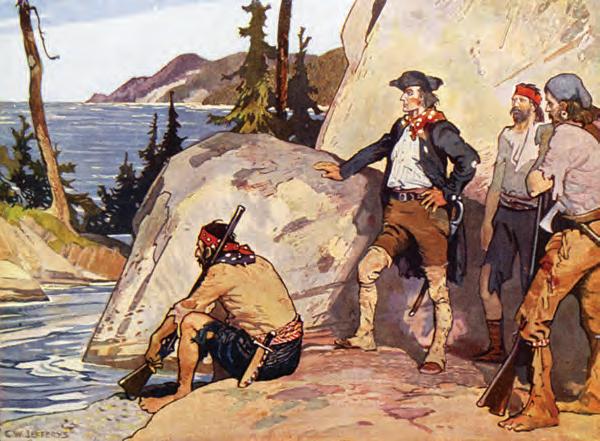
THE MYSTERIOUS EXPANSE fired Jefferson’s curiosity. Lewis’s instructions from Jefferson for the journey included looking for Welsh descendants from Prince Madoc’s 1170 expedition to the New World, hunting for mammoths, and collecting evidence that Native Americans were human beings. Jefferson did know that the Rocky Mountains were the source of most of the rivers feeding the Missis sippi from the west. Working with Captain Rob ert Gray’s 1792 discovery and precise mapping by longitude and latitude of the mouth of the Columbia River along North America’s Pacific Coast, Jefferson acquired a rough idea of the dis tance between the east coast and the west coast as a crow flew. Spanish fur traders had been trapping and bargaining for skins on the upper reaches of the Missouri River for decades. In 1795 Spanish merchants in St. Louis sent an expedition up the Missouri seeking a route to the Pacific. Two years later the exploratory party returned with detailed maps of the Missouri. By 1802, Spain had installed 11 trading posts on the Upper Missouri.
When French officials offered American negoti ators all of Louisiana in 1803, Jefferson grabbed it. The deal dovetailed perfectly with his aspirations for an overland route to the Pacific Ocean. Jeffer son ignored a festering decades-old border dispute over whether the Sabine River marked the border between French and Spanish holdings. The French said it did, while the Spanish claimed the border was further east within the Mississippi drainage.

Jefferson hurriedly assigned four expeditions to explore particular aspects of Louisiana. Lewis, with George Rogers Clark’s younger brother Wil liam and a few men, would go up the Missouri and head west for the Pacific.

A second party would explore the length of the Red River, previously the northern boundary separating the Spanish province of Texas from Louisiana and now the new southern border sep arating the United States and New Spain. Jeffer son wanted to know if the Red River ran west to Santa Fe in New Mexico. The third expedition would travel up the Kansas River and onto the Great Plains, hunting the Red River’s source. A fourth expedition would travel up the Arkansas River mapping that waterway.
LEARNING OF JEFFERSON’S expeditionary plans, Wilkinson, Spanish secret agent and com mander of American forces on the frontier, alerted his Spanish handlers. Ever the conspira tor, Wilkinson also had signed onto former Vice President Aaron Burr’s scheme to grab part of lower Louisiana, merge it with a few northern provinces of New Spain, and form a new nation.
Jefferson explicitly ordered Lewis to avoid Spanish settlements. When intelligence sug gested the Arkansas River expedition, set for 1804, would encounter Spanish troops, Jefferson canceled it. By this time Lewis and Clark were two months into their trip up the Missouri. That was when Wilkinson squealed to the Spanish, suggesting they intercept the men of the Corps of Discovery and repel or arrest them.
Nemesio Salcedo, commandant general of the Internal Provinces of New Spain, headquartered in Chihuahua, worried that “Captain Merry” intended to “penetrate the Missouri River in order to fulfill the commission which he has of making discoveries and observations.” Salcedo feared “Merry’s” discoveries would include pin pointing Spain’s gold and silver mines in the mountainous West. Salcedo sent Pedro Vial north after the American explorers three times. Vial was too early to the Pawnee village and had been gone a month when, slowed by a slow spring melt on the frozen Missouri, Lewis and Clark reached the mouth of the Platte on July 21. Vial left Santa Fe on his second foray on October 5, 1805, with 100
AMERICAN HISTORY54 ED VEBELL/GETTY IMAGES LOOK AND LEARN/BRIDGEMAN IMAGES; NATIONAL PORTRAIT GALLERY; IANDAGNALL COMPUTING/ALAMY STOCK PHOTO
Wilkinson
Burr
AMHP-230100-EXPEDITIONS.indd 54 9/28/22 2:52 PM
Poling in the Missouri Shallows
men, but they clashed with Native warriors while crossing the Arkansas River in today’s eastern Colorado and turned back. In his third attempt, Vial left in April 1806, again turning back owing to desertions in the ranks. Now Salcedo sent Mel gares, who chose to maintain peace with the Paw nee rather than chase Lewis and Clark.
FIVE MONTHS AFTER Lewis and Clark left St. Louis for the west, Jefferson approved a smaller expedition up the Ouachita River by way of the Red River. That undertaking was headed by Dr. William Dunbar, a friend of Jefferson’s who had been set to lead the aborted Arkansas expedition. Dunbar, keen to find a medicinal hot spring said to be in the unexplored region, pitched his idea to Jefferson rather than going through Wilkinson. Jefferson approved the plan through a personal letter to Dunbar with the promise of funding, again leaving Wilkinson out of the loop.
Along with chemist George Hunter, the Dun bar party consisted of 13 soldiers, Hunter’s teen age son, Dunbar’s two slaves, and Dunbar’s servant. The expedition left St. Catherine’s Land ing on the east shore of the Mississippi on Octo ber 16, 1804. The men were aboard a boat designed by Hunter and built in Pittsburgh, Pennsylvania, months earlier. The team quickly realized the craft, a “Chinese-style vessel,” drew too much water for the shallow rivers they were
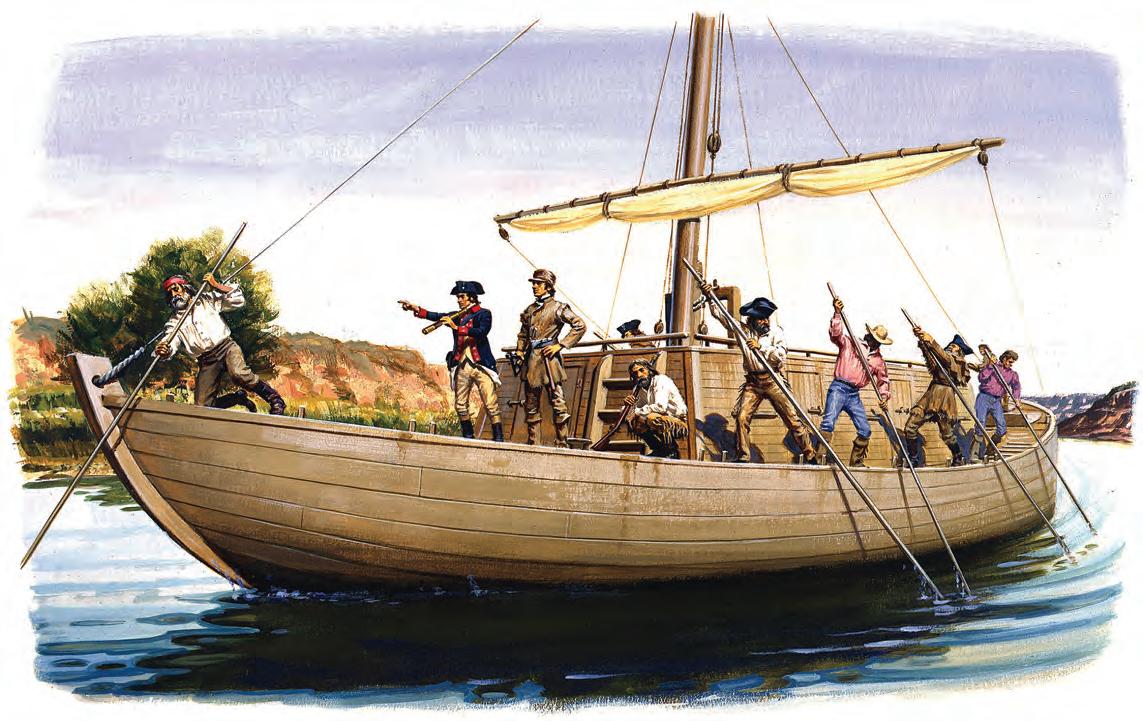
traveling, but they bumped upstream on the Red River, onto the Black River, and finally the Ouachita, which brought them to the storied medicinal waters—today’s Hot Springs, Arkan sas. Hunter made studies on water quality while Dunbar calculated the rate of discharge of the springs. The degree to which the supposedly empty area had been settled amazed Dunbar. Cabins harboring American, French, Spanish, and Native trappers surrounded the springs.
On their return traversing the New Orleans Territory to Fort Miro (now Monroe, Louisi ana), Dunbar himself hurried overland to Washington, DC, bringing along with him flora and fauna samples and maps that he delivered to his pal, the president, the first substantial information from one of Jeffer son’s expeditions. The remainder of the expedition returned by boat in Jan uary 1805. The Spanish had not interfered.
JEFFERSON NOW WANTED the seasoned Dunbar to lead the Red River expedition. He told Dunbar to obtain passports from Spanish officials since the expedition would be traveling near Spanish Texas. In New Orleans, the Marquis de Casa Calvo, former Spanish governor of Louisiana, issued pass ports but told the Americans he could not override Spanish authorities in Texas if the Tejanos chose not to honor the passports. Dunbar decided not to go. Command went to Thomas Freeman, who had helped survey the line between the United States and Spanish Florida. Peter Custis, a trained natu ralist with a medical background, signed on as second in command. When intelligence reports warned of possible encounters with Spanish troops, U.S. Army Captain Richard Sparks, two junior officers, and 17 enlisted men were
WINTER 2023 55 ED VEBELL/GETTY IMAGES LOOK AND LEARN/BRIDGEMAN IMAGES; NATIONAL PORTRAIT GALLERY; IANDAGNALL COMPUTING/ALAMY STOCK PHOTO
Calvo told the Americans he had no power to override any Tejano decision not to honor the passports the Spanish had issued them.
In May 1804 the Corps of Discovery was on the Missouri River in a keelboat whose sail often had to be reefed in favor of men using poles.
AMHP-230100-EXPEDITIONS.indd 55 9/26/22 11:41 AM
Meeting Across the River
In 1805, Pike, at the time leading a water-borne exploratory party, encountered Indians at the headwaters of the Mississippi River.
assigned to the venture. The Freeman party left Natchez, Mississippi, on April 19, 1806, traveling up the Red River in two barges and a native canoe. Because a border dispute with Spain along Louisiana’s Sabine River was heat ing up, the expedition took on more soldiers until Spark had 45 men.
Owing to snags and logjams, the expedition needed a month to reach Natchitoches, Louisiana, and two months more to clear the Red River Raft, a massive natural logjam, and the Great Bend of the Red River. The crawl up the Red gave Wilkinson and Calvo time to alert Spanish territorial officials of the expedition, just as Jefferson was praising the project to Congress. To stop Freeman and company, Spain sent Captain Francisco Viana, newly appointed commander of the Nacogdo ches garrison in east Texas. Viana and his men rode hard north. On July 28, some 615 miles upriver, the American explorers began hearing Spanish guns. Freeman asked to parley. Viana said he had orders to fire upon any foreign troops in Spanish territory. Freeman demanded Spanish objections be put in writing and the name of the official who had sent Viana to stop him. Viana refused. Three days passed. Freeman gave in, claiming he wanted to avoid an interna tional incident. The Red River Expedition headed downriver, embarrassing Jefferson and tickling Burr and followers.

AS A RESULT OF THE SABINE RIVER DISPUTE with Spain, war clouds gathered. Wilkinson began assembling an expedition to find the Red River’s source. Lieutenant Zebulon Pike, 27, had returned to St. Louis on April 30, 1806, from a separate quest, having spent nine months searching for the source of the Mississippi River and informing British traders in what would become Minnesota that they were trespassing. Pike had identified the wrong lake as the mighty river’s source, but no one would know that for decades. The President praised young Pike in his December 1806 message to Congress.
On his own, Wilkinson promoted Pike to captain and assigned him a new challenge. Starting in mid-July, Pike was to cut across the Great Plains to
the Rockies to find the Red River’s source.
Locals in St. Louis, where it was held that the Red rose on the plains, scoffed, noting that Pike’s schedule would put him in the Rockies during winter. Jefferson told Pike to avoid New Mexico, but Wilkinson had ordered him to get as close to the Spanish settlements as he could with Dr. Rob inson, a confidant of Aaron Burr. Wilkinson made his son James Biddle Wilkinson second in com mand. The 23-man Pike expedition left on July 15 with 59 Osage hostages Pike was to drop off at the nearest Osage village in what is now Kansas.
Wilkinson did not see Pike off; the Sabine River crisis had pulled him to New Orleans. But earlier the general had written Pike that if caught by the Spanish near Santa Fe he should claim to have gotten lost. Within weeks of Pike’s casting off, Governor Salcedo in Chihuahua City learned from his agents in St. Louis and from Wilkinson of the Pike expedition’s departure.
PIKE REACHED AN OSAGE VILLAGE in east ern Kansas a month later, delivering the hostages as a goodwill gesture from the U.S. government. He then marched for the Pawnee village on the Platte River in central Nebraska. He and his force arrived September 29, missing the hapless Mel gares and his troops by several weeks. Seeing the Spanish flag over Chief White Wolf’s teepee, Pike asked for a tribal council. Pike told the Pawnee they were now under the protection of the United States and were to lower the Spanish flag.
When White Wolf learned that Pike planned to proceed west, he forbade the American to take that direction, just has he had forbidden Mel gares to go east. Pike was not worried about keep ing the peace with the Pawnee. If anything, he was spoiling to project American power.
Pike told the chief his men were well armed and that if anything befell them, the United States would avenge their deaths. He then marched west for the Arkansas River, in two days finding a campsite the Melgares force had left. Pike counted 59 fires. The thought occurred to Pike that Melgares knew where he was going, while Pike did not. The American explorer decided to follow the Spanish soldiers’ trail.
As Pike and his men were following Melgares’s trail, Wilkinson’s troops were clashing with Spanish troops along the Sabine River. Without Jefferson’s permission, Wilkinson had signed an understanding with his Spanish counterpart, Lt. Colonel Simon de Herrera, for the withdrawal of U.S. and Spanish forces from the Sabine River to avoid war. But Jefferson accepted the under standing because it created neutral ground between the U.S. and Spain. From 1806 to 1821, the neutral strip along the Sabine was a de facto
AMERICAN HISTORY56 MPI STRINGER/GETTY IMAGES; INTERIM ARCHIVES; SMITHSONIAN INSTITUTION ULLSTEIN BILD/ULLSTEIN BILD VIA GETTY IMAGES
It occurred to Pike that Melgares knew where he was going, and Pike did not. Pike decided to follow him.
AMHP-230100-EXPEDITIONS.indd 56 9/28/22 2:53 PM
demilitarized zone that besides helping to avoid direct confrontations between Spain and the U.S. over the Jefferson-appointed incursions was a haven for outlaws and smugglers. Its creation also marked a change of direction for Wilkinson. He decided Aaron Burr and his grandiose plans for a new nation were a dangerous liability, but Wilkinson was not yet through scheming.
Two weeks of hard riding brought the Pike expedition to the banks of the Arkansas River. Near present-day Coolidge, Kansas, by the Colo rado border, Pike split his force. Young Wilkinson would follow the Arkansas River downriver to civilization with five men while Pike’s group and Robinson would continue upriver.

On December 3, near present-day Pueblo, Col orado, Pike noted that Melgares’s trail suddenly had turned south, apparently taking him to Santa Fe. Instead of following, Pike continued up the Arkansas, roaming the Rockies through snow for a month before crossing the Sangre de Cristo Mountains into the San Luis Valley in what is now Colorado. Locating the upper reaches of the Rio Grande, Pike built a small fort on January 31, 1807, on the west bank of the Rio Grande, in terri tory undisputedly Spanish.
From there, Dr. Robinson proceeded south alone for Santa Fe. Spanish troops arrested him two weeks later as they rode north to confront Pike. Aaron Burr was arrested at approximately the same time in Alabama on charges of treason. Wilkinson had turned him in.
The night of February 26, Spanish troops stormed Pike’s Fort, arresting him and his men for spying. In Santa Fe, officials confiscated Pike’s notes and maps. After being questioned, the Americans were given travel money and allowed to keep their unloaded weapons.
Melgares and troops escorted them to Los Coa bos, the capital of Chihuahua. After interrogating Pike and his men, Governor Salcedo had an armed
escort take them to the Louisiana border.
AS SPANISH TROOPS were taking Pike to the border, an American named Burl ing was making his way overland from Louisiana to Mexico City, telling Spanish authorities he had come to buy mules. He also carried a letter from Wilkinson to the Viceroy of New Spain. In the letter Wilkin son demanded $100,000 in cash. After all, he had prevented an invasion of Mexico by Burr and saved Spain from a costly war with the United States. The Viceroy gave Burling neither the money nor the mules.
Pike reached the United States on July 1, 1807. In 1813, during the War of 1812, he died at York, Upper Canada, when retreating Brit ish troops blew up an ammunition magazine. Meriwether Lewis had died of gunshot wounds in 1809, either by his own hand or murdered.
William Clark went on to serve as territorial governor of Missouri until 1822, when President James Monroe named him Superintendent of Indian Affairs, a post he held until his death in 1838. Jefferson’s protégé William Dunbar pio neered ways to make use of cottonseed oil and other improvements to plantation economies before dying on his plantation in 1810. Thomas Freeman, who had taken over Dunbar’s expedi tion, died in 1821 after forsaking his career as explorer and surveyor to become an astronomer.
General James Wilkinson was ordered court-martialed by President James Madison for his role in the Burr conspiracy; a military tribu nal acquitted him. He was later appointed as the U.S. Envoy to Mexico in 1821. Wilkinson died in Mexico City in 1826, possibly from an overdose of laudanum. He was 68. Suspicion persisted that he was spying for Spain, but not until 1854 did correspondence discovered in that nation's archives confirm Wilkinson’s skullduggery. H

Daredevil Zebulon Pike, above left, alongside a map showing portions of the route he took during his 1805-06 expedition into New Spain. Above, a compass used by Lewis and Clark.

WINTER 2023 57 MPI STRINGER/GETTY IMAGES; INTERIM ARCHIVES; SMITHSONIAN INSTITUTION ULLSTEIN BILD/ULLSTEIN BILD VIA GETTY IMAGES
AMHP-230100-EXPEDITIONS.indd 57 9/28/22 4:22 PM

PHOTO CREDIT AMERICAN HISTORY58 AMHP-230100-WHITE.indd 58 9/28/22 4:23 PM
White Power
Lynching investigator Walter White risked everything to tell Americans the truth
 By Peter Carlson
By Peter Carlson
PHOTO CREDIT
Epidemic Violence Outside Okema, Oklahoma, bystanders pose on May 25, 1911, for a souvenir photo with the corpses of lynching victims Lawrence and Laura Nelson.
AMHP-230100-WHITE.indd 59 9/28/22 4:23 PM
Riding the bus from his Harlem boardinghouse to his new job in downtown Manhattan on a frigid February day in 1918, Walter White skimmed the morning papers until he came to a headline that read “Negro Burned at Stake.”
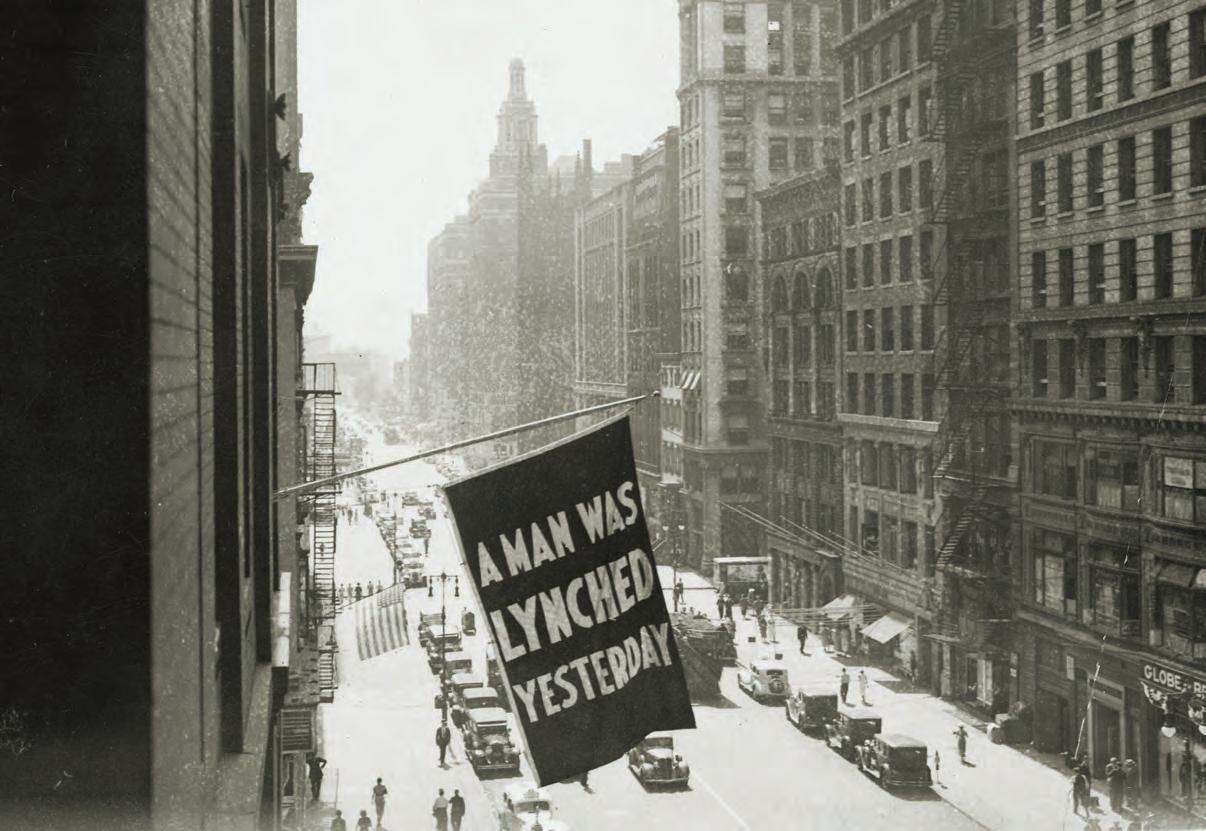
The accompanying article was short but horrific:
“Estill Springs, Tenn. Feb 12—Jim McIlherron, a negro who shot and killed two white men here last Friday, was burned at the stake here tonight after a confession had been forced from him by application of red hot irons…The prisoner was taken out of town, chained to a tree, tortured until he confessed, implicating another negro, and then was burned.”
White showed the article around the office. Two weeks earlier, he’d taken a job as assistant secretary of the National Association for the Advancement of Col ored People, a nine-year-old civil rights organization. What, White asked his bosses, would the NAACP do about this grisly murder?
The group’s usual response to lynchings—dozens occurred every year—was to send a telegram of protest to state officials, followed by an angry press release. White, 24, had another idea. He volunteered to travel to
the scene of the crime in rural Tennessee to uncover the full story so the NAACP could reveal all the grisly details to the American public.
His bosses thought that was crazy. A Black man arriving in a small southern town to investigate a lynching was liable to get lynched himself.
But White persisted, arguing that he was per fect for the task. Although he was Black and had attended segre gated Black schools from first grade through college in his native Atlanta, he had light skin, blue eyes, and straight brown hair, leg acies of many Caucasian ances tors. He could easily pass for White, White argued, and on a pre vious job selling insurance he’d
The Graduate White graduated from Atlanta University at 16. He joined the staff of the National Association for the Advancement of Colored People two years later.

AMERICAN HISTORY60 NATIONAL MUSEUM OF AFRICAN AMERICAN HISTORY AND CULTURE; BETTMANN/GETTY IMAGES PREVIOUS SPREAD: FLHC2019/ALAMY STOCK PHOTO; THIS PAGE: LIBRARY OF CONGRESS; THE WALTER WHITE PROJECT
Reminder
Each time word of a lynching reached the NAACP, a simple, somber flag flew outside the group’s offices at 69 Fifth Avenue in New York City.
AMHP-230100-WHITE.indd 60 9/26/22 12:01 PM
traveled around Georgia, so he knew how to get along with rural southerners, Black and White.
A born salesman, White sold his bosses on his idea. Two days later, he boarded a train for Tennes see. The man who had signed up for a comfortable desk job in the NAACP’s Fifth Avenue headquar ters spent much of the next decade as an under cover detective, traveling the United States of America to investigate and chronicle more than 40 lynchings and race riots.

WHITE STEPPED OFF A TRAIN in Estill Springs, where Jim McIlherron had been killed, and rented a room in a White boardinghouse, tell ing the desk clerk he was a salesman for the Excel sior Medicine Company. He wandered to the general store where, he guessed, folks would be huddled around a potbelly stove, trading gossip. He was right, so he introduced himself, remarked on the weather, and sat down to chat.
Mentioning the Jim McIlherron matter would have aroused suspicion. When his new compan ions brought up the lynching, White pretended he’d never heard of it, then changed the subject. His feigned indifference only increased their eagerness to talk about the most exciting event they’d ever seen, and they soon were recounting the story in horrifying detail.
“By waiting for them to bring up the subject, which I knew would be inevitable, and by cautious questioning, I got all the information I needed,” White explained that evening in a letter he sent to his NAACP bosses. “Will tell story in detail when I return to office.”
White told the story in a shocking article for The Crisis, a 100,000-circulation NAACP monthly that famed Black scholar W. E. B. DuBois edited. Jim McIlherron had not been popular with Whites around Estill Springs, White wrote. A prosperous Black farmer who had lived awhile in Detroit, Michigan, McIlherron was disinclined to defer to Whites. On February 8, 1918, he came to town and bought 15 cents worth of candy. As he was strolling down the street eating it, three young White men began pelting him with rocks.
“Rocking” Blacks was a common amusement among Whites in Estill Springs, but McIlherron was not amused. He pulled a pistol and fired, kill ing two of the rock throwers.
McIlherron returned to his home, which he then fled on a mule, stopping at his minister’s house. A mob that had been chasing him shot the minister dead. McIlherron escaped, but not for long. Two days later, a posse captured him and brought him to Estill Springs, where more than 1,000 Whites had gathered.
“McIlherron was chained to a hickory tree,” White wrote. “Wood and other inflammable
material was saturated with coal oil and piled around his feet. The fire was not lighted at once, as the crowd was determined ‘to have some fun with the damned nigger’ before he died.”
White men heated iron bars in a fire until the ends glowed red, then pressed them against McIlherron’s neck and thighs. After 20 min utes of this torture, somebody used a red-ho McIlherron. He begged his tormenters to shoot him, but they refused, saying, “We ain’t half done with you yet, nigger.’
“By this time, however, some of the members of the mob had, apparently, become sickened at the sight and urged that the job be finished,” White wrote. “Finally, one man poured coal oil on the Negro’s trousers and shoes and lighted the fire around McIlherron’s feet. The flames rose rapidly, soon enveloping him, and in a few minutes McIlherron was dead.”
NOT LONG AFTER WHITE’S gruesome story ppeared in the May 1918 issue of The Crisis, its author headed to Georgia to investigate a series of lynchings even more horrible. Again posing as a salesman, White learned that the violence had arisen from Georgia’s infamous “convict leasing” system. Poor Blacks who had been convicted of minor crimes got a choice: pay a fine or go to jail. White landowners needing laborers would pay the fine if the convict agreed to work off the debt, a process that could take years. When Sidney Johnson, who was Black, was arrested for gam bling and fined $30, Hampton Smith, owner of a plantation near Valdosta, paid Johnson’s fine and worked him for months. When Johnson insisted he’d paid his debt, Smith beat him up. Two days later, Johnson shot Smith dead.
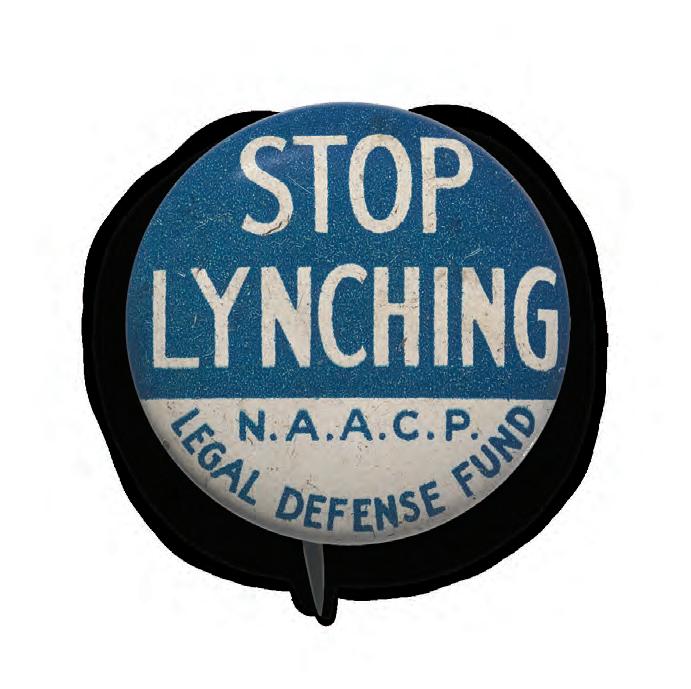
When news of the killing spread, a mob searched for Johnson without success. Frus trated, the revenge seekers hunted other Blacks known to have quarreled with Smith over working conditions. On Friday, May 17, a mob lynched two Black men, then fired hundreds of bullets into their corpses. That Saturday, mobs lynched three Black men and left their bodies hanging from trees. On Sunday, Mary Turner—eight months pregnant and widow of a mob victim— demanded that police arrest her husband’s killers. Irate, a mob hung Turner upside down, soaked her clothing in gasoline, and set it afire. As she was writhing in agony, a man sliced the fetus from her womb with a carving knife and crushed it beneath his shoe.
“I shall never forget the morning when I stood where Mary Turner was killed,” White wrote in a letter, “her grave marked by an empty quart whisky bottle with the stump of a cigar stuck in its mouth.”
White spent three days in the area, first listening to White folks’ accounts
WINTER 2023 61 NATIONAL MUSEUM OF AFRICAN AMERICAN HISTORY AND CULTURE; BETTMANN/GETTY IMAGES PREVIOUS SPREAD: FLHC2019/ALAMY STOCK PHOTO; THIS PAGE: LIBRARY OF CONGRESS; THE WALTER WHITE PROJECT
Planters who paid the fines of convicted Blacks could keep them in a harsh form of indentured servitude for as long as they liked.
W. E. B. DuBois
AMHP-230100-WHITE.indd 61 9/28/22 2:55 PM
Tortured and Burned to Death
The dark cloud billowing beneath the tree at the center of this image is coming from the mutilated corpse of a Black lynching victim. The archive from which it came provided no further information about the event.

of the lynchings then circulating among Blacks, identifying himself as an NAACP worker and hearing their stories. Later, he posed as a reporter for the New York Post—Post publisher Oswald Garrison Vil lard, a member of the NAACP board, had given him credentials—and interviewed Georgia’s governor, Hugh Dorsey, who denounced mob vio lence. But no one was ever arrested for the murders
The NAACP publicized White’s findings and newspapers published angry editorials. The out cry convinced President Woodrow Wilson, no friend of Blacks or of civil rights, that lynchings were undermining his efforts to portray America’s war with Germany as a moral crusade to “make the world safe for democracy.”

“Every mob contributes to German lies about the United States,” Wilson wrote in an anti-lynch ing proclamation in July 1918. “Every American who takes part in the action of a mob or gives it any sort of countenance is no true son of this democracy, but its betrayer.”
Wilson’s words were welcome; a presidential proclamation, however, had no legal power.
Determined to pass and enact a federal anti-lynching law, John Shillady, head of the NAACP, dispatched White to Washington to lobby for a bill to make lynching a federal felony. Despite the NAACP’s efforts, the proposal languished for years. In 1922, the House of Representatives passed an anti-lynching measure. Southern senators killed the proposed legislation with a filibuster. Filibusters dispatched anti-lynching bills in 1935, 1938, 1948, and 1949.
IN 1919, THE ATTORNEY GENERAL OF TEXAS announced that the NAACP could not operate in his state because the organization was not char tered in Texas and because its opposition to segregation violated Texas law. When John Shillady, the NAACP’s White executive secretary, traveled to Austin to meet the attorney general, eight men, including a local judge and two policemen, brutally beat him in broad daylight and put him on a north bound train. Texas Governor William Hobby defended the assault, calling Shillady a “narrow-brained, double-chinned reformer” guilty of “stirring up racial discontent.” Shillady never recovered. After several hospitalizations and brief attempts to return to work, he resigned. He died a year later.

White watched his boss’s deterioration with horror. He knew he might
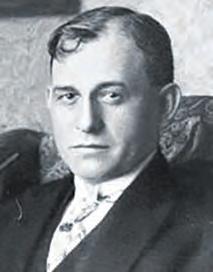
AMERICAN HISTORY62 ORANGE COUNTY REGIONAL HISTORY CENTER; LIBRARY OF CONGRESS LIBRARY OF CONGRESS/GETTY IMAGES; ATLANTA HISTORY PHOTOGRAPH COLLECTION; LIBRARY OF CONGRESS; THE UNIVERSITY OF MICHIGAN LIBRARY
Woodrow Wilson Hugh Dorsey
John Shillady
AMHP-230100-WHITE.indd 62 9/26/22 12:01 PM
meet a similar fate any time he investigated a lynching. But he persisted, traveling thousands of miles year by year to uncover and tell the stories behind racist mob terrorism.
“With his keen investigative skills and light complexion,” White’s biographer, Kenneth Robert Janken, wrote, “Walter White had proven to be the NAACP’s secret weapon against white violence.”
In 1919, White traveled to Shubata, Mississippi, to investigate the kill ing of four Black farmworkers, two of them young women. “The white people would not talk very much about the matter,” White wrote in a let ter to headquarters, but a Black preacher and a cousin of the female victims told him the sordid backstory.

All four victims worked on a farm owned by a White dentist who had impregnated both women, sisters Maggie and Alma Howze. One of the male victims, Major Clark, had begun dating Maggie Howze.
Killed Over a Vote Julius Perry was beaten and hanged by a White mob outside the house of a judge who had told a friend of Perry, a resident of Ocoee, Florida, that he had the right to vote.
That angered the dentist, who ordered Clark to end the relationship. When the dentist was murdered, police arrested the Howzes, Clark, and his 15-year-old brother, Andrew. At a police sta tion, cops stripped Clark, put his testicles in a vise and squeezed them until he confessed. A trial was scheduled, but never occurred because a mob dragged all four suspects out of jail and hanged them from a bridge over the Chickasawhay River.
“It will do great good,” White wrote to his bosses, “to let the world know that such a thing can and does happen in America.”
IN 1920, WHITE TRAVELED TO OCOEE, FLORIDA, a citrus-farming town near Orlando. A few days before, on Election Day, a White mob, angered that a black man had attempted to vote in the presidential election, had put a Black neighbor hood in Ocoee to the torch.

“I was regarded with very great suspicion,” White wrote in his report, “until I let it be known that I might be in the market for an orange grove.” Seeing dollar signs, White residents showed him farm properties and talked about the riot. Weeks before Election Day, the local Ku Klux Klan had proclaimed that no Black people would be allowed to vote. When Moses Norman, a prosperous Black citrus farmer, went to the polls, a White mob attacked him. Norman fled to the home of a friend, Julius Perry. The mob surrounded Perry’s house and set it aflame. Then the rioters burned the rest of the neighborhood, incinerating 20 houses, two churches, and a school, shooting Black residents as they were fleeing the flames. “The number killed will never be known,” White wrote in The New Republic. “I asked a white citizen of Ocoee, who boasted of his participation in the slaughter, how many Negroes died. He declared that 56 people were known to have been killed—and he said he’d killed 17 ‘niggers’ himself.”
That man was almost certainly exaggerating. But even now, nobody knows how many people died in the riot because nearly every surviving Black resident, possi bly including Moses Norman, quickly fled Ocoee. “At the time I visited Ocoee, the last colored family of Ocoee was leaving with their goods piled high on a motor truck with six colored children on top,” White wrote in an affidavit prepared for Florida officials. “White children stood around and jeered the Negroes who were leaving, threatened them with burning if they did not hurry up and get away. These children thought it a huge joke that some Negroes had been burned alive.”
WINTER 2023 63 ORANGE COUNTY REGIONAL HISTORY CENTER; LIBRARY OF CONGRESS LIBRARY OF CONGRESS/GETTY IMAGES; ATLANTA HISTORY PHOTOGRAPH COLLECTION; LIBRARY OF CONGRESS; THE UNIVERSITY OF MICHIGAN LIBRARY
Burning Black churches, homes, and a school, White rioters shot Blacks fleeing the fires. No count could be made of the dead.
AMHP-230100-WHITE.indd 63 9/28/22 2:55 PM
Walter White didn’t visit the scene of every lynching in America in the 1920s—more than 300 people were lynched during that decade—but he investigated dozens, including the bloodiest.
In June 1921, he traveled to Tulsa, Oklahoma, where rumors that a Black messenger boy had assaulted a White woman led mobs to burn more than 1,000 buildings in Greenwood, Tulsa’s Black neighborhood, killing between 100 and 300


White Riot
Above, the Greenwood district of Tulsa, Oklahoma, blazing as a result of a riot by White residents of that city over rumors of an assault on a White woman by a Black man. Left, Ku Klux Klan members parade in Orlando, Florida.
people (“What Was Lost,” December 2021). White arrived two days later and soon had managed to enroll in an otherwise allWhite posse. “Now you can go out and shoot any nigger you see,” a fellow posse member gleefully informed him, “and the law’ll be behind you.”
WHITE’S ACCOUNTS OF LYNCHINGS ran in the New York Post, the Chicago Daily News, The Nation, and The New Republic. He also testified before congressional committees. But his favorite venue for telling his stories was in appear ances before Black audiences across America. In those pre sentations, White did not ignore the inescapable horrors of his subject, but he preferred to emphasize the comedy of his role when conducting an investigation: He was a small, bespectacled Black man who posed as White and repeatedly bamboozled racist rubes into revealing their foul deeds.
“Black men and women filled the halls and lodges and churches where he appeared, laughing along with his tales of fooling the white man on their behalf,” Thomas Dyja wrote in his 2008 biography of White. “With these sto ries, White created a character, a skinny young black trickster who walked into the teeth of danger in the name of justice and who came out not only alive but laughing.”
AMERICAN HISTORY64 AFRO NEWSPAPER/GADO/GETTY IMAGES; NATIONAL MUSEUM OF AFRICAN AMERICAN HISTORY AND CULTURE LIBRARY OF CONGRESS; ORANGE COUNTY REGIONAL HISTORY CENTER
AMHP-230100-WHITE.indd 64 9/26/22 12:02 PM
Unfortunately, no recording or transcript of any of those speeches exists. But “I Investigate Lynchings,” an essay White wrote for H.L. Menck en’s American Mercury magazine in 1929, pro vides a hint of his comic style.
“Nothing contributes so much to the continued life of an investigator of lynchings, and his tran quil possession of all his limbs, as the obtuseness of the lynchers themselves,” White wrote. “Like most boastful people who practice direct action when it involves no personal risk, they just can’t help but talk about their deeds to any person who manifests even the slightest interest in them… They gabble on ad infinitum, apparently unable to keep from talking.”

“With his high-pitched voice, love of a joke and relentless energy, his speeches were entertain ment of a high order,” Dyja wrote. “When the audience left, they told their neighbors the stories they’d heard from this charac ter Walter White, who tricked out lynch ers for the NAACP.”
WHITE DIDN’T SPEND all his days nvestigating lynchings. He continued working in the NAACP office, attending to paperwork, dealing with local chap ters, organizing conferences. In 1922, he married Gladys Powell, an NAACP ste nographer, and soon fathered two chil dren. He wrote two novels of Black life—Fire in the Flint and Flight—and participated in the artistic movement known as the Harlem Renaissance.
In 1927, White received a $2,500 Guggenheim fellowship to spend a year abroad while writing another novel. He moved his family to the French Riviera, but he didn’t write the novel. Instead, he wrote what he described as “a study of the complex influences—economic, political, social, religious, sexual—behind the gruesome phenomenon of lynching.”
He titled the book Rope and Faggot. Citing his own work and statistics gathered by scholars, White disputed the notion that most lynchings were responses to claims that Black men had raped or propositioned White women. Such alleged incidents accounted for less than 30 per cent of lynchings and, White argued, most inter racial sex was consensual. Far more often, a lynching ’s cause was economic—to keep Black farmworkers subjugated or to punish prosperous African Americans. And most mob killings occurred in small, backward, rural towns where, White noted sarcastically, “lynching often takes the place of the merry-go–round, the theatre, the symphony orchestra and other diversions com
Relentless White, above testifying before Congress on February 24, 1934, was small and slight but had a lion’s heart. His digging into the plague of terrorist lynchings helped steer the NAACP toward a more pronouncedly activist stance on the grim topic.
mon to large communities.”
Published in 1929, Rope and Fag got received excellent press. Time magazine praised White’s book as an “arresting exposition of a notyet-vanished U.S. folkway.” That review inspired a reader in Atlanta to write in a letter to the editor, “Down here we don’t care if all the Negroes are lynched, or even burned or slit open with knives.”
In 1929, White became the head of the NAACP. He led the group for 25 years. During his tenure as executive director, the organization achieved its greatest triumph when in 1954 NAACP lawyers, led by Thurgood Marshall, convinced the U.S. Supreme Court to declare segregation in public schools unconstitutional (“Becoming Jane Crow,” February 2022).

A year later, when White, 61, died of a heart attack, The New York Times called him “the nearest approach to a national leader of American Negroes since Booker T. Washington.” More than 1,800 people packed his Harlem funeral and thousands more lined the streets to watch a hearse carry the man known as “Mr. NAACP” to his grave.
Today, if you ask the average American, Black or White, “Who was Walter White?,” you’re liable to get a blank stare, though fans of long-form TV might perk up and say, “Walter White was the chemistry teacher turned meth dealer played by Bryan Cranston in Breaking Bad.” But the real Walter White—who repeatedly risked his life to expose the horrors of lynching—is, as biographer Thomas Dyja lamented, “all but forgotten.” H
WINTER 2023 65 AFRO NEWSPAPER/GADO/GETTY IMAGES; NATIONAL MUSEUM OF AFRICAN AMERICAN HISTORY AND CULTURE LIBRARY OF CONGRESS; ORANGE COUNTY REGIONAL HISTORY CENTER
AMHP-230100-WHITE.indd 65 9/28/22 3:30 PM
Dissecting the Democrats
What It Took to Win: A History of the Democratic Party

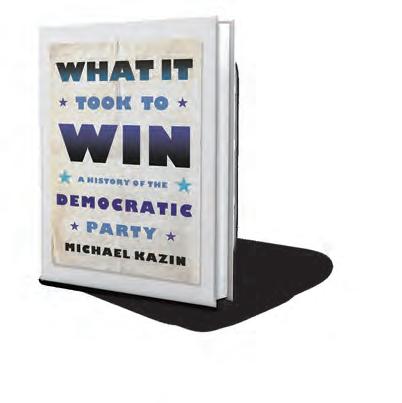 By Michael Kazin
Farrar, Strauss, and Giroux, 2022; $35
By Michael Kazin
Farrar, Strauss, and Giroux, 2022; $35
Reviews
Michael Kazin’s immediately indispensable new history of the Democratic Party succeeds on every imaginable front. A compelling blow-by-blow institutional biography of the country’s oldest mass political entity, What It Took to Win offers thoughtful and persuasive insights into the party’s social and political culture. Simultaneously portraying major fig ures and everyday people, Kazin describes in detail the ways in which the party has failed, major and minor, recently and in the distant past. Just as compellingly, he prescribes a his torically rooted path forward for a party that has been treading electoral water for half a century. Most significantly, Kazin writes in the voice of that rare contemporary histo rian who believes institutions genuinely shape events. Few institutions, Kazin demon strates, have formed the country more than the Democratic Party.
Kazin synthesizes two generations’ worth of scholarship to interrogate the White supremacy baked into the party’s 19th-cen tury origins. The anti-monopolism of the
party of Jefferson and Jackson clearly coexisted with a vision of racial hegemony that pitted the party’s original contingent of White farmers and artisans against potential allies among African American workers. In the book’s most compelling chapter, “Cosmopolitans in Search of a New Majority,” Kazin shows how slight, electorally and legislatively, the dividends of the Democrats’ chumminess with Silicon Valley types have been. The Democrats have won over many new Ameri cans or previously marginalized groups, but the party ’s reach exceeds its grip, particularly on White working- and middle-class Americans, especially men. The result has been a party with an educated elite and several smaller bases but lacking a broad vision articulable to voters who were neither professionals nor members of the “ethnocultural mélange” that has become so strongly associated with the party.
Writing as a lifelong Democrat in the wake of Donald Trump’s 2016 election, Kazin calls for a reawakening of the big-tent economic populism that made the Democrats a longstanding major ity party both in the Jacksonian period and in the era of the New Deal coalition. To reclaim that
BETTMANN/GETTY IMAGES
AMERICAN HISTORY66
Wandering in the Windy City
As the Democrats convened in Chicago Stadium on June 28, 1932, delegates and guests milled on the concourse.
AMHP-230100-REVIEWS.indd 66 9/28/22 7:55 AM
status, the Democrats must win over voters who see an economic system that is not working for them—not by embracing socialism but by pre senting a brand of capitalism that gives the dis enfranchised a fair shake. The only ranks of the party ’s existing base that this vision may not delight reside in the republic of Big Tech. Kazin is far from the first observer to make this point. Organized labor’s latter-day reinvigoration and Social Democrat Bernie Sanders’s popularity with much of the country’s traditional industrial base in the 2016 and 2020 primaries suggest this may be in the offing.
Kazin’s contribution is to situate his insight within the organization’s larger story and trace that awareness to the Democratic Party’s origins. —Clayton Trutor, a regular contributor, teaches History at Norwich University in Northfield, Ver mont. His book Loserville: How Professional Sports Remade Atlanta and Atlanta Remade Pro fessional Sports is available now from the Univer sity of Nebraska Press.
Wheel Whirl
Even if you don’t bicycle, chances are you have traversed one of the 2,295 rail trails stretching 25,000 miles nationwide. Strolled New York City’s High Line? That’s a rail trail. In The Mak ing of America’s Active Transportation Network, Rails-to-Trails Conservancy co-founder Peter Harnik expertly guides readers down the twisted path connecting the Age of Rail and the Age of Pedal. Non-cyclists will find ample material of interest in his brisk 238-page narrative, which starts in the 1800s with the history of railroad, interurban, and trolley systems. This tangled tale involved classic Robber Baron behavior as private companies, enabled by massive federal land grants, built competing lines to haul freight and passengers, sometimes practically within sight of each other. Brushing aside brief chal lenges from canal systems like the Erie and the Chesapeake & Ohio, rails soon ruled the national transportation roost. One measure: in 1888, trains moved some 6.5 billion pieces of mail over 126,000 miles of railway.
The rail system’s chronic inefficiencies led to massive mergers and consolidation. Harnik pegs the height of railroading as 1916, by which year lines already were slashing redundant trackage. A fin de siècle bicycling boom, which had gotten rolling with high-wheelers and grew in popularity with the Columbia Safety Bicycle, had already come and gone the way of handlebar mustaches. Unconsciously obeying the law of unintended consequences, cycling lobbyists launched the Good Roads Movement, which literally paved the way for motor vehicles and demoted the bicycle to a toy kids rode to school and goofed around on,
except when pedaling to deliver newspapers.
Rail clung to its dominance as a means of per sonal travel and freight lugging—along with a shred of its glamour—until the 1950s, when airlin ers and interstate highways largely supplanted trains. Railroading, still a $70-billion-a-year industry, hardly disappeared, but nationwide between 1916 and 2010 rail companies abandoned 54.4 percent, or 138,694 miles, of extant track and the bands of land those tracks occupied.

The 1960s saw fitness and environmentalism begin to come into vogue. Bicycling enjoyed a comeback among adults that deepened and accel erated amid the 1970s gas crises. While the rise of the Schwinn Varsity as the preferred campus vehicle did not lead directly to the rails-to-trails movement, cycling’s popularity suggested a rena scence for rust-ridden rail corridors.
A Washington insider in environmental policy, Harnik excels at interweaving many disparate political strands, from grassroots activism to Congressional sausage-grinding, into a cohesive narrative. Deals were cut, enabling legislation reinterpreted with muscular imagination, oppo sition from rail buffs thwarted or co-opted, names named, sausage made.
Harnik’s sweep through this lane of American transportation, industry, and politics will engage the most sedentary. Buffs will geek out on the dozens of charts, maps, and tables. My favorite: selected railroad nicknames, such as the Lake Erie & Western—“Leave Early and Walk.” —Boul der, Colorado-based Michael Leccese has written and edited books on cycling and urban planning. He has effectively bicycled to the moon, logging 250,000-plus miles touring, commuting, making day trips, running errands, and towing his Austra lian shepherd, Piper, in a bike trailer.
Freedom Warped
Black and White children as schoolmates. A Black sergeant assigned to command over 70 mostly White soldiers. Black clergymen leading mixedrace congregations. Skilled Black craftsmen highly respected by White members of their com munities. Do these citations sound like examples of the progress America has made in overcoming racism? They’re actually examples of life in the early 19th-century South
If critics and admirers of the Old South agree on one thing it’s that Civil War-era attitudes toward slavery and race were grounded in long-standing tradition. Admirers claim that that tradition blinded otherwise decent people. Crit ics see evidence of a thoroughly corrupt society. Shadow unmasks a different reality.
Slavery and racism existed from early days in colonial America, but a certain fluidity character ized these phenomena for over two centuries
The Making of America’s Active Transportation Network
By Peter Harnik
University of Nebraska, 2021; $19.95
Beyond Slavery’s Shadow: Free People of Color in the South
 by Warren Eugene Milteer
by Warren Eugene Milteer
University of North Carolina Press, 2021; $95
BETTMANN/GETTY IMAGES WINTER 2023 67
AMHP-230100-REVIEWS.indd 67 9/28/22 3:04 PM
The Abyss: The Cuban Missile Crisis 1962
By Max Hastings HarperCollins, 2022; $35

before attitudes hardened. At first slaves could own property, sometimes earning enough by hir ing themselves to buy their freedom. Some free Blacks were aristocrats, even slaveowners. Whites commonly accepted free Blacks of their own class as at least more or less equals. Believers in “racial superiority” didn’t necessarily treat that con struct as a White/non-White issue. Some persons of Anglo- Saxon ancestry considered themselves superior to White people from other origins.
Such a mix of attitudes typified the revolution ary era and the republic’s early days. Many on both sides of the Mason-Dixon Line favored grad ually ending slavery. Newer, extreme views gained credence among southerners in the 1820s. “Scien tific racism” replaced unthinking prejudice, with adherents claiming to be able to perceive a strict biological hierarchy among races. This “scien tific” mode of analysis would affect the status of people with one Black great-grandparent in ways the older view never did. Slavery came to be seen as a great good—not merely “acceptable” or a way to avoid something worse.
So while abolitionism bloomed and grew in the North, the South began codifying the slave system in terms stricter than ever while moving toward a subjugation of the region’s 250,000 free Black res idents that culminated in Jim Crow. Shadow tells how those free southern Blacks survived and fought back, aided by White neighbors opposed to the new policies. This fascinating story shows that early America was more benign—and the antebellum south more sinister—than generally realized. —James Baresel is a freelance writer in Annandale, Virginia.
Armageddon Time
Sixty Octobers ago, a quailing world stood at the verge of ending not with a whimper but a bang— actually, more than a few bangs, and very large bangs at that, courtesy of the nuclear warheads on missiles poised for launching by the United States of America and the Union of Soviet Socialist Republics, not necessarily in that order. The ele vator pitch: earlier that year the USSR, intent on evening the odds posed by an overwhelmingly more powerful American armamentarium, had smuggled a raft of rockets and nuclear warheads and accompanying materiél, aircraft, vehicles, and equipment, plus 43,000 Red Army personnel, into revolutionary Cuba. The hijinks that ensued when the Americans realized what was up spawned a nerve-wracking standoff of nearly two weeks’ duration, featuring a naval quarantine and talk of first strikes and mutually assured destruc tion until Premier Nikita Khrushchev did as Pres ident John Kennedy demanded and hauled his hardware home, caroming the superpowers toward talks on arms limitation. In The Abyss,
prolific and skilled historian Max Hastings brings alive that much-told and ever-sobering tale with élan and immediacy, constructing a gripping, multifaceted tick-tock that gets under way well before those 13 notorious days and reaches well past the confrontation’s conclusion, extracting current-day lessons aplenty.
The Cuban missile crisis has never wanted for chronicling and re-chronicling, whether en pas sant in volumes about the Cold War and the ’60s at large or front and center in histories of the event itself, especially as time has done its work and official documents have leached from under lock and key, and private papers, memoirs, dia ries, and other sources have come to light. In 2021 Harvard historian Serhii Plokhy, having made brilliant use of improved access to Soviet-era Russian archives, delivered the terrific Nuclear Folly: A New History of the Cuban Missile Crisis (www.historynet.com/nuclear-folly-reviewwhen-the-superpowers-nearly-started-worldwar-iii/), which yanked readers into the vortex for an intimate, horrifying ride. Now Hastings, his research handicapped by the pandemic but game as ever, takes his innings, swings for the fences, and connects with a version that operates on a broader, deeper, and equally satisfying scale.
Appropriately for a Briton, Hastings, like a crack bowman, nocks his arrowing prose and lets fly a long and richly fascinating shot. He begins Abyss with a Cold War timeline and dramatis personae of players American, Soviet, and Cuban, then thumbnails the clown-car U.S. Central Intel ligence Agency-run “invasion” of Cuba in April 1961 that ushered President John F. Kennedy into the realm of reality after all his tough campaign talk regarding missile gaps and softness on com munism. JFK soon would be grasping what it really meant to “oppose any foe.”
By way of context Hastings addresses Cuba’s centuries beneath Spanish rule and subsequent neocolonial existence under its northern neigh bor’s thumb, personified by the 45 square miles of Cuba given over by treaty to an American mili tary base at Guantánamo. American influence germinated the dictatorship of Fulgencio Batista, whose excesses triggered the 1959 revolution that Fidel Castro and his bearded legions wrought. Briefly the apple of the American eye— no less than TV variety show host Ed Sullivan hugged him on camera one Sunday night—Castro abruptly turned sharp left, nationalizing Ameri can businesses and cozying up to the USSR. In no time the United States was trying to bring down, even kill Castro and destroy his regime, propel ling the Cuban further into the Soviet sphere, a transition the Bay of Pigs completed. Now Fidel feared a full-bore American invasion and called for Soviet muscle to defend against it.
AMERICAN HISTORY68
AMHP-230100-REVIEWS.indd 68 9/28/22 2:56 PM














Learn more at groveatlantic.com “A fluent read of a major artist’s evolution . . . readers who crave a great story of American culture will devour.” —Wall Street Journal | Now in Paperback The first full and authoritative biography of American legend B.B. King AMHP-221101-001 Grove Publishing King of the Bllues 1-2Horiz.indd 1 9/28/22 1:25 PM ChartyourCoursetoexperiencethe unexpecteddiscoveriesinandaroundAlliance, Nebraskawherethereishistoryateveryturn. Fromscenicdrives,toourlocalbrewery, remarkableparks,richartandthelegendary Carhenge;youwillbetransportedtoanostalgic placewherequaintshopslineourhistoric downtownbrickpavedstreetsandfolksyou’ve nevermetwillsmileandwave.Ourhospitality andbeautyofourcitywillleaveyouwantingto comebackformore. Planyourgetawaynowbyvisiting www.visitalliance.com Veteran's Cemetery KnightMuseum& SandhillsCenter & SallowsMilitary Museum Dobby's Frontier AMHP-230100-REVIEWS.indd 69 9/28/22 1:49 PM
The Four Ages of American Foreign Policy: Weak Power, Great Power, Super power, Hyperpower
By Michael Mandelbaum
Oxford, 2022; $34.95
Castro’s demands exactly suited Soviet pre mier Nikita Khrushchev, who was spoiling for a confrontation. Riding high on his country ’s initial vaulting successes in space but secretly and pain fully aware of the Soviets’ distant secondary sta tus in the nuclear sweepstakes, Khrushchev was bristling. The Americans and their allies were refusing to bow to Russian insistence that they quit Berlin, since 1945 a divided city maintained as a knob of Western willfulness deliberately poked into East Germany.
By treaty the Americans had openly installed across Britain, Europe, and even in Turkey high-powered missiles able to nuke Russian cit ies. To tilt matters his way, Khrushchev decided to equip Cuba—on the sly—with nuclear-tipped mis siles and see how the Americans liked having the mortal tables turned.
Hastings foreshadows the actual undertaking with a rigorous chapter entitled “Mother Russia” delineating factors that induced Khrushchev to make his bold wager: Russia’s ingrained historical fear of invasion from the west, the profound and lingering consequences of Joseph Stalin’s rule and the Great Patriotic War, the Soviet state’s export of socialist revolution, the inevitable rivalry with the United States, the space race, the 1960 downing of an American U-2 spy plane over the Motherland, and multiple Berlin crises but especially Russia’s August 1961 installation of a wall to keep East Berliners red. The wall outraged the West by splitting the once and future German capital. Hastings brings to light previously well-hidden episodes of state violence visited upon dissenting Russians, as when residents of the Cossack city of Novocherkassk in June 1962 rioted over food shortages and labor grievances and for their obstinacy were massacred.
Against this helter-skelter backdrop, Khrush chev, painted by Hastings as an anxiety-ridden and mendacious butterball, opted to sneak a stash of nuclear mischief onto the newly reddened isle that the megalomaniacal Fidel Castro had been ruling for less than two years.
The premier’s goal: shock and amaze the Amer ican president. The younger man, whom Khrush chev thought a callow fellow, proved to have the steel and wisdom required to stand fast not only against his opposite number’s oafish bluster but that of his own military advisers and give Khrush chev the psychic elbow room to see reason. You may think you know the missile crisis story, but Hastings’s research and narrative skills will prove otherwise. His cinematic intercutting among scenes in Washington, Moscow, and Havana from the crisis that seemed about to end all crises will startle even the most deeply dedicated follower of Cold War history. If some streaming studio is not angling to option The Abyss for a dramatic series,
I’ll eat a jar of fallout shelter peanut butter. Michael Dolan is editor of American History.
Glory Days Gone By
In Four Ages, Michael Mandelbaum, Professor Emeritus of American Foreign Policy at Johns Hopkins, compellingly traces America’s ascent from rebel colonies to world power, concluding that we have peaked. American foreign policy, he stresses, has been unusually ideological, unusu ally economic, and unusually democratic. The nation tries, with spotty success, to spread its basic ideas: liberty, human rights, free elections. Even as a military power, the United States has emphasized trade, trade sanctions, and foreign investment. Public opinion remains a dominant influence, especially regarding war.

Before the Civil War a weakling, the country capitalized on the Atlantic Ocean and foes’ priori ties—Britain always worried more about France than the U.S.—such that by 1860 America had more wealth than most European nations. Civil war ushered the nation into the clique of great powers. By 1900 the world’s biggest economy, America helped win the Great War more with money and manufacturing than manpower. When World War II began, President Franklin Delano Roosevelt did what he could to support the Allies but it took the Japanese attack on Pearl Harbor to banish the public’s isolationism. By war’s end, America was an atomic superpower whose economy dwarfed all others.
WWII birthed a competing superpower. Hind sight shows the Soviets’ shambling economy to have been a fraction the size of America’s, but the massive Red Army and Marxist cant that world revolution would bury capitalism conjured a fac simile of a true rival.
The Cold War produced a few hot wars and much anxiety over nuclear Armageddon but ended with the 1991 Soviet breakup and America alone as a hyperpower.
America’s 1990s were deeply satisfying, but its 21st century has been a wreck. Terrorism, by nature a police matter, unhinged leaders who expanded our military and plunged into wars and quasi-wars worldwide.
Mandelbaum closes his narration in 2015, but his case still holds. The chaos after the 2016 elec tion and China’s relentless rise ended America’s splendid isolation. We may have the world’s larg est military—but we need it because our forces are spread globally
America the Hyperpower has become history. With four times the U.S. population and an econ omy vastly outmuscling the USSR’s, China seems reasonable in thinking to assume world leader ship within a decade or two. —Mike Oppenheim writes in Lexington, Kentucky.
AMERICAN HISTORY70
AMHP-230100-REVIEWS.indd 70 9/28/22 7:58 AM
STATEMENT OF OWNERSHIP, MANAGEMENT AND CIRCULA TION (required by Act of August 12, 1970: Section 3685, Title 39, United States Code). 1. American History 2. (ISSN: 10768866) 3. Filing date: 10/1/22. 4. Issue frequency: Quarterly. 5. Number of issues published annually: 4. 6. The annual sub scription price is $39.95. 7. Complete mailing address of known office of publication: HistoryNet, 901 N Glebe Rd, 5th Floor, Arlington, VA 22203. 8. Complete mailing address of headquar ters or general business office of publisher: HistoryNet, 901 N Glebe Rd, 5th Floor, Arlington, VA 22203. 9. Full names and complete mailing addresses of publisher, editor, and managing editor. Publisher, Michael A. Reinstein, HistoryNet, 901 N Glebe Rd, 5th Floor, Arlington, VA 22203, Editor, Michael Dolan, Histo ryNet, 901 N Glebe Rd, 5th Floor, Arlington, VA 22203 , Editor in Chief, Dana Shoaf, HistoryNet, 901 N Glebe Rd, 5th Floor, Ar lington, VA 22203. 10. Owner: HistoryNet; 901 N Glebe Rd, 5th Floor, Arlington, VA 22203. 11. Known bondholders, mortgages, and other security holders owning or holding 1 percent of more of total amount of bonds, mortgages or other securities: None. 12. Tax status: Has Not Changed During Preceding 12 Months. 13. Publisher title: American History. 14. Issue date for circula tion data below: Autumn 2022. 15. The extent and nature of cir culation: A. Total number of copies printed (Net press run). Av erage number of copies each issue during preceding 12 months: 30,194. Actual number of copies of single issue published nearest to filing date: 27,551. B. Paid circulation. 1. Mailed out side-county paid subscriptions. Average number of copies each issue during the preceding 12 months: 22,889. Actual number of copies of single issue published nearest to filing date: 20,752. 2. Mailed in-county paid subscriptions. Average number of cop ies each issue during the preceding 12 months: 0. Actual num ber of copies of single issue published nearest to filing date: 0. 3. Sales through dealers and carriers, street vendors and counter sales. Average number of copies each issue during the preceding 12 months: 1,379. Actual number of copies of single issue pub lished nearest to filing date: 1,348. 4. Paid distribution through other classes mailed through the USPS. Average number of cop ies each issue during the preceding 12 months: 0. Actual num ber of copies of single issue published nearest to filing date: 0. C. Total paid distribution. Average number of copies each issue during preceding 12 months: 24,268. Actual number of copies of single issue published nearest to filing date; 22,100. D. Free or nominal rate distribution (by mail and outside mail). 1. Free or nominal Outside-County. Average number of copies each issue during the preceding 12 months: 0. Number of copies of single issue published nearest to filing date: 0. 2. Free or nominal rate in-county copies. Average number of copies each issue during the preceding 12 months: 0. Number of copies of single issue published nearest to filing date: 0. 3. Free or nominal rate copies mailed at other Classes through the USPS. Average number of copies each issue during preceding 12 months: 0. Number of copies of single issue published nearest to filing date: 0. 4. Free or nominal rate distribution outside the mail. Average number of copies each issue during preceding 12 months: 624. Number of copies of single issue published nearest to filing date: 470. E. Total free or nominal rate distribution. Average number of copies each issue during preceding 12 months: 624. Actual number of copies of single issue published nearest to filing date: 470. F. Total free distribution (sum of 15c and 15e). Average number of copies each issue during preceding 12 months: 24,892. Actual number of copies of single issue published nearest to filing date: 22,570. G. Copies not Distributed. Average number of copies each issue during preceding 12 months: 5,302. Actual number of copies of single issue published nearest to filing date: 4,980. H. Total (sum of 15f and 15g). Average number of copies each issue during preceding 12 months: 30,194. Actual number of copies of single issue published nearest to filing: 27,550. I. Per cent paid. Average percent of copies paid for the preceding 12 months: 97.5% Actual percent of copies paid for the preced ing 12 months: 97.9% 16. Electronic Copy Circulation: A. Paid Electronic Copies. Average number of copies each issue during preceding 12 months: 0. Actual number of copies of single issue published nearest to filing date: 0. B. Total Paid Print Copies (Line 15c)
+ Paid Electronic Copies (Line 16a). Average num ber of copies each issue during preceding 12 months: 24,268. Actual number of copies of single issue published nearest to filing date: 22,100. C. Total Print Distribution (Line 15f) + Paid Electronic Copies (Line 16a). Average number of copies each issue during preceding 12 months: 24,892. Actual number of copies of single issue published nearest to filing date: 22,570. D. Percent Paid (Both Print & Electronic Copies) (16b divided by 16c x 100). Average number of copies each issue during preced ing 12 months: 97.5%. Actual number of copies of single issue published nearest to filing date: 97.9%. I certify that 50% of all distributed copies (electronic and print) are paid above nominal price: Yes. Report circulation on PS Form 3526-X worksheet 17. Publication of statement of ownership will be printed in the Winter 2022 issue of the publication. 18. Signature and title of editor, publisher, business manager, or owner: Kelly Facer, SVP, Revenue Operations. I certify that all information furnished on this form is true and complete. I understand that anyone who furnishes false or misleading information on this form or who omits material or information requested on the form may be subject to criminal sanction and civil actions. Sign up for our free weekly E-NEWSLETTER at historynet.com/newsletters HISTORYNET AMHP-221101-004 Ship Index.indd 1 AMHP-230100-REVIEWS.indd 71 9/28/22 7:58 AM
Taos Tale
Taos, New Mexico, got its name from a phrase in the indigenous Tiwa language meaning “place of the red wil lows.” In 1540, Spanish explorers searching for the fabled “Seven Cities of Gold” came upon Taos Pueblo (above), a cluster of adobe dwellings, some five stories tall, that have housed the Tiwa for more than 1,100 years and constitute the oldest continu ously inhabited community in the United States. Follow ing Spanish conquest, a settlement grew; the mission church of St. Francis of Assisi still stands. At first amicable, relations between the Spanish and Natives deteriorated, leading to a 1680 revolt and continuing tensions. Adobe fortifica tions erected at the town’s center in 1796 are now known as Taos Plaza. American acquisi tion of New Mexico in 1847 triggered another insurrection at Taos. The region achieved territorial status in 1850, with Taos becoming known as the home of western scout Kit Car son. At the turn of the 19th century the town’s blend of native pageantry and Spanish tradi tion began attracting artists and writers, including D.H. Lawrence, Willa Cather, and Georgia O’Keeffe. Taos remains a vibrant center of creative expression and cultural diver sity (taosgov.com). —Deborah Archuleta-Moreno writes in Roswell, New Mexico.

American Place
Resident Artist Georgia O’Keeffe (inset) was a prominent member of the 20th-century arts colony that emerged around Taos, which began as an indigenous pueblo whose construction long predated the arrival of Europeans in the Southwest.

LIBRARY OF CONGRESS; TONY VACCARO/GETTY IMAGES An
AMERICAN HISTORY72
AMHP-230100-AMERICAN-PLACE.indd 72 9/26/22 9:49 AM




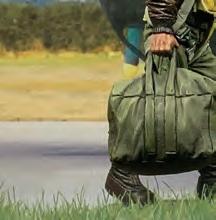















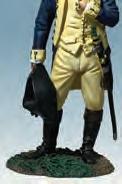


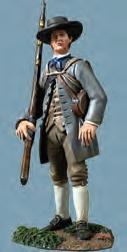





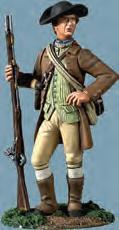
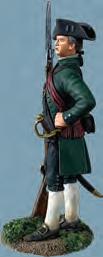






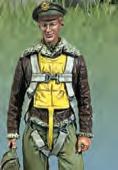







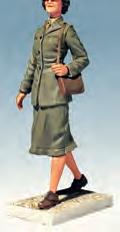















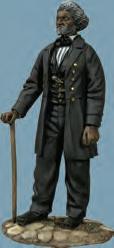




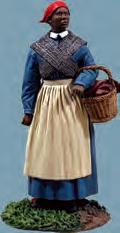
WBHN FALL 2022 ©2022 W.Britain Model Figures W.Britain, and are registered trademarks of the W.Britain Model Figures, Chillicothe, OH Follow us on Facebook: W-Britain-Toy-SoldierModel-Figure-Company Subscribe to us on YouTube: W.Britain Model Figures See our complete collection of 1/30 scale W.Britain historical metal figures at: Tel: U.S. 740-702-1803 • wbritain.com • Tel: U.K. (0)800 086 9123 Each one of our 1:30 scale metal figures is painstakingly researched for historical accuracy and detail. The originals are hand sculpted by our talented artists before being cast in metal and hand painted – making each figure a gem of hand-crafted history. Please visit wbritain.com to see all these figures and more from many other historical eras. matte finish Hand-Painted Pewter Figures 56/58 mm-1/30 Scale 10081 U.S. General Dwight D. Eisenhower, WWII $45.00 10076 U.S.A.A.F. Bombardier England, 1943-45 $45.00 10077 U.S.A.A.F. Navigator England, 1943-45 $45.00 10078 U.S.A.A.F. Bomber Captain, England, 1943-45 $45.00 10059 Rosie the Riveter, 1941-45 $45.00 13030 U.S.M.C. Women’s Reserve, 1941-45 $45.00 13054 U.S. Marine in Dress Blues, Post WWII $45.00 10060 Alexander Hamilton, 1783 $45.00 10062 Marquis de Lafayette 1783 $45.00 10074 George Washington, 1780-83 $45.00 16105 Don Troiani’s Art of War: American Militiaman, 1775-81 $48.00 16103 Washington’s Bodyguard Drummer $48.00 16106 Don Troiani’s Art of War: American Militiaman, 1775-81 $48.00 16107 Don Troiani’s Art of War: Major John Buttrick, 1775 $48.00 10061 Thomas Jefferson $45.00 13053 U.S. Sailor in Whites, 1941-45 $45.00 War: © W.Britain 51072 $7.50 B-24 Liberator of the Mighty 8th 8.5x5.5" backdrop card 10085 Frederick Douglass American Abolitionist and Social Reformer $45.00 10086 Sergeant Major Lewis Douglass, 54th Mass. Infantry, $45.0010088 Harriet Tubman American Abolitionist $45.00 10087 General Rochambeau, 1783 $45.00 AMHP-221101-007 Wbritain.indd 1 9/27/22 1:31 PM

REVOLUTIONARY WAR: ROAD TO YORKTOWN Travel with us September 24-October 3, 2023! A TOUR YOU WON’T FORGET! Travel from Charleston, SC to Yorktown, VA as you explore the final days of this epic American conflict, the battles that raged across the southern theater and the key players in that drama. Or join us for our Revolutionary War: Boston to Quebec tour, where you can walk battlefields where ragtag rebel forces clashed with one of the most feared armies in the world. Our American History, Civil War and WWII tours are unrivaled in their historical accuracy! EXPLORE NOW AT STEPHENAMBROSETOURS.COM 1.888.903.3329 AMHP-221101-008 Stephen Ambrose .indd 1 9/22/22 12:30 PM


































 58 Walter White parlayed brash confidence and light skin tone into years of exposing the American plague of lynching.
58 Walter White parlayed brash confidence and light skin tone into years of exposing the American plague of lynching.


 By J.
By J.













 by Sarah Richardson
by Sarah Richardson

























 Paul Fronckowiak Buffalo, New York
Paul Fronckowiak Buffalo, New York
































 By Daniel de Visé
By Daniel de Visé





























































 By Peter Carlson
By Peter Carlson















 By Michael Kazin
Farrar, Strauss, and Giroux, 2022; $35
By Michael Kazin
Farrar, Strauss, and Giroux, 2022; $35

 by Warren Eugene Milteer
by Warren Eugene Milteer























































